Abstract
This study reviews the role of epidemiology in the United States in the late 19th and early 20th century, which led to recognition that poliomyelitis is an infectious disease and set the stage for subsequent developments in virology and immunology, the development of inactivated and live attenuated polio vaccines, and a dramatic worldwide decrease in poliomyelitis mortality and morbidity. Epidemiological studies in the United States were systematically reviewed from the mid-19th to early 20th centuries. Isolated cases and scattered small outbreaks of poliomyelitis in the mid-19th century led to epidemics of increasing size by the end of the century, causing public consternation, especially as the disease was considered “new” and had a predilection for young children. By the 1890s, the seasonal pattern of epidemics suggested that poliomyelitis might have an infectious etiology, but direct evidence of communicability or contagiousness was lacking, so an infectious etiology was not widely suspected until the early 20th century. Reports of bacterial isolations from spinal fluid and postmortem tissues suggested that poliomyelitis might be a bacterial disease, and simultaneous outbreaks of paralytic disease in humans and animals suggested a possible zoonotic basis. Although experimental studies showed that it was theoretically possible for flies to serve as vectors of poliovirus, and occasional cases of polio were likely caused by fly-borne transfer of poliovirus from human feces to human food, a fly abatement field trial showed convincingly that flies, whether biting or non-biting, could not explain the bulk of cases during polio epidemics. In conclusion, the early application of epidemiological evidence beginning in the late 19th century strongly suggested the infectious nature of the disease, distinct from previously identified conditions. Subsequent advances in virology and immunology from 1909 to 1954 proved that poliomyelitis was a viral disease with no natural animal host and made feasible the development of an inactivated trivalent poliovirus vaccine by Salk, and, subsequently, a live-attenuated trivalent poliovirus vaccine by Sabin.
Keywords:
poliomyelitis; epidemiology; history of medicine; bacteriology; virology; immunology; zoonosis; vector; poliovirus 1. Introduction
This review considers the emerging epidemiologic evidence from the mid-19th century to the beginning of the 20th century, which led to recognition in the United States that poliomyelitis is an infectious disease.
Isolated cases and small, geographically isolated outbreaks of probable poliomyelitis (“infantile paralysis”) were reported during the 18th and early 19th centuries [1]. These early cases were sufficiently characteristic to enable recognition of the disorder and to allow descriptions of typical clinical features but left those studying it puzzled concerning its etiology. Because poliomyelitis did not show a clear pattern of communicability, an infectious etiology was not suspected.
By the end of the 19th century, epidemics of increasing size caused increasing public consternation, especially as the disease was considered “new” and had a predilection for young children. By the 1890s, the seasonal pattern of the epidemics suggested to multiple investigators that poliomyelitis might be infectious, but several factors confounded this growing consensus, and at the time there was certainly no proof of this idea. The late 19th-century outbreaks and epidemics of poliomyelitis provided a much clearer understanding of the clinical phenomenology of poliomyelitis, provided the beginnings of clinical–pathological correlation, allowed for the separation of poliomyelitis from other myelopathies and other disorders causing acute or subacute weakness, and produced a rapid expansion in orthotic technologies and orthopedic surgeries to alleviate the resulting disabilities and deformities [2,3,4]. However, the contagiousness of poliomyelitis had long remained an open and contentious question, with inconclusive evidence of communicability even among those residing in close proximity (e.g., within families). In trying to elaborate an infectious theory of poliomyelitis, several misleading reports in the last decade of the 19th century led to consideration of whether poliomyelitis is a bacterial disease and whether it might be transmitted from animals to man—a zoonosis.
By the second decade of the 20th century, poliomyelitis was shown to be a viral disease [5,6], and the various putative bacterial causes were recognized to be merely contaminants. The early 20th century also saw the advent of the vector theory of poliomyelitis transmission, with increasing awareness that the poliovirus is excreted in feces, that poliovirus can be detected in sewage and in flies, and that flies can transmit poliomyelitis under experimental conditions. The vector-borne theory of poliomyelitis was abandoned by the mid-20th century after fly abatement field trials proved ineffective in modifying the course of poliomyelitis epidemics, but the zoonotic theory was not fully disproved until the latter half of the 20th century.
2. Early Sporadic Cases and Outbreaks
Beginning in the mid-1830s and 1840s, small outbreaks of childhood paralysis began to be reported, first by John Badham who described a cluster of four cases in young children in the midland town of Worksop, England, in 1835 [7], and then in the United States by George Colmer (1807–1878) (Figure 1). Colmer was born in London, received his MD degree from the Medical College of Louisiana in 1838, and then practiced in Springfield, Louisiana, until his death. His cursory notice of an outbreak of childhood paralysis among infants and toddlers in West Feliciana, Louisiana, during the summer and fall of 1841, was entitled “Paralysis in teething children.” Colmer’s report amounted to only a paragraph in which he described a paralytic outbreak in children that is recognizable in retrospect as poliomyelitis [8,9]:

Figure 1.
Louisiana physician George Colmer (1807–1878). Colmer briefly described an outbreak of poliomyelitis, which occurred in 1841 in West Feliciana, Louisiana, the first such outbreak in the world. Reprinted from [9] with permission of Wolters Kluwer Health, Inc. License number 6074351241461. The image has been cropped from the original.
While on a visit… my attention was called to a child about a year old, then slowly recovering from an attack of hemiplegia. The parents, (who were people of intelligence and unquestionable veracity,) told me that eight or ten other cases of either hemiplegia or paraplegia, had occurred during the preceding three or four months within a few miles of their residence, all of which had either completely recovered, or were decidedly improving. The little sufferers were invariably under two years of age, and the cause seemed to be the same in all—namely, teething.[8] (p. 248)
Colmer’s report was not recognized until much later, but then it was repeatedly cited, especially in the early years of the 20th century [10,11,12,13,14,15,16,17,18]. Colmer did recognize poliomyelitis as a distinct entity, affecting teething children (ages 1–2), causing paralysis (with subsequent improvement or recovery in most), and occurring during the late summer and early fall in a small rural area.
German orthopedist Jakob Heine (1800–1879) had recognized poliomyelitis (infantile paralysis) as a sporadic clinical entity in 1840 [19], three years before Colmer’s report, though Colmer was apparently unaware of this [8]. From the time of Colmer’s report of though the 1860s, poliomyelitis (or infantile paralysis, as it was generally referred to in the United States at the time) was apparently mostly a sporadic condition that was seldom discussed in the American medical literature. Poliomyelitis has such a characteristic presentation that even modest outbreaks would not likely be overlooked (even if labeled as something else). Instead, it is now clear that poliomyelitis emerged as a significant epidemic disease during the late 19th and early 20th centuries, but a full appreciation and explanation for this was long delayed [20,21].
Beginning in the late 1860s, one of the first to investigate infantile paralysis in the United States was William Alexander Hammond (1828–1900) (Figure 2) of the College of Physicians and Surgeons in New York, who was then establishing himself as a neurologist after his humiliating though largely unjustified court-martial as Surgeon General of the Union Army during the U.S. Civil War [22,23,24,25,26,27,28]. From December 1865 to December 1870, Hammond treated 98 cases of “organic infantile paralysis” that were mostly consistent with poliomyelitis [26]. Using a Duchenne trocar, he obtained muscle biopsies and described the progressive secondary degenerative changes in the muscles of affected patients [24,26]. Despite Hammond’s relative wealth of clinical experience with this disorder for the time, he acknowledged his ignorance concerning its etiology in his textbook, A Treatise on Diseases of the Nervous System (1871)—the first textbook of neurology in the United States [28,29,30]:
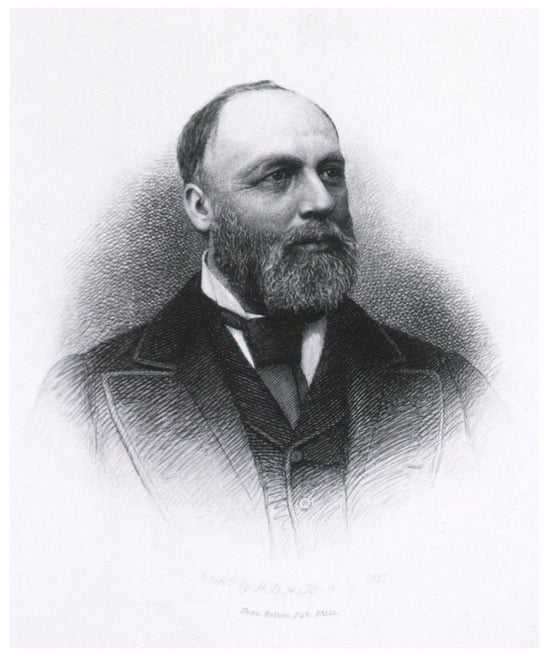
Figure 2.
New York neurologist and former U.S. Surgeon General William Alexander Hammond (1828–1900), c1877. In the late 1860s, Hammond was one of the first physicians in the United States to investigate infantile paralysis (poliomyelitis), and he identified progressive secondary degenerative changes in muscle biopsies after onset of the disease. Hammond acknowledged his ignorance of the cause of the disorder. Etching by E.B. Hall. Courtesy of the US National Library of Medicine [31] (public domain).
Little is known of the etiology of organic infantile paralysis. … In the great majority of the cases that have come under my observation, no cause could be reasonably assigned.[26] (p. 691)
On 8 November 1873, in a lecture at the College of Physicians and Surgeons in New York City, New York neurologist Edward Constant Séguin (1843–1896) (Figure 3) gave a clear and concise clinical-pathological description of the disease, based on anecdotal case reports and small case series from the limited number of prior outbreaks [32,33,34]. He also indicated (by the inserted question marks) aspects of the pathogenesis, which he suspected were true, but which had not been proven.

Figure 3.
Edward Constant Seguin (1843–1896). Reprinted from Ref. [33] (public domain).
In brief, infantile spinal paralysis may be defined as an acute febrile affection, resulting in generalized paralysis, which shortly disappears from all but a limited part of the body, where akinesis [i.e., lack of movement due to weakness] persists indefinitely without impairment of sensibility, is accompanied within a few weeks by atrophy of the palsied muscles, and is followed later by various deformities,—the result of altered balance of power at certain joints. The anatomical lesion of the disease consists in primary (?) atrophy of the nerve-cells of the anterior horns of the spinal cord (motor tract), and in secondary (?), complicating (?) myelitis.[32] (p. 25)
3. Recognizing the Seasonality of Poliomyelitis
In 1875, in an article on “The palsies of children,” Philadelphia neurologist Wharton Sinkler (1845–1910) (Figure 4)—a protégé of pioneering Philadelphia neurologist S. Weir Mitchell (1829–1914) and a future President of the American Neurological Association (in 1891) [35]—was the first to recognize the seasonal pattern of poliomyelitis incidence: because only the season of onset for 13 of his 57 cases (23%) was known, these data are aggregated and presented by season [36] (Figure 5).
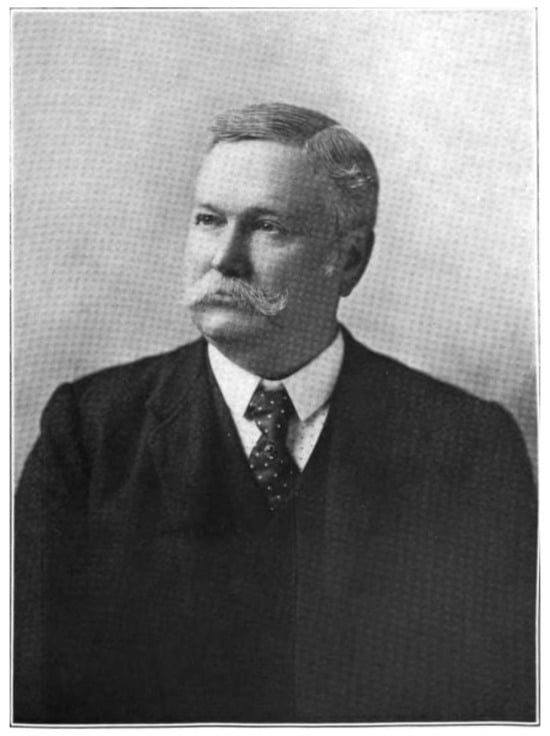
Figure 4.
Philadelphia neurologist Wharton Sinkler (1845–1910). In 1875, Sinkler was the first to recognize the seasonal pattern of poliomyelitis. Reprinted from Ref. [35] (public domain).

Figure 5.
The seasonal pattern of incident cases of poliomyelitis as described by Wharton Sinkler (1875) and James Jackson Putnam (1893). Data from Refs. [36,37].
I observed, two or three years ago, that many of our cases of infantile palsy were said to have been attacked in the summer months, and since then I have carefully noted the time of year when the paralysis came on in each patient. … [Forty] of the fifty-seven cases were affected in the summer months; and if we add the seven which took place in May and September, which are generally hot months in this city, we find that all but ten of the fifty-seven cases occurred in hot weather. This fact has not, to my knowledge, been remarked before, and seems to me to have much bearing upon the causation of the disease. At any rate, it is evident that hot weather must have a marked influence in predisposing to the affection.[36] (p. 353)
Sinkler noted an earlier report that suggested Sydenham’s chorea was seasonal, but he did not speculate on the pathophysiologic basis of either disorder or the reasons for the seasonality of disease incidence. Instead, he concluded regarding seasonal childhood paralysis that “Nothing is known of the exciting cause” [36] (p. 353).
Sinkler’s report was highly cited into at least the 1890s and influenced the thinking of later neurologists and epidemiologists who considered the etiology of poliomyelitis [37,38]. He revisited the seasonality of poliomyelitis in several later papers, analyzing cases at the Philadelphia Orthopedic Hospital and Infirmary for Nervous Diseases in 1890 (270 cases for which the month of onset was recorded, from a total of 350 cases; time period not provided), and again in 1908 (507 cases for which the month of onset was provided; total cases observed and exact time period covered were again not provided) [39,40,41].
In 1893, Boston neurologists James Jackson Putnam (1846–1918) (Figure 6), a founding member of the American Neurological Association, and Edward Wyllys Taylor (1836–1932) (Figure 7) acknowledged Sinkler’s earlier recognition that poliomyelitis is “pre-eminently a disease of the summer months of the year” [38,42,43,44,45,46]. Putnam and Taylor analyzed cases from the Massachusetts General Hospital and noted “with the exception that, so far as the small aggregate of numbers prove[s] anything, they show that among us there is a greater prevalence of the dreaded affection in September than in August [38] (Figure 5). In the same report, Putnam and Taylor reported a concerning increase in the incidence of poliomyelitis from the prior year, a finding that was consistent with the experience at the Massachusetts General Hospital, Boston’s Children’s Hospital, the Boston Dispensary, and private consultation practices over that interval [38]. They noted an increase from 6 cases from August to November 1892 to 20 cases in the same interval the following year [38].
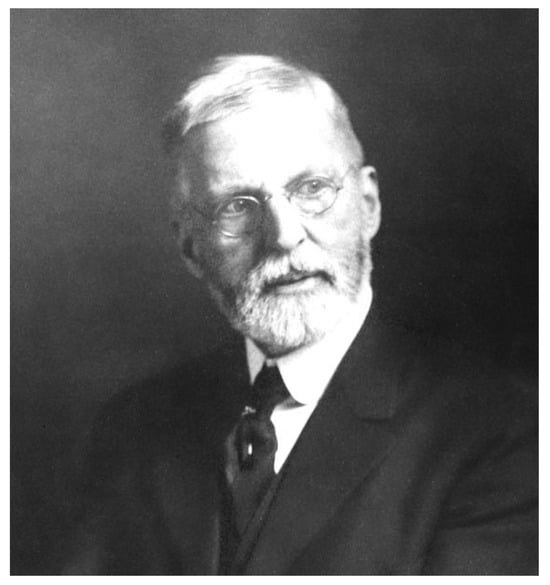
Figure 6.
Boston neurologist James Jackson Putnam (1846–1918), a founding member of the American Neurological Association. In 1893, with colleague Edward Wyllys Taylor, Putnam analyzed cases of poliomyelitis seen at the Massachusetts General Hospital, noting their seasonal pattern and a concerning significant increase from the prior year. Reprinted from [47] (public domain).
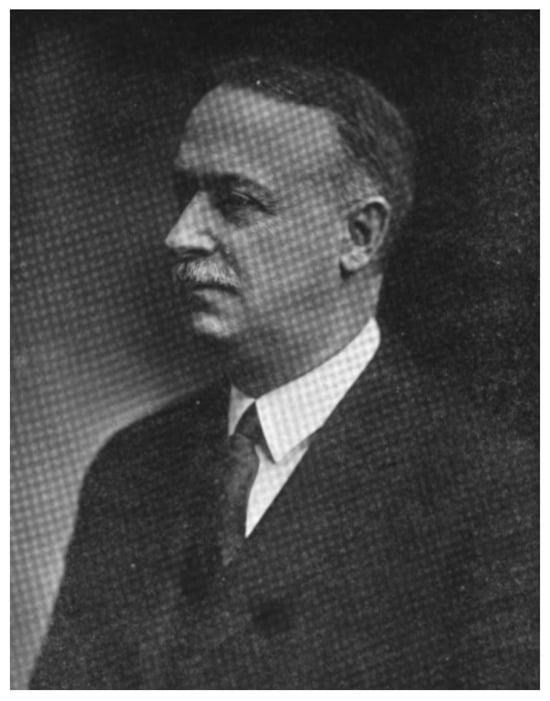
Figure 7.
Boston neurologist Edward Wyllys Taylor (1836–1932). Reprinted from Ref. [48] (public domain).
In addition to the reports by Sinkler [36,39,40,41], and the report by Putnam and Taylor [38], others in the United States and elsewhere collected case series that supported a seasonal pattern for poliomyelitis (Figure 8). Other fairly large case series that supported a seasonal pattern, which were not based on assessment of a single outbreak or epidemic, included confirmatory reports by the following individuals: (1) British physician William H. Barlow, Consulting Physician to the Dispensary, General Hospital, and Dispensary for Sick Children in Manchester, England, in 1878 (53 cases); (2) British neurologist William Richard Gowers (1845–1915) at the National Hospital for the Paralysed and Epileptic in London, England (70 cases); (3) New York neurologist Moses Allen Starr (1854–1932) from New York City (202 cases); and (4) Boston orthopedic surgeon Robert Williamson Lovett (1859–1924)—later famous as the physician who diagnosed Franklin Delano Roosevelt’s case of poliomyelitis in 1921 and for his work on the mechanics of the spine—with pediatrician William P. Lucas (1880–1961), at the Boston Children’s Hospital (239 cases) [49,50,51,52,53,54].
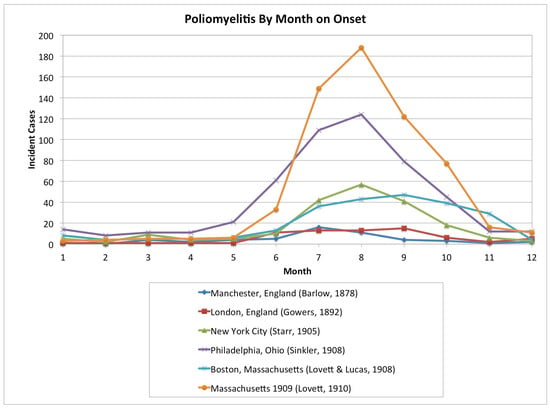
Figure 8.
Poliomyelitis cases by month of onset from several case series and from surveillance data for the state of Massachusetts for 1909. The various studies show a fairly consistent pattern of maximum poliomyelitis incidence in the late summer and early autumn. Graph by Douglas J. Lanska, MD, MS, MSPH. Data from Refs. [40,49,50,51,53,55].
4. The 1894 Vermont Polio Epidemic
The first significant epidemic of polio in the United States occurred in Vermont in 1894 and was reported in a series of publications by Charles Solomon Caverly (1856–1918) (Figure 9), President of the Vermont State Board of Health, and selected colleagues [56,57,58,59,60,61,62,63,64]. Initially, after soliciting input from physicians in the state, Caverly presented a preliminary report concerning 123 cases of “an acute nervous disease, which was almost invariably attended with some paralysis” [52] (p. 1). Cases began appearing in June in Rutland County, in a portion of the Otter Creek Valley. There was a “general feeling of uneasiness that was perceptible among the people in regard to the ‘new disease’ that was affecting the children” [56] (p. 1).
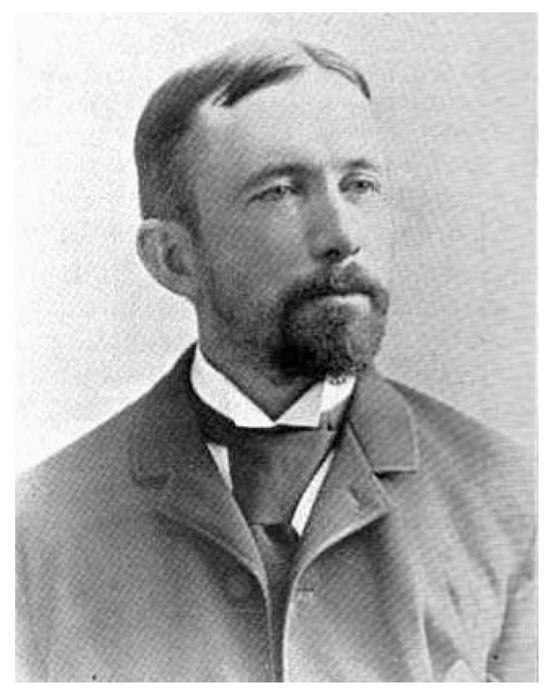
Figure 9.
Vermont public health physician Charles Solomon Caverly (1856–1918). In 1894, Caverly led the investigation and reporting of the then-largest epidemic of poliomyelitis in the world, affecting 132 people in Rutland County, Vermont. Reprinted from Ref. [61] (public domain).
In his initial preliminary report, Caverly raised two possible diagnostic possibilities: epidemic cerebro-spinal meningitis [now recognized as meningococcal meningitis] and acute poliomyelitis anterior [56].
The initial fever, followed in a few days by definite motor paralysis, of which a certain percentage recover in a few weeks, the rest suffering permanent impairment of some muscles, offers a fair picture of the average case of Poliomyelitis Anterior, while the high fever, muscular rigidity, and hyperaesthesia, are not characteristic of this disease. The season of the year, the absence of special sense symptoms, especially deafness, as a sequella in this epidemic, the low mortality, the absence of the very characteristic purpuric eruption, are strong arguments against the theory of Cerebro-Spinal Meningitis. It is now well established that the other disease, Poliomyelitis, is occasionally epidemic. Such epidemics have been noted in at least three instances in Europe, and one is reported by Putnam as occurring near Boston. The Stockholm epidemic [of 1887] reported by Medim [sic, Swedish pediatrician Karl Oscar Medin (1847–1927), who investigated an outbreak of 44 cases] is in many respects quire similar to the one which I have reported.[56] (p. 4)
In retrospect, on the strength of the evidence supplied by Caverly, the correct diagnosis was clearly poliomyelitis. However, as a public health physician, Caverly felt unsure of the diagnosis in these cases. He sought the advice of several clinical specialists, and perhaps predictably he received divergent opinions. New York pediatrician Abraham Jacobi (1830–1919) (Figure 10), a founder of pediatric medicine in the United States, opined without equivocation that it was epidemic cerebrospinal meningitis, while New York neurologists Moses Allen Starr (Figure 11) and Charles Loomis Dana (1852–1935) (Figure 12), both leading neurologists in the country at that time, correctly recognized this as poliomyelitis [65,66,67].
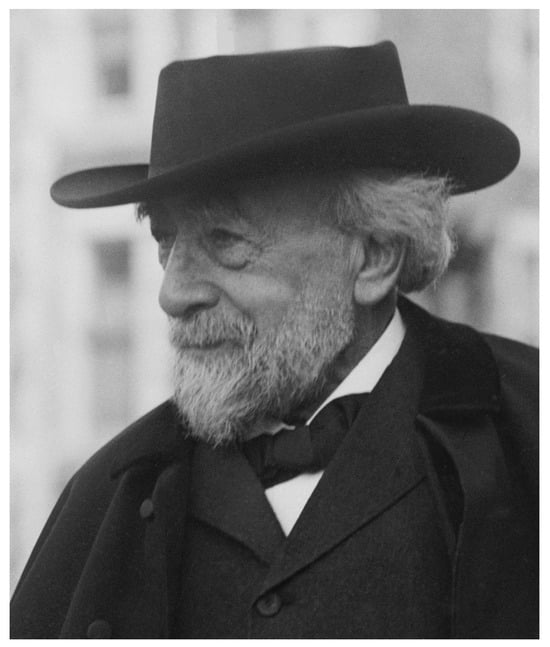
Figure 10.
New York pediatrician Abraham Jacobi (1830–1919). Jacobi was consulted concerning the 1894 epidemic of poliomyelitis in Rutland County, Vermont, but initially incorrectly diagnosed the causes as epidemic cerebro-spinal (meningococcal) meningitis. To his credit, he later corrected his diagnosis to poliomyelitis. Credit: George Grantham Bain Collection, Library of Congress Prints and Photographs Division, Washington, D.C. [68] (public domain).
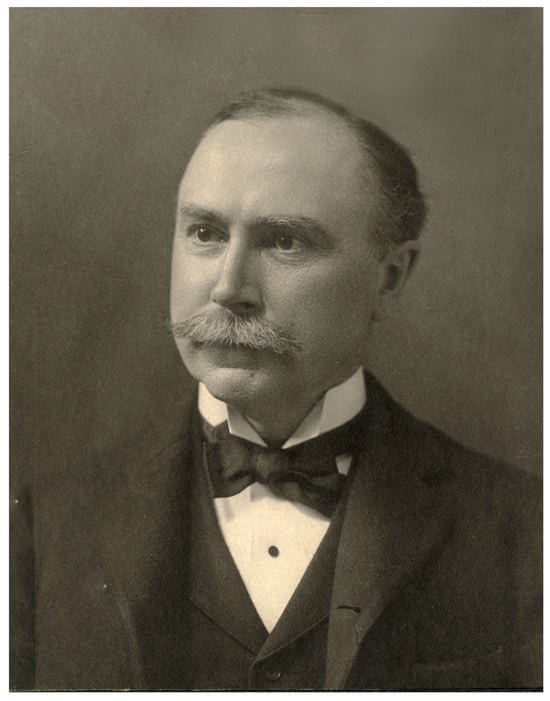
Figure 11.
New York neurologist Moses Allen Starr (1854–1932). Starr was consulted concerning the 1894 epidemic of poliomyelitis in Rutland County, Vermont, and correctly diagnosed the condition as poliomyelitis. Credit: Middlebury College Special Collections, Middlebury, Vermont [69].
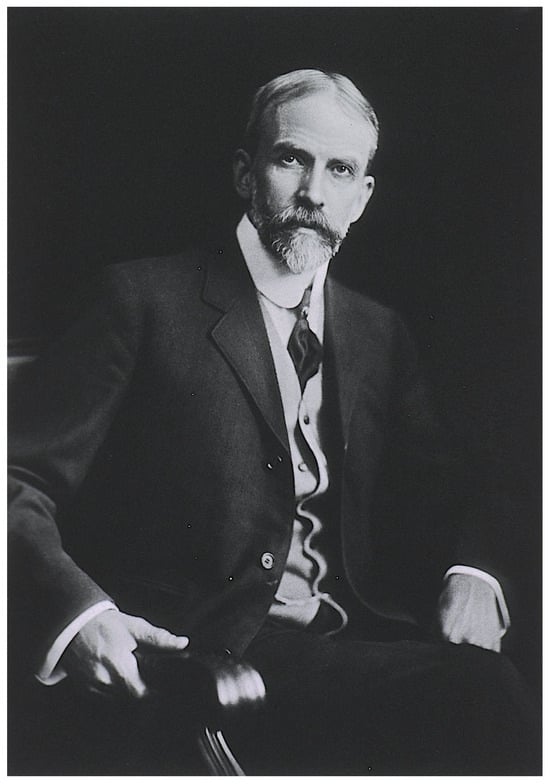
Figure 12.
New York neurologist Charles Loomis Dana (1852–1935). In 1892, Dana was among the first in the United States to suggest an infectious etiology for poliomyelitis. Dana was consulted concerning the 1894 epidemic of poliomyelitis in Rutland County, Vermont, and correctly diagnosed the condition as poliomyelitis. Courtesy of the U.S. National Library of Medicine [70] (public domain). Edited by Douglas J. Lanska, MD, MS, MSPH.
Jacobi, basing his impressions on written case descriptions provided by Caverly, replied with a firm conviction that the cases were affected by meningitis, even though he noted the unusual paralytic presentation of the cases and the very low mortality (if this had been, in fact, meningitis):
All your cases belong to the same class, cerebro-spinal meningitis. They prove that nature does not walk in ruts as most of our text-books do, and that transitions and variations are common. … The frequency of paralysis in your cases is something very uncommon; so is your low mortality; both prove that your cases were more spinal than cerebral.[57] (p. 675)
Starr replied with a mild amount of circumspection, but weighed in with a diagnosis of poliomyelitis:
The cases… would have all impressed me as cases of acute anterior poliomyelitis, without a doubt. The history does not appear to me to contradict this diagnosis, and while in some respects unusual … there is not as much difficulty in assigning them to anterior poliomyelitis as there is in assigning them to cerebo-spinal meningitis. Epidemics of anterior poliomyelitis are not unknown [though all prior reports were much smaller in magnitude].[57] (p. 675)
Dana replied more directly: “I can most positively state my opinion to be that your cases were mostly cases of anterior poliomyelitis” [56] (p. 5).
By November, Jacobi had received more detailed information on the cases from Starr (who had personally examined some of them); Jacobi then reconsidered his diagnosis, and to his credit revised his diagnosis to epidemic poliomyelitis [60].
With the input of his consultants, and in keeping with the growing consensus of medical opinion in the 1890s, Caverly initially concluded only that the disorder was an infectious disease that curiously had a low level of transmissibility:
It may be remarked that the microbic or infectious nature of the disease is generally believed in by us, whose opportunities for observing it have been merely clinical. … There is no evidence of its contagiousness, since it has affected almost invariably but a single member of a household.[56] (p. 5)
Caverly was initially unwilling to make a conclusive diagnosis of these cases and noted with obvious regret that, despite diligent efforts, no autopsies were obtained. Nevertheless, by his second report, he concluded that the epidemic was one of poliomyelitis:
[The] phenomena of this epidemic can be reconciled with a diagnosis of poliomyelitis. … A diagnosis of epidemic cerebro-spinal meningitis would certainly be more strained. The disease, cerebro-spinal meningitis, in epidemic form being more common, its symptoms and behavior are correspondingly better understood than poliomyelitis.[57] (p. 677)
With the facilitation of Caverly and surgeon Henry Haven Swift (1855–1926), Canadian pathologist [John] Andrew MacPhail (1864–1938), who was later knighted, studied records of a subset of 91 cases from this epidemic [59]. In this group, MacPhail found that 13% died, 32% did not improve, 30% improved partially, and 25% recovered fully. MacPhail could not see how fecal-oral transmission through the water supply could be possible, nor did it appear that the epidemic was vector-borne. Indeed, as Caverly had been, MacPhail was particularly struck by the physical separation of the cases:
It would be hard to discover a region in which a disorder had less license to become epidemic. The whole district in which these cases occurred lies upon a series of [mountainous] terraces, and increased safety did not come with elevation [which could potentially influence water-borne and vector-borne transmission]. Indeed, four cases occurred on the very ridge of the Green Mountains at an elevation of 1500 feet. The line of dwellings in which these patients lived extended over half a mile, and the water-supply was different in each of the four cases, namely, from springs out of the mountain.[59] (p. 623)
By the time of his final report on the 1894 epidemic, published in 1896, Caverly had identified 132 cases from that epidemic, of which there were 18 deaths (13.6%), a proportion very similar to that reported earlier (i.e., 13%) by MacPhail from a subset of the cases [58,59]. Caverly again revisited the issue of a possible infectious etiology for poliomyelitis, but he acknowledged that little progress had been made in establishing this as the etiology:
Thus far … there does not seem to have been any substantial progress made toward isolating any specific microorganism peculiar to this disease. Our epidemic with that of [Swedish pediatrician Karl Oscar] Medin [(1847–1927), who investigated an outbreak of 44 cases in 1887,] suggests, on purely clinical grounds, the possibility of such a cause.[58] (p. 5)
The issue of whether poliomyelitis was a form of epidemic cerebrospinal meningitis was revisited several times after the 1894 Vermont epidemic of poliomyelitis, but actual statistics that would support the clinical differentiation of these disorders had to await the formation of systematic surveillance systems for defined geographic areas, something that was only developing in some states after 1907.
5. Is Poliomyelitis a Bacterial Disease?
It was not long after the Vermont poliomyelitis epidemic (and, not coincidentally, shortly after the introduction of lumbar puncture) that bacterially contaminated spinal-fluid specimens were misinterpreted in patients with poliomyelitis [71,72,73,74]. German internist and surgeon Heinrich Irenaeus Quincke (1842–1922) had introduced the technique of lumbar puncture in 1891 [75], and, within a decade of Quincke’s report, bacteria were isolated from cerebrospinal fluid specimens, falsely suggesting bacteria as the causative agent of poliomyelitis. This was a time when numerous diseases (e.g., anthrax, tuberculosis, cholera, diphtheria, and typhoid fever) were found to be caused by bacteria, but before the first human disease was recognized to be caused by a filterable agent (i.e., yellow fever in 1901), so bacterial isolations were often assumed to be causal.
One of the first such mistakes was by Philadelphia neurologist Francis Xavier Dercum (1856–1931) (Figure 13), yet another protégé of S. Weir Mitchell [76], who on 23 October 1899, reported at a meeting of the Philadelphia Neurological Society that a diplococcus was observed in a Gram-stained specimen of spinal fluid from a two-year-old girl with poliomyelitis, although “Inoculations on glycerin agar and blood serum failed to show any growth after incubation for 48 h” [71] (p. 117). Dercum noted that Philadelphia neurosurgeon William Williams Keen (1837–1932) [77] had obtained the spinal fluid specimen by “Quincke puncture”.
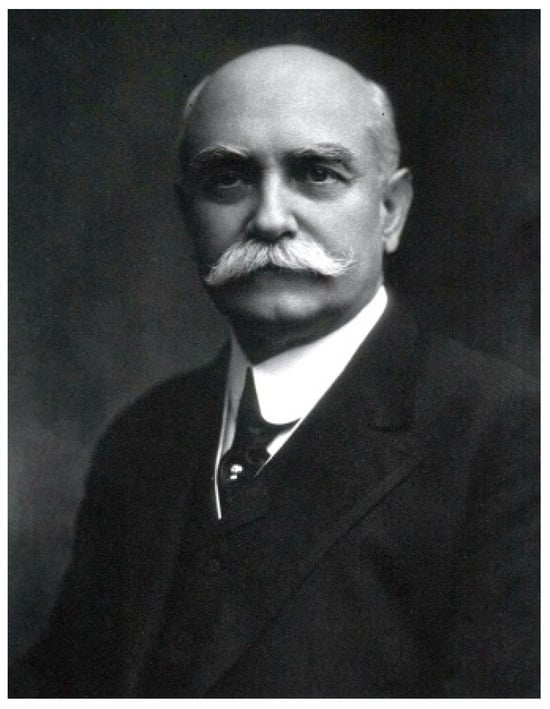
Figure 13.
Philadelphia neurologist Francis Xavier Dercum (1856–1931). In 1899, Dercum presented a misleading report of diplococci on a Gram-stained specimen of cerebrospinal fluid obtained by Quincke puncture (lumbar puncture) from a two-year-old girl with poliomyelitis. Courtesy of the U.S. National Library of Medicine [78] (public domain).
Many similar (and similarly misleading) reports soon came from around the world [12,72,73,74]. For example, in 1908, while discussing results of the poliomyelitis epidemic in New York City in 1907, Starr noted that among 20 cases in which spinal fluid was obtained, 15 cases were bacteriologically sterile, whereas 5 (25%) grew several different bacteria species, suggesting that these were contaminants rather than causal microorganisms [12]:
In one a white staphylococcus grew; in one a Gram-positive bacillus and in three a large, Gram-positive coccus appeared in tetrads and pairs within large groups. … The coccus was looked on as a contamination.[12] (p. 113)
Until the viral nature of poliomyelitis was demonstrated in late 1909, though, numerous explanations (or excuses) were suggested for the failure to identify the presumed bacterial organism on microscopic examination of stained spinal fluid or in histological preparations. For example, as C.W. Duval noted in a presentation to the Louisiana State Medical Society in 1909 [79]:
Smear preparations [of cerebrospinal fluid] have always been negative except where the disease was superimposed by another infection, for example, pneumococcal, strepto[coccal], etc. All sorts of special media have been employed, both anaerobically and aerobically. The failure to find organisms in smears, even in most pronounced forms of the disease, does not signify much—certainly nothing against bacterial infection. The organisms may be ultra-microscopic, or require special methods of staining—who knows? Think of the years we have missed the syphilitic spirochete because of faulty technique. Now that we know how to stain for it the matter is extremely easy. Many organisms have been isolated in cases of acute anterior poliomyelitis, and called the excitors [sic] of the disease, but the opinions are too much at variance to place credence in any one of them.”.[79] (p. 747)
In 1909, physician-scientist Simon Flexner (1863–1946) (Figure 14), Director of the Rockefeller Institute for Medical Research in New York City, summarized his extensive but unsuccessful efforts to identify a bacterial basis for poliomyelitis in either spontaneous human cases or experimental poliomyelitis in monkeys [6,80]:
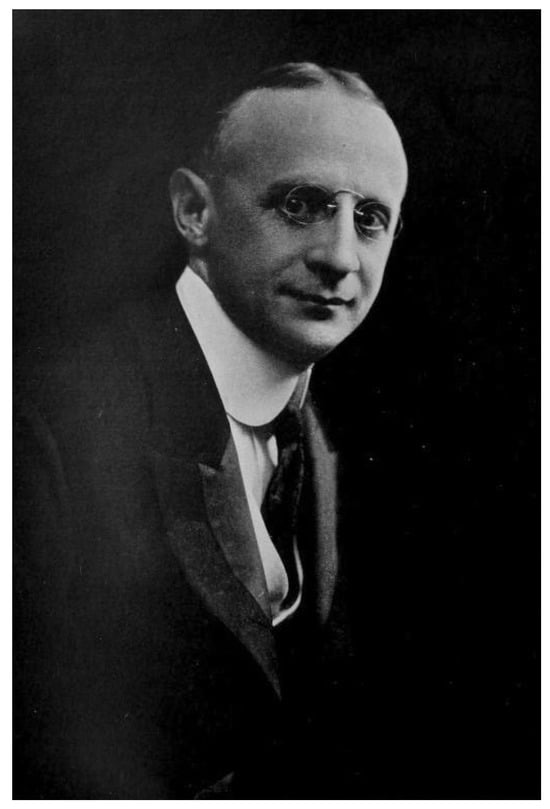
Figure 14.
Physician-scientist Simon Flexner (1863–1946), Director of the Rockefeller Institute for Medical Research in New York City. Flexner was the first director of the Rockefeller Institute for Medical Research in New York City, a position he held from 1901 until his retirement in 1935 (Rous 1949). In 1965, the Rockefeller Institute became Rockefeller University, a decade after it expanded its mission to include education. Photograph by Russian-born portrait photographer Elias Goldensky (1867–1943), Philadelphia. Reprinted from Ref. [81] (p. 5550).
We failed utterly to discover bacteria, either in film preparations or in cultures, that could account for the disease; and, since among our long series of propagations of the virus in monkeys not one animal showed, in the lesions, the cocci described by some previous investigators and we had failed to obtain any such bacteria from the human material studied by us, we felt that they could be excluded from consideration.[6] (p. 2095)
The following year, Flexner dismissed such reports of bacterial isolations from patients with poliomyelitis as nothing more than contaminants mistaken for an etiological agent:
Various bacteria, and especially certain cocci, have from time to time been isolated in cultures from fluids obtained by lumbar puncture from patients suffering from the epidemic disease [poliomyelitis], or from specimens of the central nervous system removed from victims at autopsy. These bacteria did not conform to one species or group of micro-organisms, and did not suffice to set up poliomyelitis in animals. They can be accounted for more satisfactorily as contaminations or secondarily invading bacteria than as the cause of the disease.[82] (p. 1106)
Flexner, one of the clearest and most foresighted thinkers of the period, was essentially dismissing these reports of bacterial isolation because they failed to meet Koch’s postulates to establish a necessary causal relationship between a microbe and a disease. The postulates were initially formulated as implicit or explicit steps for establishing a bacterial cause for disease by German microbiologists Robert Koch (1843–1910) and his protégé Friedrich Loeffler (1852–1915) in a variety of papers between 1878 and 1884, based in part on earlier concepts of German physician, pathologist, and anatomist Jakob Henle (1809–1885) in 1840, and these were subsequently refined and expanded by Koch in 1890 as follows [83,84,85,86,87,88,89,90,91,92]: (1) the microorganism must be invariably demonstrable in cases of the disease and must be absent in healthy individuals; (2) the microorganism can be isolated from the diseased host and grown in pure culture; (3) inoculation of a healthy, susceptible host (typically an experimental animal) with the pure culture must produce the disease; and (4) as specified by Koch, the microorganism must be re-isolated from the inoculated, diseased host and be identical to the original microorganism. Although these criteria could not always be fulfilled, even with bacterial diseases (e.g., if no susceptible experimental animal could be identified), these served as useful heuristics for establishing disease causation in many bacterial diseases.
Despite the experimental evidence and animal models supporting a viral etiology for poliomyelitis by 1909, some clinicians and clinician–scientists continued to believe that a bacterial cause would ultimately be demonstrated. Even as late as 1917, Edward C. Rosenow (1875–1966) (Figure 15) at the Mayo Clinic in Rochester, Minnesota, championed a “pleomorphic streptococcus or micrococcus” as the cause of poliomyelitis [93,94,95].
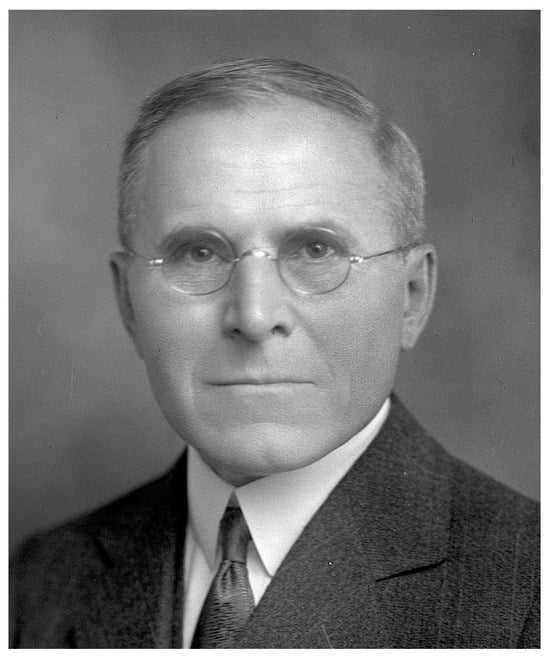
Figure 15.
Minnesota physician and bacteriologist Edward C. Rosenow (1875–1966) of the Mayo Clinic, Rochester, Minnesota. Used with permission of the Mayo Foundation for Medical Education and Research, Rochester, Minnesota. Edited by Douglas J. Lanska, MD, MS, MSPH.
Given the early confusion over the clinical diagnosis between epidemics of (meningococcal) meningitis and poliomyelitis, expectations that similar bacterial organisms would ultimately be discovered in both conditions, and the undoubted limitations of the sterile technique in many of these early lumbar punctures, finding cocci in the smears and incorrectly concluding that they were the organisms responsible for the development of poliomyelitis is hardly surprising, and perhaps was to be expected.
6. More Extensive Field Studies Began Around 1907 in the US
In 1907, New York saw its largest epidemic of poliomyelitis to date, with approximately 2500 cases in the summer and autumn [96,97,98]. In October 1907, the New York Neurological Society appointed a seven-member committee of six neurologists and a psychiatrist to study the epidemic, including Chairman and neurologist Bernard Sachs (1858–1944) (Figure 16), neurologists James Ramsay Hunt (1872–1937), Smith Ely Jelliffe (1866–1945), Israel Strauss (1874–1955), Joseph F. Terriberry (1857–1932), and Edwin G. Zabriskie (1874–1959), and psychiatrist L. Pierce Clark (1870–1933). The Committee obtained the support of a committee appointed by the Section on Pediatrics of the New York Academy of Medicine [Linnaeus E. La Fetra (1868–1965), Herman Schwartz (1878–1945), and Louis C. Ager (1868–1944)], as well as the active cooperation of Simon Flexner at the Rockefeller Institute, Charles F. Bolduan (1873–1950) at the Department of Health of New York City, and orthopedic surgeon Henry L. Taylor (1857–1923). With these additions, the full Committee included 13 members.
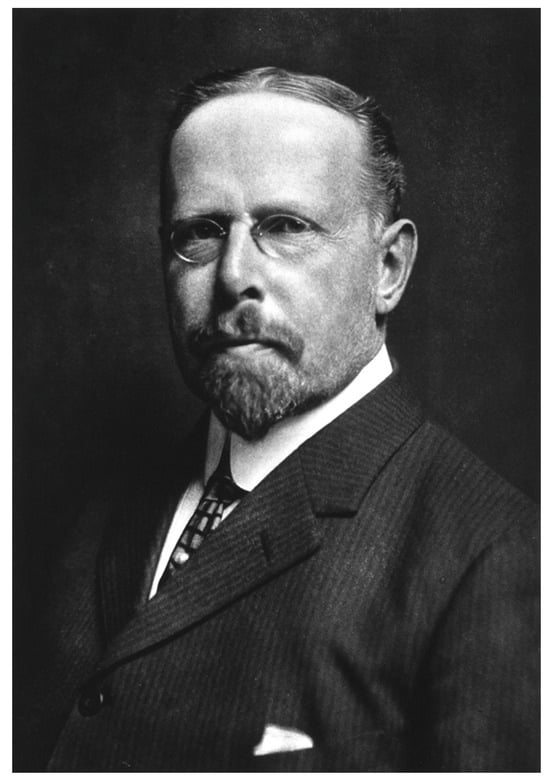
Figure 16.
New York pediatric neurologist Bernard Sachs (1858–1944), circa 1900. Sachs chaired the Collective Investigation Committee, charged with studying the 1907 New York poliomyelitis epidemic [99] (public domain).
The Committee sent 4000 return postal cards to the physicians of Greater New York and the surrounding area, inquiring if they had seen any cases of infantile paralysis during the summer and autumn of 1907. Of 1100 answers received, 470 physicians reported seeing cases of infantile paralysis in that period. A detailed questionnaire was sent to those who reported seeing cases. This questionnaire included many details concerning the residence; prevalence of flies and mosquitoes and the presence of window screens; type of toilet (pit of flush basin); water supply (municipal, well, or rain-water cistern); number of cases in the family and their acquaintances; coincident illness in family members; pets in the house; travel out of town in the month preceding illness; gastrointestinal or respiratory disturbances preceding neurologic illness; typical diet, including raw milk consumption; symptoms in the first few days of illness, including fever, headache, muscle or joint pain, and respiratory, gastrointestinal, cutaneous, and neurologic symptoms; onset, progression, distribution, and severity of paralysis; disease course; results of laboratory studies if performed, including blood tests (white and red blood cell counts and hemoglobin), lumbar puncture (opening pressure and analysis results), and urinalysis; and results of autopsy if performed with attention to the gastrointestinal, respiratory, and central nervous systems and the presence or absence of lymphatic hyperplasia.
Considering the limitations of recognition and reporting, the Committee estimated that the 1907 New York epidemic involved about 2500 cases, although they had physician reports of only about 800 and data on 752 from their improvised reporting system. Unfortunately, the Committee’s report was not published until 1909 in abbreviated form and 1910 in the full form [96,97], by which time the results had been largely anticipated by a similar committee in Massachusetts, which published serial reports beginning in 1908, as well as by separate scientific investigations of some of its own members, particularly Flexner.
Coincident with the epidemic in New York, by autumn 1907 physicians in Massachusetts recognized many more cases of poliomyelitis than in previous years, so the Massachusetts State Board of Health launched an investigation into the distribution and characteristics of the disease, spearheaded by orthopedic surgeon Robert W. Lovett (Figure 17). In February 1908, the Board sent a circular letter to all the approximately 6000 physicians in the state “asking if in the year 1907 they had seen in their practice any cases of acute febrile disturbance in young children, followed by paralysis” [100] (p. 109). The Board subsequently sought details by a questionnaire for all physicians answering the initial inquiry with an affirmative answer. Through this process, the Board identified and analyzed 234 cases for 1907.
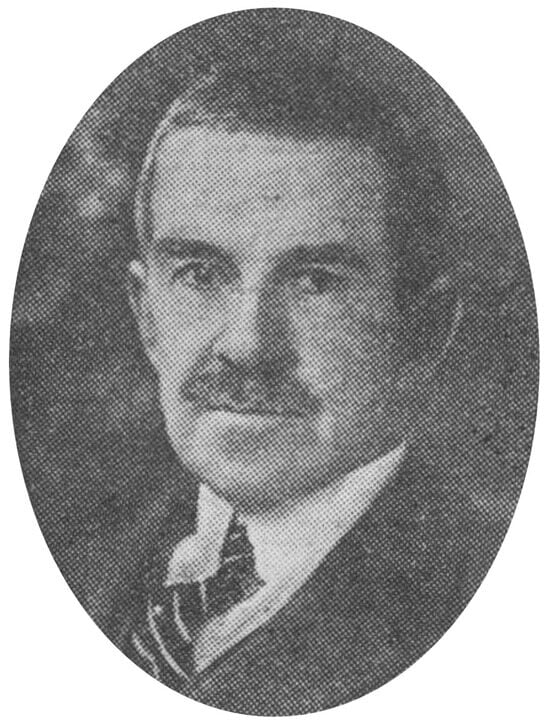
Figure 17.
Boston orthopedic surgeon Robert Williamson Lovett (1859–1924), professor of orthopedic surgery at Harvard, who was later famous as the physician who diagnosed Franklin Delano Roosevelt’s case of poliomyelitis in 1921. Reprinted from Ref. [101] (public domain).
The earliest states to require the reporting of cases of poliomyelitis were “chiefly, if not solely, in States where its prevalence has already alarmed the people” [98]. For example, poliomyelitis became a reportable disease in November 1909 in Massachusetts and in 1910 in New York. Massachusetts subsequently emphasized the importance of reporting by declaring poliomyelitis “dangerous to public health” (along with trachoma and ophthalmia neonatorum) [102]. New York neurologist Joseph Collins (1866–1950) made a “plea that it may be considered a reportable quarantinable disease” [103,104]. However, there was not a national reporting system at this time, and hence no requirement for reporting polio cases at a national level (it was not until 1951 that the Centers for Disease Control implemented a national morbidity reporting system and polio became a “reportable” disease, meaning it was required to be reported to public health authorities).
By around 1910, there were several reports from state-level surveillance, such as the report of poliomyelitis cases in Massachusetts in 1909 (presented in graphic form only) by Lovett (619 cases) [55,105,106,107,108]. The considerably increased sharpness of the seasonal peak for the 1909 poliomyelitis data [i.e., the tallest curve in Figure 6] likely reflects, at least in part, a difference in the approach to case ascertainment between that study and prior cases series collected over multiple years that incorporated non-epidemic data (which would tend to flatten such curves) [40,49,50,51,52,53].
With the increased availability of state surveillance data for poliomyelitis from around 1910, the clear seasonal pattern of poliomyelitis, with varying magnitudes of epidemics from year to year in the same broad geographic territory, became apparent, as shown, for example, by data collected by Lovett and Mark W. Richardson for Massachusetts for 1907–1910 (Figure 18) and then extended to 1912 by Richardson, by Caverly for Vermont from 1910 to 1917 (Figure 19 and Figure 20), and then by Filip C. Fursbeck and Eliot H. Luther at the Rockefeller Institute for Medical Research for Massachusetts from 1907 to 1929 [62,109,110,111,112,113,114,115] (Figure 21 and Figure 22). By this point, poliomyelitis was well established as an unwelcome, though fairly predictable, scourge of late summer and early fall. Epidemics often began in June or July, after which the number of cases increased greatly at the end of summer. One third of all cases occurred in September, and three quarters occurred in the three months with the highest number of cases, i.e., from August to October.
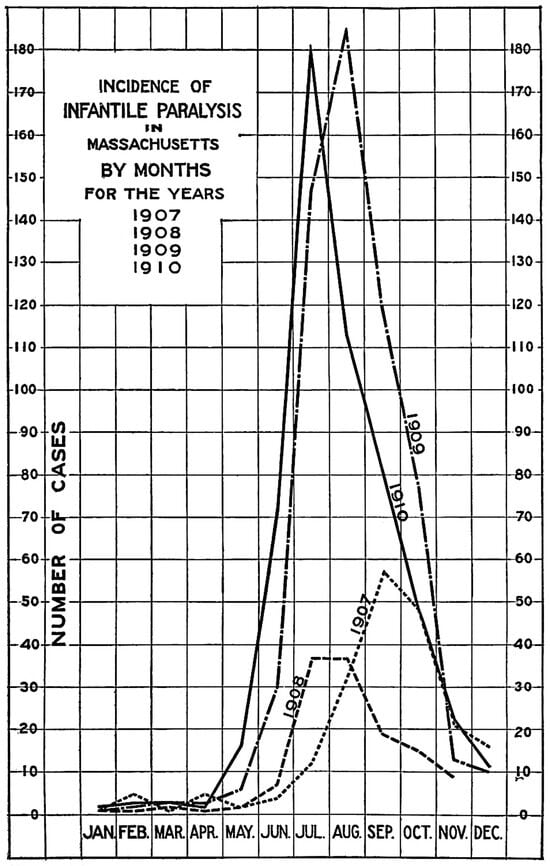
Figure 18.
Seasonal variation in poliomyelitis incidence for Massachusetts by month for each year from 1907 to 1910. Reprinted from Ref. [111] (public domain).
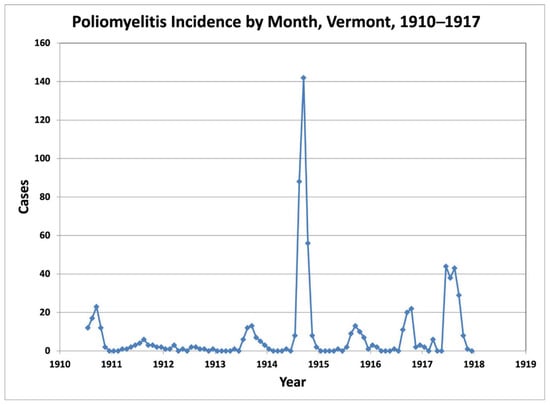
Figure 19.
Time series of incident poliomyelitis cases for Vermont from June 1910 through 1917. Data from Ref. [62].
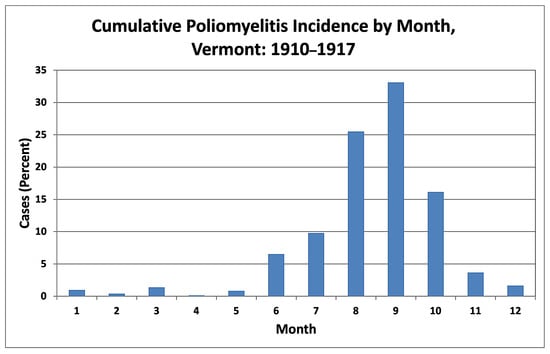
Figure 20.
Seasonal variation in poliomyelitis incidence for Vermont from 1910 to 1917. Data from Ref. [62].
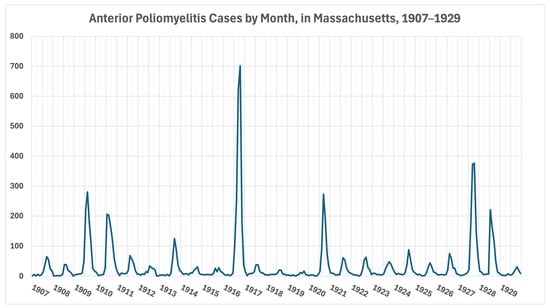
Figure 21.
Time series of seasonal variation in poliomyelitis incidence for Massachusetts by month from 1907 to 1929. Data from Ref. [115].

Figure 22.
Seasonal variation in poliomyelitis incidence for Massachusetts for 1907–1929. Data from Ref. [115].
In 1908, orthopedic surgeon Robert Lovett, on behalf of the Massachusetts State Board of Health, compared the month of onset for 412 cases of cerebrospinal meningitis and “234” cases of infantile paralysis [Note: although there were 234 cases of poliomyelitis reported, the month of onset was plotted for only about 208 of these, presumably because of missing or imprecise month-of-onset data for the unplotted cases] [102]. The resulting curves are almost perfectly out of phase with each other, so that the incidence of cerebrospinal meningitis started rising in February, peaked in April, and declined back to baseline by July, whereas the incidence of poliomyelitis began rising in July, peaked in September, and declined back to baseline by January [105,114] (Figure 23). Bacterial meningitis does indeed have a seasonal pattern, peaking in the winter months in countries in both the northern and southern hemispheres, a pattern which is distinctly different from the characteristic peak of poliomyelitis in the late summer and early fall [116].
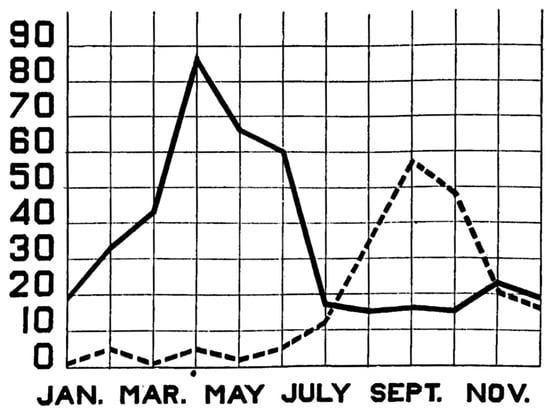
Figure 23.
Comparison of seasonal incidence of cerebrospinal meningitis with that of poliomyelitis in Massachusetts for 1907. Reprinted from Refs. [106,114] (public domain).
In 1910, Fritz Lange (1864–1952), a German orthopedic surgeon and Professor of Surgery at the University of Munich, visited orthopedic facilities in the northeastern United States. Lange was particularly impressed with Lovett and his work with spinal biomechanics and his pioneering studies of poliomyelitis in Massachusetts:
Above all I would single out the extensively planned and very carefully conducted investigation of Lovett on the spread of poliomyelitis in Massachusetts. With the support of the state, which allocated 40,000 Mark [i.e., approximately $10,000 in 1911 dollars] for this study in 1911, he was able to investigate the source of infection for every single case, and based on the preliminary results we can expect a fundamental, classical study comparable to the works of [Swedish physicians Karl Oscar] Medin and [Ivar] Wickmann.[117] (translation p. 285)
7. Systematic Syntheses of Prior Polio Epidemics to 1910
By 1908, sufficient reports of poliomyelitis outbreaks and epidemics had accumulated in the global literature for systematic syntheses to be completed [11,118]. Eminent New York pediatrician Luther Emmett Holt (1855–1924) [119] (Figure 24), Professor of Diseases of Children in the College of Physicians and Surgeons of Columbia University, along with pediatric colleague Frederic Henry Bartlett (1875–1948), collected data from 35 epidemics, beginning with the small outbreak in Feliciana, Louisiana (about 10 cases in 1841) reported by Colmer in 1843, and extending through later epidemics: Stockholm, Sweden (44 cases in 1887), reported by Medin in 1890; Rutland, Vermont (132 cases in 1894), reported by Cavery; Brisbane, Australia (108 cases in 1904); and Drontheim, Norway (139 cases in 1905) [11,120] (Figure 25). As determined by a systematic review of polio epidemics itemized in A Bibliography of Infantile Paralysis: 1789–1944 [1], and by review of the data sources for several subsequent systematic syntheses, the original study by Holt and Bartlett was remarkably complete [12,18,103,121]. These additional data sources added only a few small outbreaks to the work of Holt and Brown, but did extend the period to 1910, by which time poliomyelitis had been shown to be a viral disease.
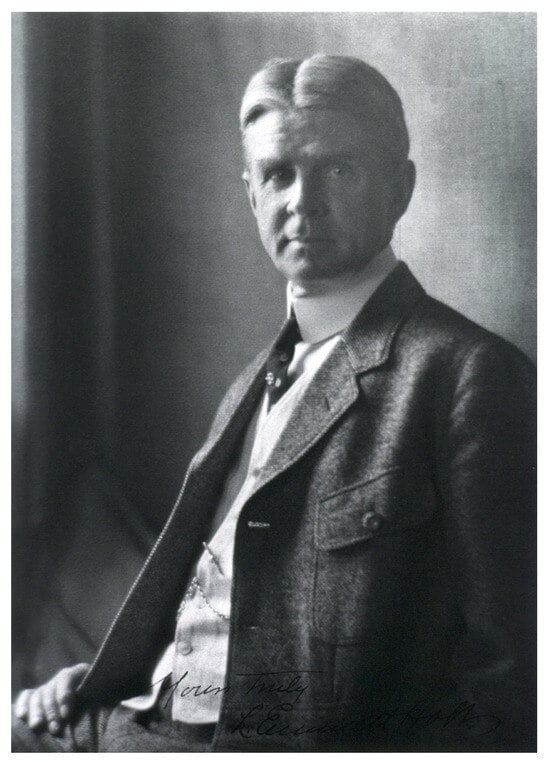
Figure 24.
New York pediatrician Luther Emmett Holt (1855–1924). In 1908, with colleague Frederic Henry Bartlett, Holt presented a systematic synthesis of prior poliomyelitis outbreaks and epidemics to 1906. The analysis of Holt and Bartlett of data for these epidemics strongly supported an infectious etiology for poliomyelitis. Courtesy of the National Library of Medicine, Bethesda, Maryland [122] (public domain).
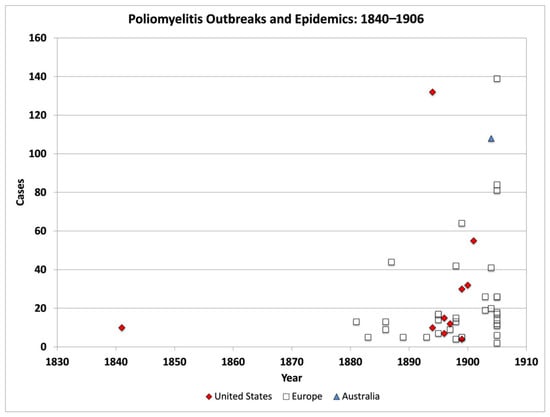
Figure 25.
Outbreaks and epidemics of poliomyelitis in the United States, Europe, and Australia from 1840 to 1906 as summarized in 1908 by New York pediatricians Luther Emmett Holt (1855–1924) and Frederic Henry Bartlett (1875–1924). Data from Ref. [11].
Holt and Bartlett acknowledged that,
The epidemics are widely separated both in time and location, and the records of many of them are very meager. In fact, few of them have been reported with a degree of care which makes a detailed study of them of great value, although collectively they throw considerable light upon the disease.[10] (p. 648)
Most of the outbreaks were very small until the last decade of the 19th century. Indeed, prior to 1890, all the outbreaks involved fewer than 20 cases, except for the small epidemic of 44 cases in Stockholm in 1887. It was at this point that reports mushroomed around the world, with epidemics of increasing magnitude, with the largest three exceeding 100 cases. Even these early outbreaks were soon to be dwarfed by much larger outbreaks of more than 1000 cases, e.g., in New York in 1907 (an estimated 2500 cases) and especially in 1916 [96,97,123,124,125,126,127].
Holt and Bartlett recognized that most of the outbreaks were very small, and even in larger epidemics the cases were often geographically disbursed: “The comparatively small number and wide [geographic] distribution of the cases in most of the epidemics is very striking, and seems to indicate that the different cases had no relation to one another or to a common cause [i.e., common source]” [11] (p. 652). However, as an offset to this information, they developed separate lines of evidence that “point quite definitely to a connection between different cases, indicating either a communication of the disease from one person to another, or the development of several cases near together from a common cause [i.e., common source]” [11] (p. 652). For example, they identified 40 instances, collectively comprising 96 cases, in which more than one case occurred in a family or household. In 29 of these 40 instances, a definite attack interval was given for cases within a household that ranged from 0 to 8 days in 28, with an outlier at 6 weeks. In 10 additional instances, a range was given that addressed multiple secondary cases within a household or was simply vague or imprecise. Such secondary cases suggested either a range of incubation periods following a common source of exposure, a continuing source outbreak (i.e., resulting from an exposure which persisted over an extended period), or secondary transmission within the household. They noted other instances where a child developed poliomyelitis shortly after moving into an infected district, or shortly after leaving it.
This synthesis strongly reinforced the seasonal nature of poliomyelitis outbreaks, with epidemics uniformly occurring in the summer and terminating with the onset of colder weather:
In 33 [of the 35 studied outbreaks and epidemics, or 94%] it is definitely stated that the epidemic occurred during the hot season only, or summer and early autumn, the most frequent months being July, August, and September. In almost every instance the epidemic terminated with the month of October. In one Australian epidemic [i.e., in Brisbane, 1904] the months of occurrence were March and April, which correspond to October and November [sic, September and October] in our climate.[11] (p. 649)
Holt and Bartlett found little to support the idea that sporadic cases might be increased in a community following an outbreak or epidemic of poliomyelitis. Instead, “after several of the epidemics … including some of the larger ones … in succeeding years … no cases were observed” [11] (p. 649). Norway’s experience of major annual epidemics in the early 20th century might have appeared to be a major exception. However, Holt and Bartlett noted that, “In Norway, although successive epidemics were reported in the years 1903, 1904, and 1905, it does not appear, from the reports, that the same communities were attacked” [11] (p. 640). Holt and Bartlett did not appreciate the significance of this observation, but they were clearly describing herd immunity.
Holt and Bartlett reported 201 deaths among 1659 collective cases, totaling a collective case-fatality rate of 12.1% [11]. However, in calculating mortality, Holt and Bartlett included epidemic and non-epidemic cases for Norway for the period 1903–1906, when Norway was establishing a national surveillance system. The collective cases for Norway in that interval (n = 1132) represent more than 2/3 of the cases reported in all the outbreaks and epidemics in the world literature to that point. When only city-level and regional epidemics are considered, there were 123 deaths recorded among 1039 cases, giving a short-term case-fatality rate of 11.8%, which is still very similar to the value reported by Holt and Bartlett.
Holt and Bartlett concluded that this epidemic pattern strongly supported an infectious etiology for poliomyelitis. When this was coupled with reports of secondary cases occurring within a household, they considered this conclusion nearly unassailable.
The occurrence of epidemics and the relation of certain groups of cases to one another in these epidemics place beyond question the statement that acute poliomyelitis is an infectious disease. Whether we can go farther and state that the disease is communicable is an open question. After carefully considering all the evidence…, we cannot resist the conclusion that the disease is communicable, although only to a very slight degree, one of the most striking facts being the development of the second cases within ten days after possible exposure. Positive statements, however, must be deferred until the discovery of the infectious agent.[11] (p. 662)
Several issues complicated attempts at systematic syntheses in this era: (1) many clinicians had difficulty distinguishing poliomyelitis from other causes of childhood (or later age) paralysis on clinical grounds and there were no accurate diagnostic tests to establish the diagnosis; (2) in general, this was prior to organized public health surveillance and reporting programs, and prior to requirements for mandatory notification of epidemic diseases; (3) in the first decade of the 20th century, as public health surveillance systems were beginning in some U.S. states and some countries (e.g., Norway), these systems collected sporadic cases with epidemic cases over broader geographic areas, producing larger estimates of poliomyelitis incidence that were nevertheless distorted estimates of the size of “epidemics”; and (4) there was little appreciation of the possibility of infectious non-paralytic cases or carriers, and tentative appreciation of this issue was only beginning by the very end of this period. When public health surveillance systems began to be developed in some countries and localities, case recognition and reporting increased significantly, and non-epidemic sporadic cases were included that otherwise would have not been tallied and would certainly not have been separately reported [128]. Notification of poliomyelitis became mandatory in Norway in 1905, and in various provinces of Austria and Germany by 1909 [128]. In 1907, Massachusetts became the first U.S. state to institute mandatory notification of all cases of poliomyelitis, and in 1910 the Surgeon General of the Public Health Service requested that all states submit reports on poliomyelitis for 1909 and 1910, but it was not until 1922, following the unprecedented devastating poliomyelitis epidemic of 1916, that all states regularly participated in a national morbidity reporting system for poliomyelitis [129,130]. A significant increase in reporting (and increased interstudy variability) occurred when non-paralytic cases began to be increasingly recognized and variably included.
To consider the expanding size of polio epidemics from 1840 to 1910, only reports of outbreaks and epidemics from cities are included to avoid distortions caused by including sporadic cases from non-epidemic areas in the totals of “epidemics” [11,12,18,103,121] (Figure 26). Specifically, annual poliomyelitis totals from state-level and national-level reporting are excluded. Consequently, the annual tabulations for Norway for 1903 to 1906 from the tabulations of Holt and Bartlett (1908) were not included, nor were the results for individual U.S. states from 1907 to 1910, the collected results for reporting states in the United States in 1910, or the results for states of other countries from 1907 [11,18,103,121]. The early outbreak of approximately ten cases in 1841 in Louisiana remained without parallel until the 1880s, whereas epidemics of more than 100 cases were not achieved until the 1890s, those of more than 1000 cases until the 1900s, and those of more than 10,000 cases (i.e., in New York City in 1916, not shown) until the 1910s (Table 1). The case fatality from the collected studies in the era from 1840 to 1910, in which this data was reported, was 9.1% for the United States (32 deaths from 350 cases) and 10.6% worldwide (188 deaths from among 1772 cases).
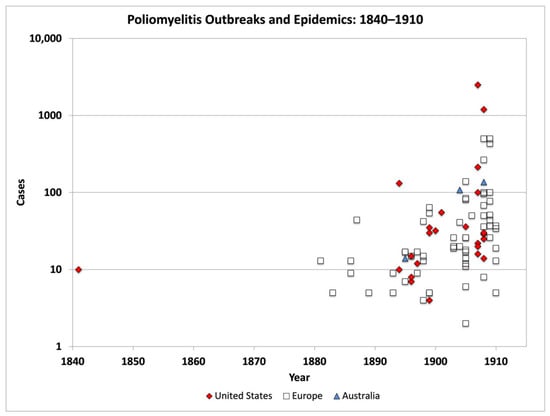
Figure 26.
Semi-log plot of outbreaks and epidemics of poliomyelitis in the United States, Europe, and Australia from 1840 to 1910. A semi-log pot is necessary because the sizes of the outbreaks and epidemics spanned more than three orders of magnitude. Plot by Douglas J. Lanska, MD, MS, MSPH. Data from Refs. [11,12,18,103,121].

Table 1.
Poliomyelitis cases in reported outbreaks and epidemics 1880–1909. Data from Refs. [11,12,18,103,121].
8. The Shifting Age Distribution of Cases (1840–1910)
Initially poliomyelitis affected almost exclusively infants and very young children. This was, of course, implied by the early name for the disease, infantile paralysis, as well as variably precise variants of this term, such as infantile spinal paralysis, essential paralysis of childhood, atrophic infantile paralysis, and atrophic paralysis of childhood.
Beginning in the 1870s, cases of spinal paralysis resembling “infantile paralysis” were increasingly reported in adults, with multiple authors suggesting that the adult cases were, in fact, caused by the same disease, albeit with an atypical onset age [131,132,133,134,135,136,137,138,139,140]. By 1911, pioneering epidemiologist Wade Hampton Frost (1880–1938) (Figure 27), then Passed Assistant Surgeon of the United States Public Health and Marine Hospital Service, argued that “The term ‘infantile paralysis’ is objectionable, because it is hardly applicable to adult cases; also, because it is likely to be confused with other infantile paralyses of altogether different etiology” [16] (p. 6). Furthermore, Frost noted that the Bureau of the Census had attempted to tally mortality statistics for poliomyelitis in 1909, but experienced considerable difficulty because the disease was reported under 24 different designations. Consequently, the Bureau of the Census urged the uniform adoption of the term “acute anterior poliomyelitis” [16].
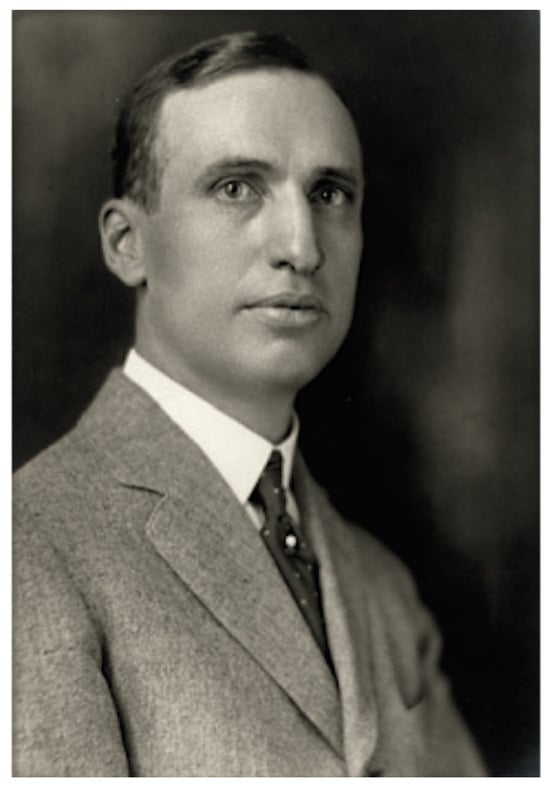
Figure 27.
Epidemiologist Wade Hampton Frost (1880–1938), Passed Assistant Surgeon of the United States Public Health and Marine Hospital Service [141]. Used with the permission of Bachrach Photography, the oldest continuously operating photo studio in the world, with locations in Philadelphia, New York, Boston, and Washington, D.C.
Assessing the age distribution of cases of poliomyelitis in outbreaks and epidemics in the interval from 1840 to 1910 is difficult. Authors were typically vague about the ages of affected cases, and when some age information was presented, it was often in arbitrary ranges of unequal size, with a large proportion of cases without reported ages, with ages presented in a wide range, and with age intervals that were not specified precisely or that even overlapped. For example, in the Rutland, Vermont, epidemic in 1894, Caverly reported 85 cases under 6 years, 21 cases from 6 to 14 years, and 7 cases “between a few months and 9 years” [58]. Data are sufficient to show, for the outbreaks and small epidemics of the mid to late 19th century and the first decade of the 20th century, that the median age of cases was consistently less than 5 years of age [8,16,42,51,52,55,58,96,97,108,142,143,144]. Adequate age-specific information was uncommon until the very end of this interval [52,55,108,145] (Figure 28).
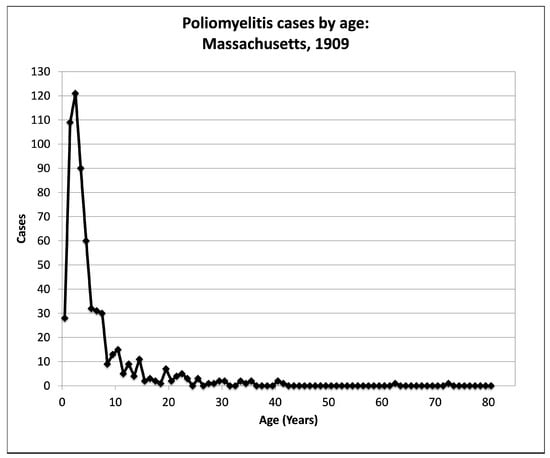
Figure 28.
Age distribution of 615 incident poliomyelitis cases in Massachusetts in 1909. Data from Refs. [55,108].
Field epidemiology was rare before 1900. Starr went to see cases in the Rutland, Vermont, epidemic of 1894, but this was mostly to establish the correct diagnosis of the responsible disorder. The pioneers of polio field epidemiology were Swedish physician Otto Ivar Wickman in Norway in 1905 [146,147], and, subsequently, Massachusetts State Inspector of Health Herbert Clark Emerson (1865–1922), Minnesota state epidemiologist Hibbert Winslow Hill (1871–1947), Massachusetts State Board of Health “Special Investigators” Sheppard and Hennelly (a fourth-year medical student at Harvard Medical School and a recently graduated physician from Harvard Medical School, respectively), and finally Wade Hampton Frost for the U.S. Public Health and Marine-Hospital Service [16,55,108,144,145,148,149,150,151,152,153]. Of these, Wickman and Frost made the most substantial contributions. From 1910 to 1912, Frost investigated six outbreaks of poliomyelitis, with a total of 475 paralytic cases and 54 “abortive” cases that failed to develop central nervous system manifestations. In 1911, John Anderson and Frost experimentally demonstrated the presence of specific anti-poliovirus antibodies in the serum of abortive (non-paralytic) cases of poliomyelitis [154], but this did not immediately lead to a laboratory test, and for some time clinicians had no accurate means of identifying cases of poliomyelitis in the absence of an acute paralytic syndrome [155]. Frost noted that, “The spontaneous decline of epidemics in localities where only a small percentage of people have been attacked, and the subsequent immunity of these localities while the epidemic spread in contiguous localities suggests that a population may be immunized by an epidemic giving rise to only one recognized case among several hundred or several thousand inhabitants” [145] (p. 251).
The data for poliomyelitis incidence in Massachusetts for 1909 were categorized into single years of age. Graphing these data shows a highly skewed distribution with a long tail: two thirds of cases were under 5 years of age, and 85% were under ten years of age, but the oldest case was 72 years (Figure 28). Interestingly, the maximum number of incident cases occurred in those from 1 to 4 years of age, whereas infants were relatively spared, a fact unappreciated at the time, but reflecting naturally acquired passive immunity conveyed from the mother to the infant either transplacentally or through breast feeding.
Systematic surveillance of poliomyelitis incidence for defined geographic regions was only beginning over the interval from 1905 to 1910. Available data are insufficient to adequately assess whether there was a shift in the age distribution of incident cases of poliomyelitis over the interval from 1840 to 1910, although available information suggests that poliomyelitis was, at least initially, limited to young children during the mid-19th century until adult cases were recognized and increasingly reported, beginning in the 1870s.
The distribution of population immunity was not considered as an explanation for the shifting age distribution of poliomyelitis epidemics until 1918, when this was suggested as a possibility by Claude Hervey Lavinder (1872–1950) of the U.S. Public Health Service [125] (Figure 29):
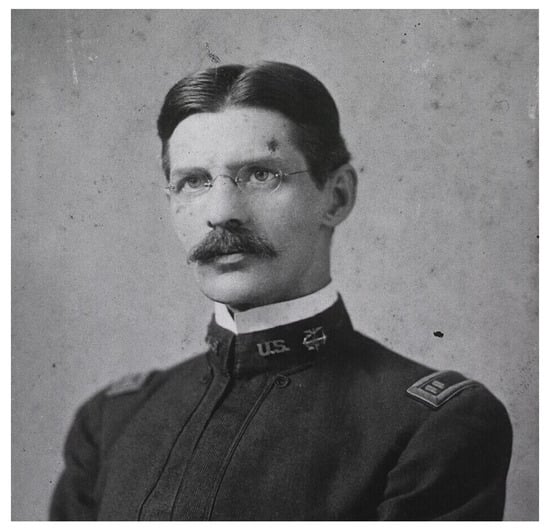
Figure 29.
Assistant surgeon Claude Hervey Lavinder (1872–1950) of the U.S. Public Health Service in 1898. Courtesy of the National Library of Medicine, Bethesda, Maryland. Adapted from [156] (public domain).
The rapid spread of epidemics over wide areas, their spontaneous decline after only a small proportion of the inhabitants have been attacked, and, above all, the preponderating incidence in young children, have not been satisfactorily explained by any hypothesis other than that the infective agent, during epidemics, is widespread, reaching a large proportion of the population, but only occasionally finding a susceptible individual, usually a young person, in whom it produces characteristic morbid effects. … As to what constitutes susceptibility or the converse—immunity—practically nothing can be deduced except that age is obviously a factor of importance, susceptibility being generally greatest in the first half decade of life, thereafter progressively diminishing until in adult life there is a very general immunity to natural infection. … Conceivably the greater immunity of adults may be due to a nonspecific resistance, developing naturally with maturity, without reference to previous exposure to or infection with the specific virus of poliomyelitis. On the other hand, there are certain facts which suggest that the very general immunity of adults may be specific, acquired from previous unrecognized infection with the virus of poliomyelitis.[125] (pp. 22–23)
This explanation, involving the shifting distribution of population immunity, had to await recognition of the development of immunity in previously exposed individuals by physician-scientist Simon Flexner and pathologist Paul A. Lewis (1879–1929) at the Rockefeller Institute for Medical Research in 1910 [82,157,158,159], the development of adequate population surveillance systems after 1905, and the collection of adequate longitudinal population data [125].
9. Is Poliomyelitis Infectious and Contagious? Perspectives from 1890 to 1905
In the early 1890s, few were even considering the possibility that poliomyelitis was an infectious disease. In 1892, in his Text-Book of Nervous Diseases, New York neurologist Charles Loomis Dana concluded that “age, season, and infectious diseases are the three most important etiologic factors” for poliomyelitis [37] (p. 221, original emphasis). This was in large part based on the widely acknowledged predilection for the disease to affect young children, the seasonality reported by Sinkler in 1875, and Sinkler’s recognition that infectious fevers often preceded the paralytic attack [36,37].
In 1893, Boston neurologists James J. Putnam and Edward Wyllys Taylor further considered evidence for an infectious etiology for poliomyelitis, in an astute but cautious analysis:
To what is the unfavorable influence of the summer due? It may be an affair of weather, as such, though obviously heat, pure and simple, is not the important factor; or the weather may act as favoring some other influence, perhaps bacterial in character. The reasonableness of this latter view is now conceded by many good observers: but it is certain that its advocates are still far from having made good their claim. In favor of the doctrine [of an infectious etiology] is the fact that the outbreaks of the disease occasionally occur in distinct epidemics. These so-called epidemics, however, have always happened in late summer and early autumn…[38] (p. 510)
In contrast to other recognized epidemic diseases of the time, however, such as smallpox and measles, poliomyelitis did not have a marked propensity for direct contagion, such as among family members. As Putnam and Taylor noted, “It is noteworthy, as against any strongly marked epidemic influence, that the patients did not come to any extent, from any one locality, but from different parts of the large area of the suburbs of Boston” [38] (p. 510).
As part of the Mutter Course of Lectures delivered before the College of Physicians of Philadelphia in 1893, Philadelphia surgeon DeForest P. Willard (1846–1910) (Figure 30), the first Chairman of the Department of Orthopaedic Surgery at the University of Pennsylvania, and Philadelphia neurologist of Guy Hinsdale (1858–1948) (Figure 31), another protégé of S. Weir Mitchell and also of Canadian-American internist William Osler (1848–1919), were among others who suspected that poliomyelitis was an infectious disease [160,161,162]. They too were quite objective in their assessment and recognized that this was not yet proven.

Figure 30.
Philadelphia orthopedic surgeon DeForest P. Willard (1846–1910), the first Chairman of the Department of Orthopaedic Surgery at the University of Pennsylvania. In 1893, with colleague Guy Hinsdale, Willard proposed, in the Mutter Course of Lectures delivered before the College of Physicians of Philadelphia, that poliomyelitis is an infectious disease. Courtesy of the National Library of Medicine, Bethesda, Maryland [163] (public domain).
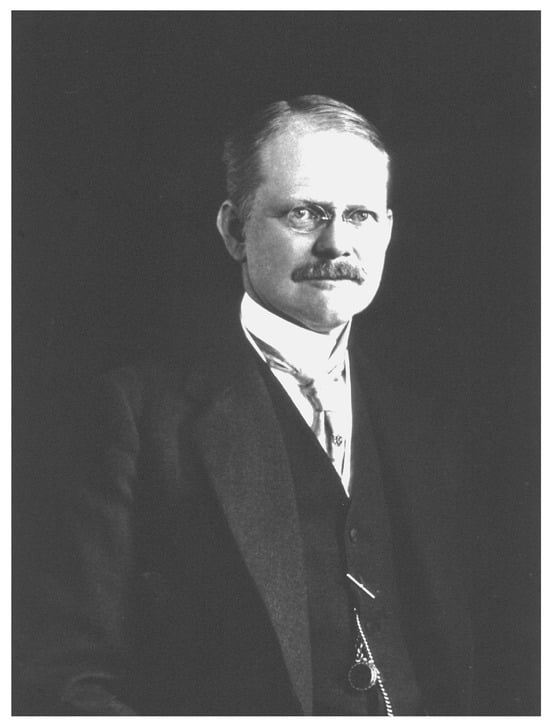
Figure 31.
Philadelphia neurologist Guy Hinsdale (1858–1948). Courtesy of the National Library of Medicine, Bethesda, Maryland [164] (public domain).
It is probable that anterior poliomyelitis will be relegated in the near future, in common with many other diseases of the nerve-centres, to the class of infectious diseases of microbic origin. As yet we have little proof to offer in support of such a proposition, but the surgical pathology of today is nothing if not bacterial.[160] (p. 68)
The mid- to late-19th century was, of course, the time when the germ theory of disease was being developed in Europe by Hungarian obstetrician Igaz Semmelweis (1818–1865) in the 1840s, English physician and epidemiologist John Snow (1813–1858) in the 1850s, French microbiologist Louis Pasteur (1822–1895) in the 1860s–1870s, and German microbiologist Robert Koch (1843–1910) in the 1870s. Investigators came to consider many conditions as bacterial, often simply because the paradigm had proven so successful. Willard and Hinsdale put polio in this context:
One affection after another is analyzed in the laboratories of the world; the organism is finally isolated by the refinement and higher powers of the pathological technique of these last years of the century. In these days we could fill a veritable Pandora’s box with the scourges of the universe, the pure cultures would be marked with the names of anthrax and tubercle, relapsing fever and glanders, cholera and typhoid, diphtheria and leprosy, pneumonia and tetanus; with the names of Neisser and Lavern and Pasteur, and with all the toxins and ptomaines in an ever-lengthening list. The plagues that have escaped to the ends of the earth are now collected within the walls of our modern institutes of hygiene. … With regard to poliomyelitis the evidence as yet is meager.[160] (p. 68)
In 1905, after a large polio epidemic in Sweden, Swedish physician (Otto) Ivar Wickman (1872–1914) provided substantial evidence that polio was a contagious disease, with at least some cases being abortive (non-paralytic) cases that were nevertheless still important as sources of further transmission of the disease [146,147,148,165]. Although Wickman was not the first to suggest that abortive cases could serve as important sources of further transmission of the disease, his work helped convince many researchers that this was the case [82,148]. As Simon Flexner (1863–1946) at the Rockefeller Institute for Medical Research in New York City noted:
[D]ata collected in Scandinavia indicate that the contagion can be carried by intermediate persons from the stricken to the healthy, and from patients not frankly paralyzed, but suffering with slight or so-called abortive attacks of the disease. Moreover, the incubation period of the disease would appear to vary within considerable limits, being sometimes not more than two or three or four days in length and at other times as much as twenty days, the average being eight or ten days…[82] (p. 1106)
10. Proof That Poliomyelitis Is an Infectious Viral Disease
As early as 1907, Flexner had attempted to transmit poliomyelitis from humans to monkeys during the 1907 poliomyelitis epidemic in New York City, but the attempt failed for various technical reasons (as was evident in retrospect).
[I]n 1907, when the first epidemic appeared in New York [City] and vicinity, we endeavored to transfer poliomyelitis from human beings to monkeys. Unfortunately we were at this time limited merely to fluids obtained by lumbar puncture from cases at different stages of the disease. I say unfortunately for the reason that we had the idea originally of bringing the supposedly infected material directly into relation with the nervous systems of monkeys. This we indeed did with the fluids obtained by lumbar puncture, from which we failed entirely lo produce any symptoms that we could discover, including paralysis. During the epidemic of 1907 we did not secure organs from a case of pure infantile paralysis, and we failed, therefore, in our intention to inoculate monkeys from the spinal cord.[82] (p. 1106)
In the summer of 1909, Austrian pathologist Karl Landsteiner (1868–1943), then prosector at the Royal-Imperial Wilhelminen Hospital in Vienna, along with his assistant, German pathologist Erwin Popper (1879–1955), demonstrated that poliomyelitis could be transmitted to monkeys, apparently by a virus [5,82,148,166,167]. Landsteiner and Popper had obtained virulent spinal cord tissue from a 9-year-old boy who died of poliomyelitis, then ground it up and filtered a suspension of this material through a very dense porcelain filter (Chamberland-Pasteur filter), with pores so minute that they precluded the passage of bacteria. Using this bacteriologically sterile filtrate, Landsteiner and Popper nevertheless produced signs of paralysis in a rhesus monkey (Macaca mulatta) and a baboon (Cynocephalus hamadryas) after intraperitoneal injection of this filtrate, and the histology of the spinal cord from these New World primates was identical to that of human poliomyelitis, proving that poliomyelitis is a viral disease. However, as Flexner noted, “in endeavoring to continue the transfer of the virus by intraperitoneal injection of other monkeys they failed entirely” [82] (p. 1107). In the late summer or early autumn of 1909, Israel Strauss (1873–1955) and Frank Huntoon (1881–1948), at Cornell Medical College in New York City, were similarly able to transmit poliomyelitis from humans to monkeys but were unable to transmit it serially between monkeys [82,168,169].
By September 1909, these prior results were confirmed and expanded by Flexner and Paul Aldin Lewis (1879–1929) at the Rockefeller Institute [82,170,171,172,173] (Figure 32). Unlike prior investigators, Flexner and Lewis successfully demonstrated both the creation of experimental poliomyelitis in monkeys through the intracerebral injection of infected human nervous tissue and the successful transmission of experimental poliomyelitis from one monkey to another [82,170,171,172]. As Flexner recounted,

Figure 32.
Physician-scientist Simon Flexner (1863–1946), Director of the Rockefeller Institute for Medical Research in New York City, in his laboratory, circa 1912. Reprinted from Ref. [174] (public domain).
It was not until September, 1909, that we secured the spinal cord from two cases of infantile paralysis in human beings, which specimens were employed for the inoculation of monkeys by direct injection of an emulsion into the brain through a trephine opening. The first inoculations were successful. The animals immediately after their recovery from the ether anesthesia were lively and normal. They remained apparently in perfect health for a number of days, when paralysis set in. The spinal cord derived from these animals was and is still being employed to transmit the infection to still other monkeys.[82] (pp. 1106–1107)
Flexner and Lewis demonstrated that the infectious agent was a “minute and filterable virus that have not thus far been demonstrated with certainty under the microscope” because it could pass a Berkefeld filter made of diatomaceous earth that could exclude all known bacteria [6] (p. 2095), [175]. They also showed that germicidal substances—later known as neutralizing antibodies—were present in the blood of monkeys that had survived poliomyelitis [6]. Flexner subsequently extended his studies of experimental poliomyelitis with Lewis and various other colleagues [158,159,176,177,178,179,180,181,182,183,184,185].
11. Persisting Questions Concerning the Contagiousness of Poliomyelitis
The studies of experimental poliomyelitis in monkeys surprised many but nevertheless convinced most that poliomyelitis was an infectious disease, even if serious questions remained regarding its contagiousness and method of transmission. At a meeting of the Medical Society of the County of New York on October 24, 1910, Simon Flexner presented a paper on “The relation of experimental to human poliomyelitis” [157]. In the discussion, New York pediatrician Luther Emmet Holt (1855–1924) said,
Even five years ago if anyone had suggested that the disease under discussion was an infectious or a contagious one, it would have been looked upon as a joke. The opportunity for studying the disease during the past few years had been so great that it was now a settled question that the disease was spread from patient to patient.[157] (pp. 925–926)
Nevertheless, doubts about the contagiousness of poliomyelitis persisted well into the 20th century, in part because the fecal-oral mechanism of transmission was not understood, and there was little recognition of the importance of non-paralytic cases, asymptomatic carriers, and resistant (immune) individuals, much less an accurate clinical or laboratory means of identifying such disease groups. As noted by public health physician Frank George Boudreau (1886–1970) and colleagues, from the Ohio State Board of Health, as late as 1914, five years after poliomyelitis was demonstrated to be a viral disease, many (and possibly most) clinicians still doubted the contagiousness of poliomyelitis [186]. Boudreau was a thoughtful observer and synthesizer, who would later serve as Director for the League of Nations Health Section, Chairman of the Food and Nutrition Board of the National Research Council, and head of the United States Committee for the World Health Organization. Factors Boudreau saw as hampering the wide recognition of the contagiousness of poliomyelitis included an erroneous expectation that an infectious disease should routinely affect multiple members of a family (which was not the case with poliomyelitis), and a failure to appreciate the high frequency of non-paralytic cases and resistant (immune) individuals:
The view that acute poliomyelitis is contagious has been gradually gaining ground among those most familiar with the disease, although the large mass of clinicians who see only isolated and sporadic cases are still unconvinced. It has been pointed out by the opponents of this theory that the percentage of second cases in a family is small, but this argument can be met with two statements,—first, that many abortive cases of acute poliomyelitis occur and are not recognized, and, second, many individuals are not susceptible to acute poliomyelitis and many other transmissible diseases with the exception of smallpox and measles, which flourish in any soil. … In acute poliomyelitis, as in epidemic cerebro-spinal meningitis, many people—a large majority of the population, appear to be insusceptible. A further reason why the contagious nature of acute poliomyelitis cannot be disproved is that we do not know how numerous are healthy carriers and missed and abortive cases.[186] (pp. 8–9)
Even as late as 1918, Claude Hervey Lavinder of the U.S. Public Health Service expressed continued concerns about the lack of adequate epidemiological support for the person-to-person transmission of poliomyelitis [125]:
The dominant view that poliomyelitis is a contagious disease spread directly from person to person does not receive, on the surface at least, adequate support from the epidemiologic evidence which is ordinarily sought to establish such a conception, namely, the incidence of cases among persons known to have been intimately associated with the sick, and the establishment among those sick of some previous association with other cases of the disease. In other words, we can not show any undue prevalence of the disease among the persons surrounding the patient, nor can we trace satisfactory connection between one case and other previous case.[125] (p. 21)
12. The Zoonotic Theory of Polio
With the 1894 Vermont poliomyelitis epidemic, Caverly had reported coincident deaths from paralytic disease in animals, particularly horses, dogs, and fowls [56]. With hindsight, these were not poliomyelitis [148], and indeed Caverly initially reported that among the “many deaths among horses, attended with symptoms of paralysis, … at least one veterinarian tells me he found meningitis” (although a later paper of his reported the opposite, as discussed below) [56] (p. 5). But, at the time, these reports raised concern that poliomyelitis might be a zoonosis, an issue that was not fully resolved for nearly a century.
At the request of Caverly, Dana examined the brain and spinal cord of a chicken that had paralytic symptoms at the time of the epidemic [56,60]. Dana was a clinical neurologist with some experience with neuropathology, but was not a neuropathologist, and was certainly not a veterinary neuropathologist. On September 18, 1894, Dana was sent a “large Plymouth Rock hen for bacteriological purposes” [60]. This fowl was clearly paretic, and the owner of the brood, a physician, reported that several of his birds had died with similar signs.
Dana reported his findings at a meeting of the New York Neurological Society on 6 November 1894. Neurological examination of the bird “revealed a paraplegia, not quite complete, and some paralysis of the wings; the head and neck muscles had not been affected; there had been no anaesthesia” [60] (p. 824). On pathological examination, Dana reported that “no evidence of meningitis had been found, and there had been no signs of haemorrhagic extravasation” [60] (p. 824). Dana then described a necrotizing myelitis, which from his somewhat confused and speculative description did not replicate the neuropathological changes in human poliomyelitis: “From the appearance of the cord, it appeared that there had been an acute exudative inflammation, and that the process had been so severe that necrosis had come on before the inflammatory reaction; hence it was practically a case of acute infectious softening rather than myelitis” [60] (p. 824). Dana nevertheless fully accepted that this was indeed acute poliomyelitis in a hen, and concluded that, “while this case might not have any actual value, yet to a certain extent it corroborated the infection theory of anterior poliomyelitis, and, in so far as it went, it supported the view that in this disease the changes were primarily vascular and not parenchymatous” [60] (p. 824). In his assessment, Dana apparently assumed that the hen was affected with the same disorder as that which afflicted the local human population, and in so doing he accepted pathological changes in the hen that are not characteristic of human poliomyelitis, which in turn led him to erroneously suggest a vascular process in the etiology of poliomyelitis.
Most of the extended discussion among attendees of Dana’s presentation concerned the human epidemic, but at the end of the discussion period New York neurologist Graeme Monroe Hammond (1858–1944) (Figure 33), the son of neurologist William Alexander Hammond, expressed doubts about Dana’s overconfident assessment, and specifically asked whether the diagnosis of poliomyelitis in the hen had been based on clinical manifestations or the pathologic condition of the cord. He noted that, “In the microscopical sections exhibited by Dr. Dana the anterior horns appeared to be symmetrical and the changes did not appear exactly similar to those … found in the true [human] disease” [60] (p. 824). Dana replied somewhat disingenuously that, “in some of the sections, which he had been unable to bring with him, the lesion in the cord had been very marked. In some there had been a distinct loss of substance, with softening and haemorrhage” [60] (p. 824).
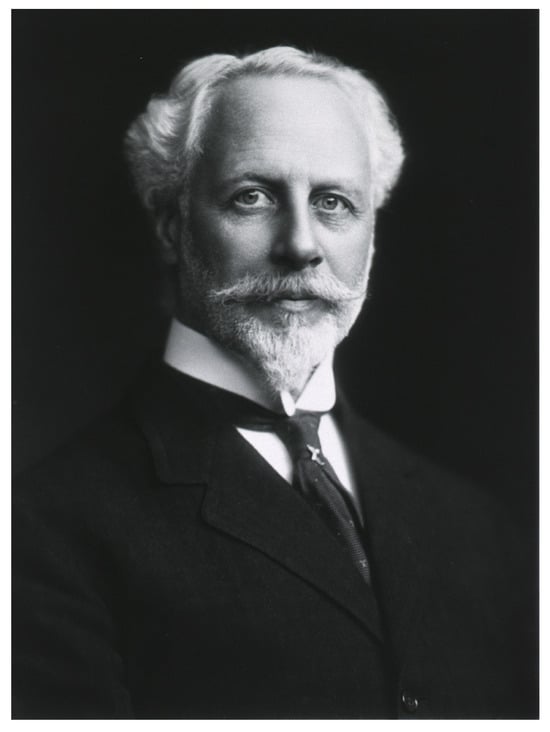
Figure 33.
New York neurologist Graeme Monroe Hammond (1858–1944), the son of neurologist William Alexander Hammond. In 1912, Hammond was an Olympian competitor in the individual foil and épée events at the 1912 Summer Olympics. Courtesy of the National Library of Medicine, Bethesda, Maryland [187] (public domain).
Curiously, in his initial and final reports of the 1894 epidemic, Caverly reported diametrically opposed results for the sole horse autopsy performed at the time of that epidemic: in his initial report in 1894 (when the diagnosis of the human cases was unclear, and the differential was between epidemic meningitis or poliomyelitis), he reported that a veterinarian had found meningitis, but in his final report in 1896 (when the diagnosis of poliomyelitis in the human cases was considered established) he reported that a veterinarian had found no evidence of meningitis:
Dr. W. W. Townsend, of Rutland, who made the examination of the horse, says that the examination of a section of the lumbar portion of the cord showed a “granular degeneration and pigmentation of the ganglion cells of the anterior cornua, and atrophy of the anterior nerve roots.” He further states that there was no meningitis in this case [emphasis added].[58] (p. 4)
Caverly’s observation of apparently coincident paralytic disease in animals during an epidemic of poliomyelitis, although a red herring, was nevertheless confirmed and reinforced in multiple subsequent epidemics and investigations [15,55,106,107,108,109,110,111,150,188,189,190,191,192,193,194,195,196,197,198,199,200,201].
In 1910, Cambridge (Massachusetts) orthopedic surgeon Edward Hickling Bradford (1848–1926) (Figure 34) [202], soon to be Dean of the Faculty of Medicine of Harvard University, along with colleagues from the Department of Orthopedic Surgery of Harvard Medical School, remained noncommittal concerning a potential zoonotic basis for poliomyelitis, but the tone of their report was somewhat skeptical [189,190]: “In connection with epidemics of paralysis in human beings, disease and paralysis among the domestic animals of the vicinity have been frequently reported, but in the absence of definite data it is as yet impossible to state that the animal paralysis is of the same character as the human infantile paralysis” [190] (p. 244).
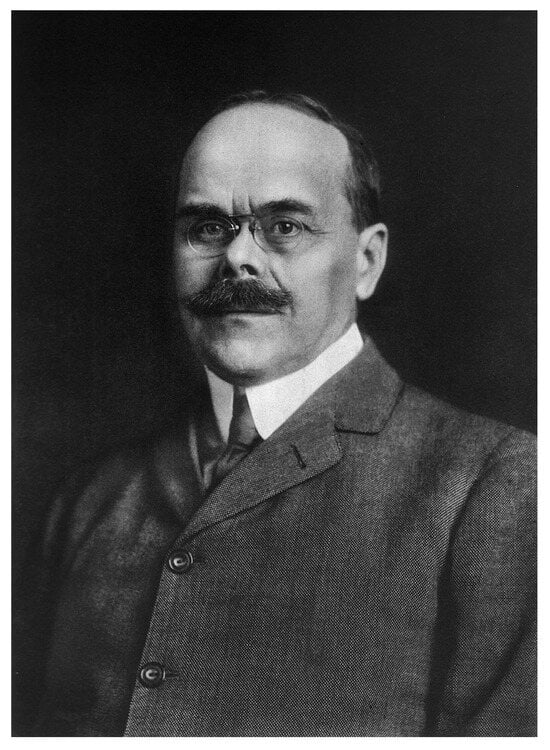
Figure 34.
Orthopedic surgeon Edward Hickling Bradford (1848–1926) from Cambridge, Massachusetts. Courtesy of the National Library of Medicine, Bethesda, Maryland [203] (public domain).
Similarly, in 1910, orthopedic surgeon Robert Lovett, on behalf of the Massachusetts State Board of Health, acknowledged coincidental paralysis of both humans and animals had been previously reported in some outbreaks, but further investigation did not support a true correspondence:
The occurrence of paralysis among domestic animals and fowls has been found to coincide with outbreaks of the disease in the human beings in some instances reported. Inquiries were, therefore, addressed to every veterinary surgeon and every animal inspector in Massachusetts as to the occurrence of such paralysis in animals in 1909. The reported cases were then carefully laid off on a map of the state and the relative distribution of the animal cases compared with that of the human cases. No correspondence was found to exist, so that so far as these data can be depended on, no obvious connection on the whole existed between the two classes of cases in Massachusetts in 1909.[108] (p. 48)
In a review in 1912 and in a later monograph with New York surgeon and philanthropist Henry William Frauenthal (1863–1927) (Figure 35) and New York physician Jacolyn Van Vliet Manning (1877–?), formerly an epidemiologist in Eau Claire, Wisconsin, 14 reports of apparently coincident paralytic disease were identified in humans and nearby animals [195,204]. Animals reported to be affected included horses, sheep, dogs, cats, hogs, and various fowls. Manning concluded that,
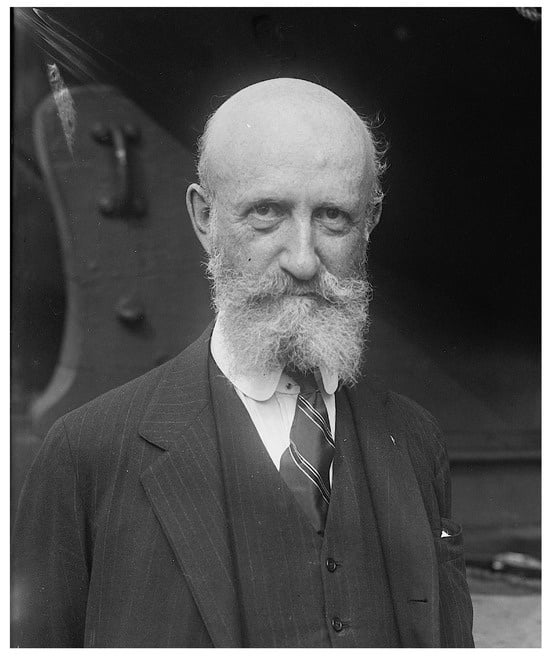
Figure 35.
New York surgeon and philanthropist Henry William Frauenthal (1863–1927). Frauenthal and his newlywed wife Clara were survivors of the sinking of the Titanic. Like other male survivors of the Titanic sinking (15 April 1912), Frauenthal suffered from accusations of cowardice. Frauenthal and his wife both suffered from mental health problems. He died by suicide in 1927, jumping from the seventh floor of the Hospital for Joint Diseases in New York City, which he had founded. He left the bulk of his fortune, estimated between USD 300,000 and USD 400,000 (the equivalent of USD5.4–7.2 million in 2024 USD), to the hospital. The hospital is now known as NYU Langone Orthopedic Hospital. The 225-bed hospital became NYU Langone’s dedicated orthopedic hospital in 2006. Credit: George Grantham Bain Collection, Library of Congress, Prints & Photographs Division, Washington, D.C. [205] (public domain). Edited by Douglas J. Lanska, MD, MS, MSPH.
Frequent epidemics of paralytic disease occurring coincidentally with human poliomyelitis may indicate that man is not the essential host of this disease. It is well known that poliomyelitis has been artificially transmitted [by intracerebral inoculation] to monkeys and rabbits by many investigators… The efforts to transmit the disease artificially to the horse, sheep, dog, cat, hogs and fowls have been unsuccessful.[195] (p.136)
To support her conjecture that the same agent caused outbreaks of both human and animal disease, Manning misquoted Flexner. She wrote that “according to Flexner, ‘we possess evidence that certain of the lower animals, among them poultry, the dog, and possibly the horse, are subject to poliomyelitis,’” implying that there was already experimental proof that animals could be affected in the same way as humans by the agent that caused human poliomyelitis [195] (p. 136). What Flexner actually wrote, though, was the following: “We possess already evidence to the effect that certain of the lower animals, among them poultry, the dog, and possibly the horse, are subject to poliomyelitis, due apparently in each instance to a cause particular to the species affected” [emphasis added] [82,157]. Flexner was saying that animal paralytic disease resembling human poliomyelitis was due to “a cause particular to the species affected,” i.e., not the agent responsible for human poliomyelitis. He was certainly not supporting or affirming that the poliomyelitis virus could or did cause simultaneous outbreaks in humans and animals, nor was he suggesting that poliomyelitis was a zoonosis. Caverly had, apparently intentionally, deleted words from the quoted material to support her own thesis, giving an entirely different impression of the results of Flexner’s scientific work and his speculations about how the disease is transmitted.
Closer review of Manning’s accumulated instances of apparently coincident outbreaks of human and animal paralytic disease shows the following: (1) the epidemics were not necessarily truly coincident (affected animals in at least one instance were noted in the year prior to a human outbreak of poliomyelitis); (2) clinical illness in animals seldom resembled the human condition (e.g., with reported spastic paralysis in horses, or ataxia in sheep and fowls, rather than the atrophic flaccid paralysis seen in human polio); (3) animals dying with supposed poliomyelitis-like illnesses rarely had pathologic examinations, and among the few that were studied pathologically none had clear documentation that the pathology was similar or identical to that in humans.
Some of the outbreaks of disease in animals cited by Manning may, in fact, have been non-infectious (e.g., ataxic sheep in England likely had “swayback,” an enzootic ataxia due to copper deficiency), but others had infectious disorders that were not poliomyelitis.
A striking example of a diagnostic misclassification of animal paralytic disease in Manning’s synthesis is the report of about 4000 cattle and 1000 horses affected by a fatal paralytic illness in Sao Paulo, Brazil in 1910–1911 coincident with 13 cases of human poliomyelitis. Manning dismissed the original diagnosis of bovine rabies, apparently because canine rabies (i.e., the typical reservoir of human rabies) was unrecognized as a significant problem in that area of Brazil at the time. She further dismissed the clinical finding of “spasmodic pharyngeal paralysis” in cattle, apparently believing that it was at least consistent with poliomyelitis in animals and not relatively specific to rabies. In retrospect, since at least 1908, an epizootic of bovine and equine paralytic (“dumb”) rabies transmitted by vampire bats had occurred in southern Brazil. Ranchers in the state of Santa Catharina, Brazil, first suggested an association between bovine rabies and vampire bats after they observed bats behaving abnormally, uncharacteristically flying and biting during daylight, after which the cattle that had been bitten developed a paralytic disease [206,207,208,209]. In 1911, Italian physician Antônio Carini (1872–1950), at the Pasteur Institute of São Paulo, and Professor of Microbiology and Immunology of the Faculty of Medicine of São Paulo—most widely known for his discovery of Pneumocystis carinii (now P. jirovecii)—established the diagnosis of bovine rabies in Brazil by demonstrating Negri bodies in neurons, and then further established the diagnosis by inoculation of bovine spinal cord into rabbits [206,207,208,209]. In 1921, veterinarians H. Haupt and H. Rehaag similarly proved that one of the species of vampire bats (Desmodus rotundus) in Brazil carries rabies and can transmit it to cattle [208,209,210,211,212,213]. Bovine paralytic rabies remains a serious public health and economic problem in Brazil, and vampire bat-transmitted human rabies is a persisting zoonotic disease there as well [208,213,214,215,216,217,218].
In 1914, Boudreau and colleagues at the Ohio State Board of Health reviewed and dismissed the supposed evidence of animal-to-human transmission of poliomyelitis from prior outbreaks and epidemics on the basis that the claim of coincident outbreaks of poliomyelitis-like illness in humans and animals lacked scientific proof. While not exactly a disproof of the claim, this at least helped focus research on more productive investigations.
Horses and cattle have … been found paralyzed in the presence of an outbreak of acute poliomyelitis, but in the cases investigated no lesions similar to those found in the human spinal cord have been described. Many interesting histories of coincidental paralysis in human beings and the lower animals have been related and recorded. Investigation generally reveals a lack of scientific proof.[186] (p. 15)
Several theories have been advanced to explain the methods of transmission of acute poliomyelitis. It has been suggested that some of the lower animals may act as reservoirs without themselves showing appreciable symptoms of the disease; or that it might be a disease of lower animals, and many seemingly convincing histories of coincident paralysis in animals and human beings have been recorded. These do not usually bear the light of scientific investigation, and the paralysis in animals has not been found to be due to a typical lesion in the spinal cord.”.[173] (p. 44)
In 1918, Lavinder and colleagues in the U.S. Public Health Service expressed most clearly the lack of evidence to support a zoonotic basis for poliomyelitis, and suggested ascertainment bias as a likely explanation for the repeated reports of coincident human and animal paralytic diseases [125]:
Domestic animals suffering from paralytic affections, clinically similar to poliomyelitis, have often been found in communities where poliomyelitis was epidemic, but these animals have not appeared sufficient, either in numbers or in the intimacy of their association with cases of poliomyelitis, to account for the epidemics. Also, it has not been shown that the paralyses of animals are essentially similar to human poliomyelitis. Paralytic diseases of lower animals are not very uncommon, and though they have not been fully studied, it appears that they may be due to a variety of causes. It is not even proven that such diseases are actually more common during epidemics of poliomyelitis. It is quite possible that their apparent association with epidemics of poliomyelitis is due to the fact that they are more apt to be noted and reported in communities where the epidemic prevalence of poliomyelitis has attracted attention to them.[125] (p. 20)
A century later, there is still no evidence that non-primates experience naturally acquired poliovirus infections, and consequently they cannot serve as reservoirs [219]. Of the various animal reservoirs suggested by Caverly, Manning, and others—cattle, horses, hogs, sheep, dogs, cats, fowls, mice, rats, and moles—no poliovirus has ever been isolated from any of these, despite repeated attempts, even when these animals were living in the vicinity of a person with poliomyelitis [219,220]. Although sera from domestic dogs, chickens, cows, horses, goats, and sheep have been shown to neutralize poliovirus type 2, there was no clinical evidence of infection [219]. Similarly, although neutralizing activity against poliovirus types 1 and 2 has been demonstrated in bovine colostrum, and although several studies beginning in 1916 suggested a milk-borne route of human poliovirus infection [221,222], Polish-American investigator Albert Sabin (1906–1993) (Figure 36) and his National Foundation for Infantile Paralysis research fellow, Arnold Howard Fieldsteel (1918–1982), working at the Children’s Hospital Research Foundation in Cincinnati in the early 1950s, were unable to infect antibody-negative calves [219,223,224,225]; Sabin and Fieldsteel ultimately speculated that the neutralizing activity of bovine sera and colostrum was caused by infections with an animal virus that is antigenically related to human poliovirus [218]. More recent studies have shown that non-primates and their cell cultures are refractory to natural infection because they lack the human poliovirus receptors [226,227].

Figure 36.
Polish-American investigator Albert Sabin (1906–1993), known for developing an oral polio vaccine. Reprinted from Ref. [228] (public domain).
After more than a century of investigation of this issue, it is now known that man is the sole natural reservoir of the poliovirus, although some primates, particularly chimpanzees and other great apes, are at least potentially susceptible, although to lesser degrees than humans [219]. In 1941, Howard A. Howe and David Bodian (1910–1992) at the Poliomyelitis Laboratory of Johns Hopkins University School of Medicine demonstrated that captive chimpanzees can be infected with human poliovirus from close physical contact with experimentally infected chimpanzees (presumably by the fecal-oral route) [229,230,231]. Later studies by Sabin showed a differential susceptibility among primates to infection with poliovirus by the natural oral route (as opposed to intraperitoneal or intracerebral injection of infected tissues), with humans being more susceptible than chimpanzees, and chimps much more susceptible than lower primates (e.g., rhesus and cynomolgus monkeys) [232,233]. Even the monkeys that are most susceptible to oral infection develop low levels of viral excretion [234]. Antibodies to poliovirus have been reported from various free-living and captive primates, but in most cases it is unclear if these were acquired in the wild or in captivity, or even if the responsible virus was human poliovirus or an antigenically related animal virus that cross-reacted [219,233,235,236,237,238].
Three outbreaks of poliomyelitis have been reported in wild and captive primates [237,239,240,241]. A well-documented outbreak of paralytic poliomyelitis due to infection with poliovirus type I occurred in a primate center in 1964, affecting only great apes (gorillas, orangutans, and chimpanzees), whereas none of the 150 monkeys became ill (although 3 of the 25 tested yielded poliovirus) [237]. In 1966, an epidemic of presumed paralytic poliomyelitis occurred among chimpanzees in Gombe National Park, Tanzania, affecting 10 chimpanzees, approximately one month after an outbreak of poliomyelitis among the human population residing nearby; laboratory confirmation of poliovirus infection was not attempted [240,241]. Most recently, in 1982, three colobus monkeys developed paralytic poliomyelitis due to poliovirus type I at a crowded breeding colony in Kenya [239]. No other outbreaks of paralytic disease attributable to human poliovirus are known to have occurred in either wild or captive populations of primates, despite intense scrutiny. Given the lesser susceptibility of subhuman primates to poliovirus infection compared with humans, the extremely rare occurrence of outbreaks of poliomyelitis or polio-like illnesses in wild and captive primate colonies, and the temporal sequence from human to chimpanzee infection in the only known outbreak of presumed poliomyelitis in a wild primate population, it is possible that humans have served as a reservoir for rare outbreaks of poliomyelitis in primates, but there remains no substantial evidence that subhuman primates or other animals have ever served as a reservoir for human poliomyelitis outbreaks.
13. Is Poliomyelitis a Vector-Borne Disease?
Beginning around 1910, Lovett and colleagues in Massachusetts began considering in their field studies whether insects (e.g., flies, mosquitoes, fleas) might transmit poliomyelitis [55,100,108,109,110,111,188,193,196,199]. In 1911, Lovett and Philip A.E. Sheppard, a senior medical student at Harvard Medical School, on behalf of the Massachusetts State Board of Health, tabulated the presence of various insects, vermin, and rodents for 185 families with a case of poliomyelitis in Massachusetts in 1910, finding flies universally present in the vicinity, mosquitoes in 36%, and ants in 34% [110,193]. Among the 200 cases of poliomyelitis “carefully investigated” in these families, 70% had no history of insect bites, 27% had a history of mosquito bites, and the remainder reported bites of various other insects. The authors discounted their findings, not because they lacked a control group (which should have been recognized as an apparent weakness of their study), but because no entomologist had performed the on-site assessments. Starting in the 1840s, several pioneering 19th- and early 20th-century studies utilized some of the key design features of modern case-control studies, and some 19th-century investigators explicitly recognized that a control group was needed to assess whether the frequency of an exposure was unusual in a group of cases, so this concept was hardly novel by 1910, even if it was rarely developed in the medical literature of the time; the case-control design was certainly used sporadically until 1950, when it was used in studies that linked lung cancer with cigarette smoking, with further theoretical development beginning in the 1970s [242,243,244,245].
Studies of potential insect vectors soon focused on biting flies, in part because of their universal presence in the vicinity of identified cases [112,191,192,246,247,248,249,250,251,252,253]. None of the studies before 1912 provided strong support for an insect vector of poliomyelitis, and those in 1912 and 1913 proved conflicting and confusing.
Arnold Josephson, in Sweden, unsuccessfully tried to transmit poliomyelitis to monkeys by the rather crude approach of intraperitoneal and intraneural injection of a filtered mixture of saline and ground flies [i.e., flies crushed into small particles by a grinding process], without even ensuring that the flies had fed on infected animals [246]. Carl Kling and colleagues in Sweden were also unsuccessful in transmitting poliomyelitis by “blood-sucking animals” [252]: fleas from infected human subjects were ground in a mortar with saline and injected into the sciatic nerves of two monkeys, and similarly fleas allowed to feed on an infected baboon were ground and injected into the sciatic nerve of another monkey, but none of the experimental monkeys developed poliomyelitis.
In 1912, public health physician Milton J. Rosenau (1869–1946) (Figure 37), of the Harvard Medical School (and formerly Director of the Hygienic Laboratory of the U.S. Marine Hospital Service, the precursor of the National Institutes of Health), and Charles T. Brues, an entomologist at Harvard, described an experiment in which they reported successful transfer of poliomyelitis from infected monkeys to uninfected monkeys by the bites of stable flies [247,254]. Rosenau and Brues infected several monkeys with poliomyelitis by intracerebral inoculation and then exposed them to the bites of several hundred stable flies, while simultaneously exposing 12 uninfected monkeys to the bites of the same flies [247,254]. Six of the previously uninfected monkeys developed paralytic symptoms characteristic of poliomyelitis, in three cases resulting in death [249]. In two monkeys that died for which pathology was later reported, pathologic examination of the spinal cord showed characteristic lesions of poliomyelitis, with perivascular inflammation and destruction of lower motor neurons in the anterior horn in one, and destruction of motor neurons without perivascular inflammation in the other [247].

Figure 37.
Public health physician Milton J. Rosenau (1869–1946), of Harvard Medical School (and formerly Director of the Hygienic Laboratory of the U.S. Marine Hospital Service, the precursor of the National Institutes of Health). Rosenau is shown wearing his U.S. Public Health Service uniform. Courtesy of the National Library of Medicine, Bethesda, Maryland [255] (public domain).
Rosenau reported further experiments in 1914 [256] and tried to argue from the seasonal pattern that poliomyelitis was likely transmitted by an insect vector, although he was very close to suggesting the correct primary method of transmission as an enteral infection [155]. In particular, the late summer peak in cases suggested either an enteric disease or a vector-borne disease, rather than a disease spread through respiratory secretions.
The seasonal prevalence… of infantile paralysis does not suggest the seasonal prevalence of the diseases spread by contact through secretions from the mouth and nose. Almost all such diseases, including cerebrospinal meningitis, occur more particularly during the cold months of the year, whereas the prevalence of infantile paralysis is more marked during the summer months. The curve of seasonal prevalence of infantile paralysis corresponds more closely with that of typhoid and the diarrhœal diseases than it does with the group of infections spread through the secretions from the mouth and nose. … The only other group of diseases which prevail especially during the warm weather are those which are insect-borne. … The season of maximum prevalence of the insect-borne diseases corresponds, of course, to the season of maximum prevalence of insect life, namely, the summer. … [The] group of “contagious” diseases spread through the secretions from the mouth and nose occur throughout the entire year, but prevail especially during the colder months. On the other hand, there are two groups of disease having their maximum seasonal prevalence during the warm weather, namely, the intestinal infections and the insect-borne diseases. Of these two groups of summer diseases the insect-borne group disappears almost to the vanishing point in temperate latitudes with wintry climates, whereas the intestinal diseases continue to smolder all winter long, with occasional exacerbations, and sometimes even with outbreaks of epidemic proportions. … When we study the seasonal prevalence of infantile paralysis in all parts of the world, however, we find a summer prevalence, sometimes extending into the fall, but dying down almost out of sight during the winter and spring. So far as we may judge, then, from the seasonal prevalence of this infection, it corresponds more closely with that of the insect-borne type than any other group of diseases.[155] (p. 90)
John F. Anderson (1873–1958) (Figure 38), Director of the Hygienic Laboratory in Washington, D.C. (following Rosenau), and epidemiologist Wade Hampton Frost (1880–1938) soon replicated the results of Rosenau and Brues, providing further experimental evidence that “the common stable fly (Stomoxys calcitrans) played an important part in the spread of this disease” [247] (p. 332). Anderson and Frost performed an intracerebral inoculation of two monkeys with tissue infected with poliovirus, allowed these monkeys to be bitten “by about 300 Stomoxys recently collected in Washington,” and then exposed three healthy monkeys to the flies that had previously fed on the infected monkeys. After seven to eight days, all three of the previously healthy fly-exposed monkeys developed symptoms of poliomyelitis. To confirm the diagnosis of poliomyelitis in the previously healthy fly-exposed monkeys, an emulsion from the spinal cord of one of them was intracerebrally injected into a healthy monkey, which developed profound paralysis several days later and then died; histologic examination of the spinal cord showed lesions characteristic of poliomyelitis.

Figure 38.
John F. Anderson (1873–1958), Director of the Hygienic Laboratory in Washington, D.C. (following Milton J. Rosenau). Courtesy of the National Library of Medicine, Bethesda, Maryland. [257] (public domain).
The following year, Anderson and Frost sought to extend their work on fly transmission of poliomyelitis, but their subsequent attempts were unsuccessful, and no satisfactory explanation of the discordance was evident [248].
Similarly, in 1913, Wilbur A. Sawyer (1879–1951), Director of the Hygienic Laboratory of the California State Board of Health (and best known for his later role in developing a vaccine for yellow fever and working to eradicate yellow fever as a public health threat), and parasitologist William Brodbeck Herms (1876–1949) at the University of California, Berkeley, also reported their failure to transmit poliovirus “from monkey to monkey through the agency of the stable fly” [258].
Despite the unconvincing epidemiological results and the conflicting experimental data, the idea that flies could transmit poliomyelitis fit in a developing narrative in the early 20th century that flies were disease-carriers [259,260,261]. Furthermore, a fly vector (“germs with legs”) might explain the lack of evidence for direct person-to-person transmission or why cases could be found among those who were not commonly affected by serious contagious disease, particularly among the native-born, middle class [259,260,261]. Indeed, it was much easier to envision a contagious disease among the dirty poor than those living in relative cleanliness and wealth [259,261].
By the late 1930s, various studies had demonstrated that poliovirus may be excreted in the feces of infected individuals, whether they were paralytic, non-paralytic, or subclinical [262,263,264,265,266,267,268,269,270], but it remained unclear whether sewage was a source of infection in most US communities, since the virus had not been traced beyond the effluent from sewage treatment works [271].
The role of flies in the transmission of poliomyelitis was revisited beginning in the 1940s, after poliovirus was detected in sewage and as the magnitude of polio epidemics continued to increase in the US [272,273,274,275,276]. In the early 1940s, poliovirus was detected in various fly species, including stable flies and house flies, in both rural and urban areas [272,277,278,279], and in fly-contaminated food [280], which added a further impetus to control flies as a public health measure, particularly after World War II [281,282,283,284]. Even the fruit fly (Drosophila melanogaster) could “be “grossly contaminated to the point where it retains sufficient virus to cause paralysis in a few experimental animals,” but it seemed doubtful that these flies, like the common house fly (Musca domestica), could be of epidemiologic importance in poliomyelitis because the investigators “were unable to transfer the virus from flies exposed to it, except under conditions probably not present in nature” [285] (p. 138).
Unfortunately, fly abatement field trials proved ineffective in modifying the course of poliomyelitis epidemics (although the earlier ones suffered from inadequate sample sizes and suboptimal timing of DDT applications) [283,284]. The best-designed and implemented fly abatement field trial was conducted by the U.S. Public Health Service during a 1948 epidemic in Hidalgo County, Texas [284]: fly populations were substantially lower in towns treated with DDT, but community-wide fly control applied throughout the epidemic failed to either alter the time course of the epidemic or reduce the number of polio cases in treated towns compared to untreated towns.
Thus, although experimental studies had shown that it was theoretically possible for flies to serve as vectors of poliovirus [246,247,271,277,278,279,286], and occasional cases of polio were likely caused by fly-borne transfer of poliovirus from human feces to human food [280], the Hidalgo County fly abatement field trial showed convincingly that flies, whether biting or non-biting, could not explain the bulk of cases during polio epidemics [284]. As noted by historian Vincent Cirillo,
Undoubtedly, isolated cases of polio were caused by contact with infective fecal matter transferred to food, etc. from the sponging mouthparts, exoskeletal hairs and bristles, and pulvilli [i.e., soft, cushion-like pads found on the feet] of house flies. However, … M. domestica [the house fly] was not a major factor in the dissemination of poliovirus in the American epidemics. The epidemiological evidence from the Hidalgo County trial was indisputable, … and rang the death knell for the fly transmission hypothesis. The fly-polio nexus was finally abandoned in the mid-1950s. The introduction in 1955 of the safe and effective Salk killed-virus polio vaccine made the issue moot.[287] (p. 85)
14. Conclusions and Epilogue
Poliomyelitis in the mid-19th century was a rare disease, with only small and geographically scattered outbreaks. These early cases were, nevertheless, sufficiently characteristic to allow for a preliminary characterization of the clinical features of the disease but left those studying it puzzled concerning its etiology. It did not show a clear pattern of communicability, and hence an infectious etiology was not suspected.
The late 19th-century outbreaks and small epidemics of poliomyelitis provided a much clearer understanding of the clinical phenomenology of poliomyelitis, provided the beginnings of clinical-pathological correlation, allowed for the separation of poliomyelitis from other myelopathies and other disorders causing acute or subacute weakness, produced a rapid expansion in orthotic technologies and orthopedic surgeries to alleviate the resulting disabilities and deformities, and, by the end of the century, established a strong expectation that polio would ultimately be shown to be an infectious disease [2,3,4].
However, the contagiousness of poliomyelitis had long remained an open and contentious question, with inconclusive evidence of communicability even among those residing in close proximity (e.g., within families). In trying to elaborate an infectious theory of poliomyelitis, several misleading reports in the last decade of the 19th century opened consideration of whether poliomyelitis is a bacterial disease and whether it might be transmitted from animals to man—a zoonosis. By the first decade of the 20th century, the various putative bacterial causes were recognized to be merely contaminants, but the zoonosis hypothesis was not fully disproved until the latter half of the 20th century. As the 20th century began, virology and immunology were still in their infancies and poliomyelitis was not yet suspected to be a viral disease.
The early 20th-century polio epidemics allowed for the application of field epidemiology techniques, which provided convincing proof that poliomyelitis is contagious and led to major advances in intensive care and rehabilitation [3]. The rapid development of laboratory techniques for transmitting poliovirus to experimental animals (e.g., monkeys) and for serially transmitting poliovirus from animal to animal established the infectious nature of poliomyelitis by 1909 but left unresolved the mechanism of transmission in man [5,148,167,170,176].
In 1916, a major epidemic of poliomyelitis in the United States brought the disease into national consciousness. In New York City alone there were an estimated 9009 cases and 2407 deaths [123,124]. Nationwide, there were 27,000 cases with 6000 deaths, almost all in young children (<5 years) [3,4]. Many survivors had profound lifelong disabilities and often major deformities. Subsequent annual summer epidemics were less severe until they began progressively increasing during the 1940s and early 1950s, with the worst epidemic in 1952 causing nearly 58,000 cases of paralytic poliomyelitis.
As increasing numbers of older children and adults became affected by poliomyelitis in the late 19th and early 20th centuries, the original label of “infantile paralysis” was no longer appropriate and was eventually replaced by either the medical term “poliomyelitis” or the shorter colloquial term “polio” [288] Because poliomyelitis mortality was high and because survivors were often left with severe paralysis and resulting disability [3,4], polio epidemics caused widespread anxiety and fear during the summer months [289].
Late 19th-century suspicions that poliomyelitis is a bacterial disease were disproven by demonstrations in 1909 that poliomyelitis is caused by a filterable virus [5,170], even though occasional overzealous clinicians and clinician-scientists argued for bacterial causation for another decade [93,94]. Similarly, early 20th-century notions that poliomyelitis is a zoonosis or vector-borne disease were finally abandoned by mid-century, after wide-ranging epidemiological studies, human-and-animal experiments, and public health field trials [290].
The growing epidemics of paralytic poliomyelitis in the United States beginning in the 1890s and occurring throughout the first half of the 20th century were partly an unanticipated consequence of improved sanitation, a phenomenon expressed memorably by John Modlin, a renowned American specialist in pediatric infectious diseases: “Polio… was the unanticipated consequence of the invention of the flush toilet and the adoption of the use of toilet paper” [291]. Later, epidemiological studies ultimately showed that improved hygiene (i.e., including the flush toilet and use of toilet paper) delayed exposure to polioviruses from early infancy (when maternal antibodies provide protection against paralytic disease) to later in childhood or adulthood, at which time paralytic manifestations of poliomyelitis are much more likely [21,291].
In 1936, Albert Sabin and pathologist and microbiologist Peter Kosciusko Olitsky (1886–1964) at the Rockefeller Institute successfully grew poliovirus in a culture of brain tissue from a human embryo [292]. However, they reportedly worried that using this as the starting material for a polio vaccine might induce autoimmune-mediated central nervous system damage. They then tried to grow poliovirus in non-nervous tissue cultures but were unsuccessful.
In 1949, more than a decade after the work of Sabin and Olitsky, microbiologist John Franklin Enders, Ph.D. (1897–1985), along with his junior physician colleagues, Thomas Huckle Weller (1915–2008) and Frederick Chapman Robbins (1916–2003), working at Harvard Medical School and Children’s Medical Center in Boston, first cultivated poliovirus in non-nervous tissue culture, work for which they later shared the 1954 Nobel Prize in Physiology or Medicine [293,294,295,296,297,298]. Weller had begun working with Enders as a senior medical student in 1939, and later followed Enders to Boston Children’s Hospital, where Robbins joined them in 1948. Using tissue-culture methods that they had successfully applied to cultivate mumps virus in vitro, they were trying to do the same with varicella and incidentally inoculated several unused cultures with the Lansing strain of poliovirus (i.e., type 2 poliovirus that had been adapted to mice and that caused murine paralysis after intracerebral inoculation). To their surprise, they successfully grew poliovirus in a culture of human embryonic skin and muscle tissue. After twenty days in culture, the intracerebral inoculation into mice produced paralysis of all the inoculated animals. At Enders’ suggestion, Robbins tried using cultures of intestinal tissue (obtained from the autopsy of a premature human infant) and achieved similar results.
Enders and colleagues subsequently determined that poliovirus type 1 could be similarly cultivated in vitro using completely differentiated, non-nervous tissue (human foreskin). By 1949, they found that poliovirus could be detected morphologically in tissue cultures, because the virus induced distinctive degenerative cellular changes—a phenomenon Enders termed the “cytopathic effect.” They soon developed in vitro viral assays and were able to assess the neutralizing capacity of antisera, thus allowing a tissue culture system to replace studies with experimental animals.
By 1951, The Committee on Typing of the National Foundation for Infantile Paralysis—of which American virologist Jonas Salk (1914–1995) (Figure 39) was a participant—concluded that there were three strains of poliovirus as defined by cross-protection within the same group, work based in large part on that of John Rodman Paul, M.D. (1893–1971) and James Dowling Trask, M.D. (1890–1942) at Yale University in the 1930s, and David Bodian, M.D., Ph.D. (1910–1992) and colleagues at Johns Hopkins University in the late 1940s [148,167,299,300,301,302,303,304,305,306,307,308,309].

Figure 39.
American virologist Jonas Salk (1914–1995) in 1957 at the University of Pittsburgh, where he developed the first effective polio vaccine, an inactivated poliovirus vaccine. Courtesy of the University of Pittsburgh Digital Archives and Wikimedia Commons. Adapted from Ref. [310] (public domain).
By 1954, several researchers, including Dorothy Millicent Horstmann (1911–2001) at Yale, had demonstrated that there was a period of viremia preceding neurologic involvement in poliomyelitis [311,312].
Advances in virology and immunology from 1909 to 1954 made feasible the development of an inactivated trivalent poliovirus vaccine by Jonas Salk, and subsequently of a live-attenuated trivalent poliovirus vaccine by Albert Sabin [225,313]. The availability of these vaccines led to a dramatic decrease in mortality and morbidity from this devastating disease, both in the U.S. and worldwide [314,315,316,317,318] (Figure 40). These developments were underlain by the early epidemiological evidence, beginning in the late 19th century, that strongly suggested the infectious nature of the disease.
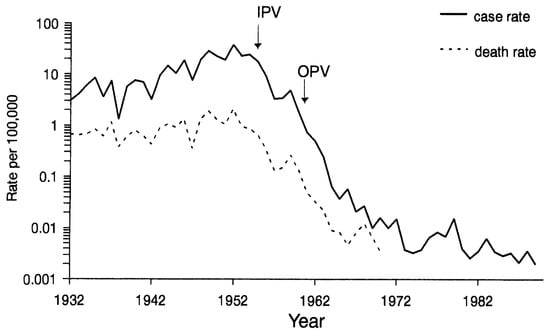
Figure 40.
Reported rates of poliomyelitis, United States, 1932–1989. Surveillance for poliomyelitis in the United States started for selected states in 1910, and by 1932 all states routinely reported both cases and deaths from poliomyelitis to the U.S. Public Health Service. Initially, all cases of poliomyelitis were collectively reported, including recognized cases of nonparalytic disease. A standard case definition for poliomyelitis was introduced in 1958 [319]. The death rate was not calculated from 1971 on; the average annual number of deaths from poliomyelitis was <10 for 1970–1979 and <1 for 1980–1989. Abbreviations: IPV, inactivated polio vaccine (Salk vaccine); OPV, oral live-attenuated polio vaccine (Sabin vaccine). Sourced from Ref. [317] (p. 570) (public domain).
In 1988, a public-private partnership called the Global Polio Eradication Initiative (GPEI) was established after the World Health Assembly passed a resolution to eradicate poliomyelitis worldwide [320,321,322,323,324,325,326]; at that time, there were an estimated 350,000 cases in more than 125 endemic countries, but polio cases have decreased by over 99% since then. Poliomyelitis due to wild-type virus has now been eliminated from the Americas, Europe, and the Western Pacific, and there are markedly fewer cases in Africa and Asia [320]. Poliomyelitis remains endemic in Afghanistan and Pakistan, where the spread of poliovirus has been exacerbated by the social, healthcare, and economic disruption associated with territorial conflicts and the COVID-19 pandemic, which together have seriously disrupted surveillance and vaccination activities [320,327,328,329,330,331,332,333,334]. In addition, circulating vaccine-derived poliovirus (cVDPV) outbreaks continue to be reported, particularly in Africa. Unfortunately, some areas that are currently free from wild-type poliovirus have maintained insufficient vaccine coverage to ensure that they remain polio-free.
Funding
This research received no external funding.
Conflicts of Interest
The author declares no conflicts of interest.
Abbreviations
The following abbreviations are used in this manuscript:
| IPV | inactivated polio vaccine (Salk vaccine) |
| OPV | oral live-attenuated polio vaccine (Sabin vaccine) |
References
- Fishbein, M.; Hektoen, L.; Salmonsen, E.M. A Bibliography of Infantile Paralysis: 1789–1944, with Selected Abstracts and Annotations; J.B. Lippincott Co.: Philadelphia, PA, USA, 1946. [Google Scholar]
- Lanska, D.J. The Dercum-Muybridge collaboration for sequential photography of neurologic disorders. Neurology 2013, 81, 1550–1554. [Google Scholar] [CrossRef]
- Lanska, D.J. The historical origins of stroke rehabilitation. In Stroke Recovery and Rehabilitation, 2nd ed.; Stein, J., Harvey, R., Winstein, C., Zorowitz, R., Wittenberg, G.F., Eds.; Demos Publishing Co.: New York, NY, USA, 2015; pp. 3–32. [Google Scholar]
- Lanska, D.J. A human quadrupedal gait following poliomyelitis: From the Dercum-Muybridge collaboration (1885). Neurology 2016, 86, 872–876. [Google Scholar] [CrossRef] [PubMed]
- Landsteiner, K.; Popper, E. Übertragung der Poliomyelitis acuta auf Affen. Z. Immunitätsforsch. Exp. Ther. 1909, 2, 377–390. [Google Scholar]
- Flexner, S.; Lewis, P.A. The nature of the virus of epidemic poliomyelitis. JAMA 1909, 53, 2095. [Google Scholar] [CrossRef]
- Badham, J. Paralysis in childhood: Four remarkable cases of suddenly induced paralysis in the extremities, occurring in children, without any apparent cerebral or cerebro-spinal lesions. Lond. Med. Gaz. 1835, 17, 215–218. [Google Scholar]
- Colmer, G. Paralysis in teething children. Am. J. Med. Sci. 1843, 5, 248. [Google Scholar]
- Casey, A.; Hidden, E.H. George Colmer and the epidemiology of poliomyelitis. South. Med. J. 1944, 37, 471–477. [Google Scholar] [CrossRef]
- Ivey, W.P. An epidemic of poliomyelitis. Carol. Med. J. 1900, 45, 181–183. [Google Scholar]
- Holt, L.E.; Bartlett, F.H. The epidemiology of acute poliomyelitis. Am. J. Med. Soc. 1908, 135, 647–662. [Google Scholar] [CrossRef]
- Starr, M.A. Epidemic infantile paralysis. JAMA 1908, 51, 112–120. [Google Scholar] [CrossRef]
- Anonymous. The early accounts of epidemic poliomyelitis. JAMA 1908, 50, 699. [Google Scholar]
- DeBuys, L.B. The medical aspects of anterior poliomyelitis. New Orleans Med. Surg. J. 1909, 62, 736–746. [Google Scholar]
- Hamilton, A.S. Epidemic anterior poliomyelitis. J. Minn. State Med. Soc. 1909, 29, 423–428. [Google Scholar]
- Frost, W.H. Acute Anterior Poliomyelitis (Infantile Paralysis): A Précis; Public Health Bulletin No. 44; Government Printing Office: Washington, DC, USA, 1911.
- Sever, J.W. Anterior poliomyelitis: A review of the recent literature in regard to the epidemiology, etiology, modes of transmission, bacteriology and pathology. In [Massachusetts] State Board of Health: Infantile Paralysis in Massachusetts, 1907–1912. Together with Reports of Special Investigations in 1913, Bearing upon the Etiology of the Disease and the Method of its Transmission; Wright & Potter Printing, State Printers: Boston, MA, USA, 1914; pp. 4–47. [Google Scholar]
- Trevelyan, B.; Smallman-Raynor, M.; Cliff, A.D. The spatial dynamics of poliomyelitis in the United States: From epidemic emergence to vaccine-induced retreat, 1910–1971. Ann. Assoc. Am. Geogr. 2005, 95, 269–293. [Google Scholar] [CrossRef] [PubMed]
- Von Heine, J. Beobachtungen über Lähmungszustände der Untern Extremitäten und Deren Behandlung; Köhler, F.H., Ed.; Stuttgart, Köhler: Stuttgart, Germany, 1840. [Google Scholar]
- Nathanson, N.; Martin, J.R. The epidemiology of poliomyelitis: Enigmas surrounding its appearance, epidemicity, and disappearance. Am. J. Epidemiol. 1979, 110, 672–692. [Google Scholar] [CrossRef] [PubMed]
- Nathanson, N.; Kew, O.M. From emergence to eradication: The epidemiology of poliomyelitis. Am. J. Epidemiol. 2010, 172, 1213–1229. [Google Scholar] [CrossRef]
- Hammond, W.A. On the treatment of a certain form of paralysis occurring in children. N. Y. Med. J. 1866, 2, 168–174. [Google Scholar] [CrossRef]
- Hammond, W.A. Lectures on the pathology and treatment of infantile paralysis: Delivered before the New York Journal Association. Med. Surg. Rep. 1867, 16, 369–371. [Google Scholar]
- Hammond, W.A. The pathology and treatment of organic paralysis. Q. J. Psychol. Med. Med. Jurisprud. 1867, 1, 49–66. [Google Scholar]
- Hammond, W.A. Further remarks on organic infantile paralysis. Q. J. Psychol. Med. Med. Jurisprud. 1868, 2, 531–534. [Google Scholar]
- Hammond, W.A. Organic infantile paralysis. In A Treatise on Diseases of the Nervous System; D. Appleton and Company: New York, NY, USA, 1871; pp. 689–699. [Google Scholar]
- Sartin, J.S.; Lanska, D.J. Surgeon General William A. Hammond (1828–1900): Successes and failures of medical leadership. Gunderson Lutheran Med. J. 2008, 5, 21–28. [Google Scholar]
- Lanska, D.J. William Alexander Hammond. In Encyclopedia of the Neurological Sciences, 2nd ed.; Aminoff, M.J., Daroff, R.B., Eds.; Academic Press/Elsevier: Oxford, UK, 2014; Volume 2, pp. 502–506. [Google Scholar]
- Goetz, C.G.; Chmura, T.A.; Lanska, D.J. The history of 19th century neurology and the American Neurological Association. In History of the American Neurological Association in Celebration of Its 125th Anniversary: Tempus et Hora: Time and the Hour; Goetz, C.G., Ed.; American Neurological Association: Mount Laurel, NJ, USA, 2003; Volume 53, (Suppl. S4), pp. S2–S26. [Google Scholar]
- Lanska, D.J. From the AAN History Library Collection: Hammond’s A Treatise on Diseases of the Nervous System (1871). Neurology 2009, 72, 49. [Google Scholar]
- Hall, H.B. Engraving of William A. Hammond; Charles Robson: Philadelphia, PA, USA; National Library of Medicine: Bethesda, Maryland, 1877. Available online: https://collections.nlm.nih.gov/catalog/nlm:nlmuid-101417833-img (accessed on 29 July 2025).
- Seguin, E.C. Infantile spinal paralysis: A lecture delivered at the College of Physicians and Surgeons, New York [Nov. 8, 1873]. Med. Rec. 1874, 9, 25–29. [Google Scholar]
- Dana, C.L. The Seguins of New York: Their careers and contributions to science and education. Ann. Med. Hist. 1924, 6, 475–479. [Google Scholar] [PubMed]
- Lanska, D.J. Edward Constant Seguin. In Encyclopedia of the Neurological Sciences, 2nd ed.; Aminoff, M.J., Daroff, R.B., Eds.; Academic Press/Elsevier: Oxford, UK, 2014; Volume 4, pp. 121–122. [Google Scholar]
- Mills, C.K. Wharton Sinkler, M.D. J. Nerv. Ment. Dis. 1910, 37, 334–337. [Google Scholar] [CrossRef]
- Sinkler, W. On the palsies of children. Am. J. Med. Sci. 1875, 69, 348–365. [Google Scholar] [CrossRef]
- Dana, C.L. Text-Book of Nervous Diseases; William Wood and Company: New York, NY, USA, 1892. [Google Scholar]
- Putnam, J.J.; Taylor, E.W. Is acute poliomyelitis unusually prevalent this season? Boston Med. Surg. J. 1893, 129, 509–510. [Google Scholar] [CrossRef]
- Sinkler, W.R. Poliomyelitis anterior. In Cyclopaedia of the Diseases of Children: Medical and Surgical: The Articles Written Especially for the Work by American, British, and Canadian Authors. Vol. IV.; Keating, J.M., Ed.; J.B. Lippincott: Philadelphia, PA, USA, 1890; pp. 683–715. [Google Scholar]
- Sinkler, W. The etiology of epidemic poliomyelitis. Arch. Diagn. 1908, 1, 28–31. [Google Scholar]
- Sinkler, W. Epidemics of poliomyelitis in Philadelphia. J. Nerv. Ment. Dis. 1908, 35, 260. [Google Scholar] [CrossRef]
- Taylor, J.M. An epidemic of poliomyelitis. Phil. Med. J. 1898, 1, 208–210. [Google Scholar]
- Anonymous. Edward Wyllis Taylor [obituary]. N. Engl. J. Med. 1932, 207, 377–379. [Google Scholar] [CrossRef]
- Denny-Brown, D. James Jackson Putnam: 1846–1918. In Centennial Anniversary Volume of the American Neurological Association: 1875–1975; Denny-Brown, D., Rose, A.S., Sahs, A.L., Eds.; Springer Publishing Co.: New York, NY, USA, 1975; pp. 86–91. [Google Scholar]
- Lanska, D.J. James Jackson Putnam. In Encyclopedia of the Neurological Sciences, 2nd ed.; Aminoff, M.J., Daroff, R.B., Eds.; Academic Press/Elsevier: Oxford, UK, 2014; Volume 3, pp. 1019–1021. [Google Scholar]
- Taylor, E.W. James Jackson Putnam: His contributions to American neurology. Arch. Neurol. Psych. 1920, 3, 307–314. [Google Scholar] [CrossRef]
- Emerson, L.E. Dr. James Jackson Putnam. J. Nerv. Ment. Dis. 1919, 49, 269–271. [Google Scholar] [CrossRef]
- Tilney, F.; Jelliffe, S.E. Semi-Centennial Anniversary Volume of the American Neurological Association: 1875–1924; American Neurological Association: Mount Laurel, NJ, USA, 1924. [Google Scholar]
- Barlow, W.H. On Regressive Paralysis (Infantile Paralysis, Spinal Paralysis of Adults); J.E. Cornish: Manchester, UK, 1878. [Google Scholar]
- Gowers, W.R. A Manual of Diseases of the Nervous System: Diseases of the Nerves and Spinal Cord, 2nd ed.; J. & A. Churchill: London, UK, 1892; Volume 1, pp. 350–378. [Google Scholar]
- Starr, M.A. Poliomyelitis anterior acuta. In A System of Medicine by Many Writers; Allbutt, C., Ed.; MacMillan and Co.: London, UK, 1905; Volume 7, pp. 186–206. [Google Scholar]
- Starr, M.A. Acute poliomyelitis. In A System of Medicine by Many Writers; Allbutt, C., Rolleston, H.D., Eds.; MacMillan and Co.: London, UK, 1911; Volume 7, pp. 623–644. [Google Scholar]
- Lovett, R.W.; Lucas, W.P. Infantile paralysis: A study of 63 cases from the Children’s Hospital, Boston, with especial reference to treatment. JAMA 1908, 51, 1677–1684. [Google Scholar] [CrossRef]
- Rutkow, I.M. The History of Surgery in the United States: 1775–1900: Textbooks, Monographs, and Treatises (Norman Bibliography Series); Norman: San Francisco, CA, USA, 1988; Volume 1. [Google Scholar]
- Lovett, R.W. The occurrence of infantile paralysis in Massachusetts in 1909. Mon. Bull. State Board. Health Mass. 1910, 5, 175–208. [Google Scholar] [CrossRef]
- Caverly, C.S. Preliminary report of an epidemic of paralytic disease, occurring in Vermont, in the summer of 1894. Yale Med. J. 1894, 1, 1–5. [Google Scholar]
- Caverly, C.S. History of an epidemic of acute nervous disease of unusual type. Med. Rec. 1894, 46, 673–677. [Google Scholar]
- Caverly, C.S. Notes of an epidemic of acute anterior poliomyelitis. JAMA 1896, 26, 1–5. [Google Scholar] [CrossRef]
- MacPhail, A. An epidemic of paralysis in children, with a report of one hundred and twenty cases. Med. News 1894, 65, 619–625. [Google Scholar]
- Dana, C.L. Acute poliomyelitis in a hen. N. Y. Med. J. 1895, 60, 824–825. [Google Scholar]
- Watson, I.A. Caverly, Charles Solomon. In A Collection of Biographical Sketches of the Regular Medical Profession; Republican Press Association: Concord, NH, USA, 1896; p. 98. [Google Scholar]
- Caverly, C.S. Contributions of Charles S. Caverly, M.D. In Infantile Paralysis in Vermont: 1894–1922, A Memorial to Charles S. Caverly, M.D.; Caverly, C.S., Lovett, R.W., Martin, E.G., Weisbrod, B.E., Aycock, W.L., Amoss, H.L., Taylor, E., Eds.; State Department of Public Health: Burlington, VT, USA, 1924; pp. 15–200. [Google Scholar]
- Lovett, R.W.; Martin, E.G.; Weisbrod, B.E.; Aycock, W.L.; Amoss, H.L.; Taylor, E. Contributions of the after-care department. In Infantile Paralysis in Vermont: 1894–1922, A Memorial to Charles S. Caverly, M.D.; Caverly, C.S., Lovett, R.W., Martin, E.G., Weisbrod, B.E., Aycock, W.L., Amoss, H.L., Taylor, E., Eds.; State Department of Public Health: Burlington, VT, USA, 1924; pp. 201–375. [Google Scholar]
- Lovett, R.W. Dr. Charles S. Caverly. In Infantile Paralysis in Vermont: 1894–1922, A Memorial to Charles S. Caverly, M.D.; Caverly, C.S., Lovett, R.W., Martin, E.G., Weisbrod, B.E., Aycock, W.L., Amoss, H.L., Taylor, E., Eds.; State Department of Public Health: Burlington, VT, USA, 1924; pp. 13–14. [Google Scholar]
- Anonymous. Moses Allen Starr, M.D. [obituary]. Bull. N. Y. Acad. Med. 1932, 8, 591. [Google Scholar]
- Peterson, F. Obituary of M. Allen Starr. Bull. N. Y. Acad. Med. 1932, 8, 677–680. [Google Scholar]
- Lanska, D.J. Charles Loomis Dana. In Encyclopedia of the Neurological Sciences, 2nd ed.; Aminoff, M.J., Daroff, R.B., Eds.; Academic Press/Elsevier: Oxford, UK, 2014; Volume 1, pp. 930–934. [Google Scholar]
- Bain News Service. Photograph of Prof. Geo. McAneny and Dr. Jacobi, 1912. The Image Has Been Cropped from the Original. George Grantham Bain Collection, Library of Congress Prints and Photographs Division, Washington, D.C. Available online: https://www.loc.gov/item/2014690785/ (accessed on 29 July 2025).
- Middlebury College Trustee. Photograph of Moses Allen Starr, Before 1915, Probably c1900. Middlebury College Special Collections, Middlebury, Vermont. CC BY 4.0 License (https://creativecommons.org/licenses/by/4.0/legalcode). Available online: https://archive.org/details/middpf_a1pf_starrm_01 (accessed on 29 July 2025).
- Louis Alman & Co. Photograph of Charles L. Dana, c1910; Berlin Publishing Company: New York, NY, USA; National Library of Medicine: Bethesda, Maryland, 1910. Available online: https://collections.nlm.nih.gov/catalog/nlm:nlmuid-101412415-img (accessed on 29 July 2025).
- Dercum, F.X. Note on a case of acute poliomyelitis: In which the cerebrospinal fluid obtained by a Quincke puncture contained a diplococcus resembling the diplococcus of Sternberg. J. Nerv. Ment. Dis. 1900, 27, 116–117. [Google Scholar]
- Harbitz, F.; Scheel, O. Pathologisch-Anatomische Untersuchungen über akute Poliomyelitis und Verwandte Krankheiten von den Epidemien in Norwegen 1903–1906; Jacob Dybwad: Christiania, Oslo, Norway, 1907. [Google Scholar]
- Harbitz, F.; Scheel, O. Epidemic acute poliomyelitis in Norway in the years 1903 to 1906. Result sof anatomic investigation of nineteen cases of acute poliomyelitis and kindred conditions. JAMA 1907, 49, 1420–1425. [Google Scholar] [CrossRef]
- Harbitz, F.; Scheel, O. The microbe of poliomyelitis. JAMA 1908, 50, 281. [Google Scholar] [CrossRef]
- Quincke, H.I. Die Lumbarlpunction des Hydrocephalus. Berl. Klin. Wochenschr. 1891, 28, 929–933, 965–968. [Google Scholar]
- Lanska, D.J. Francis Xavier Dercum. In Encyclopedia of the Neurological Sciences, 2nd ed.; Aminoff, M.J., Daroff, R.B., Eds.; Academic Press/Elsevier: Oxford, UK, 2014; Volume 1, pp. 983–987. [Google Scholar]
- Lanska, D.J. William Williams Keen. In Encyclopedia of the Neurological Sciences, 2nd ed.; Aminoff, M.J., Daroff, R.B., Eds.; Academic Press/Elsevier: Oxford, UK, 2014; Volume 2, pp. 788–791. [Google Scholar]
- Francis X. Dercum. National Library of Medicine, Bethesda, Maryland. Available online: https://collections.nlm.nih.gov/catalog/nlm:nlmuid-101413559-img (accessed on 29 July 2025).
- Duval, C.W. Anterior poliomyelitis: Etiology and pathology. New Orleans Med. Surg. J. 1909, 62, 746–749. [Google Scholar]
- Rous, F.P. Simon Flexner, 1863–1946. Obit. Not. Fellows R. Soc. 1949, 6, 408–445. [Google Scholar]
- Anonymous. The march of events. World’s Work. 1904, 9, 5548–5565. [Google Scholar]
- Flexner, S. The contribution of experimental to human poliomyelitis. JAMA 1910, 55, 1105–1113. [Google Scholar] [CrossRef]
- Loeffler, F. Untersuchungen über die Bedeutung der Mikroorganismen für die Entstehung der Diptherie beim Menschen, bei der Taube und beim Kalbe. Mitth. Aus Dem Kais. Gesundheitsamte 1884, 51, 421–499. [Google Scholar]
- Koch, R. Ueber bakteriologische Forschung. In Verhandlungen des X. Internationalen Medicinischen Kongreß: Berlin, 4.-9. August 1890/Herausgegeben von dem Redactionscomité; August Hirschwald: Berlin, Germany, 1891; Band I; pp. 35–47. [Google Scholar]
- Evans, A.S. Causation and disease: The Henle-Koch postulates revisited. Yale J. Biol. Med. 1976, 49, 175–195. [Google Scholar] [PubMed]
- Evans, A.S. Causation and disease: A chronological journey. The Thomas Parran Lecture. Am. J. Epidemiol. 1978, 108, 249–258. [Google Scholar] [CrossRef] [PubMed]
- Evans, A.S. Causation and disease: Effect of technology on postulates of causation. Yale J. Biol. Med. 1991, 64, 513–528. [Google Scholar] [PubMed]
- Evans, A.S. Causation and Disease; Springer: Boston, MA, USA, 1993. [Google Scholar]
- Carter, K.C. Koch’s postulates in relation to the work of Jacob Henle and Edwin Klebs. Med. Hist. 1985, 29, 353–374. [Google Scholar] [CrossRef] [PubMed]
- Tanaka, Y. Koch’s technologies and postulates: How they work together in connecting the material and the human in the foundation of bacteriology. Zinbun Mem. Res. Inst. Humanist. Stud. Kyoto 2011, 42, 147–159. [Google Scholar]
- Blevins, S.M.; Bronze, M.S. Robert Koch and the ‘golden age’ of bacteriology. Int. J. Infect. Dis. 2010, 14, e744–e751. [Google Scholar] [CrossRef]
- Walker, L.; Levine, H.; Jucker, M. Koch’s postulates and infectious proteins. Acta Neuropathol. 2006, 112, 1–4. [Google Scholar] [CrossRef]
- Rosenow, E.C.; Towne, E.B.; Wheeler, G.W. The etiology of epidemic poliomyelitis: Preliminary note. JAMA 1916, 67, 1202–1205. [Google Scholar] [CrossRef]
- Rosenow, E.C. The production of an antipoliomyelitis serum in horses: By inoculations of the pleomorphic streptococcus from poliomyelitis. JAMA 1917, 69, 261–266. [Google Scholar] [CrossRef]
- Eckman, J. Edward Carl Rosenow, M.D.: 1875–1966. Am. J. Clin. Pathol. 1966, 46, 123–124. [Google Scholar] [CrossRef] [PubMed]
- Collective Investigation Committee (Sachs, B., Chairman). Report of the Collective Investigation Committee of the New York Neurological Society, with the cooperation of the Committee appointed by the Setion on Pediatrics of the New York Academy of Medicine, and the New York Board of Health, on the poliomyelitis epidemic of 1907. J. Nerv. Ment. Dis. 1909, 36, 619–625. [Google Scholar]
- Collective Investigation Committee (Sachs, B., Chairman; Clark, L.P.; Terriberry, J.F.; Hunt, J.R.; Jelliffe, S.E.; Strauss, I.; Zabriskie, E.G.; La Fetra, L.L.; Schwarz, H.; Ager, L.C.; et al.) Epidemic Poliomyelitis: Report on the New York Epidemic of 1907. In Nervous and Mental Disease Monograph Series No. 6; The Journal of Nervous and Mental Diseases Publishing Company: New York, NY, USA, 1910. [Google Scholar]
- Frost, W.H. The field investigation of epidemic poliomyelitis (what the health officer can do toward solving a national problem. Public. Health Rep. 1910, 25, 1663–1676. [Google Scholar] [CrossRef]
- Bernard Sachs, M.D. (1858–1944): Neurologist. National Library of Medicine. Available online: https://www.nlm.nih.gov/hmd/topics/diseases-of-mind/bio-bernard-sachs.html?imgid=8#ph (accessed on 29 July 2025).
- Lovett, R.W. The work of the Massachusetts State Board of Health in the investigation of infantile paralysis. Boston Med. Surg. J. 1913, 168, 109–112. [Google Scholar] [CrossRef]
- Anonymous. Obituary: R.W. Lovett, M.D., Professor of Orthopaedic Surgery, Harvard, U.S.A. BMJ 1924, 2, 85. [Google Scholar]
- Anonymous. Anterior poliomyelitis, trachoma and ophthalmia neonatorum [declared “dangerous to public health”]. Mon. Bull. State Board. Health Mass. 1912, 7, 14. [Google Scholar]
- Collins, H. The epidemiology of poliomyelitis: A plea that it may be considered a reportable quarantinable disease. JAMA 1910, 54, 1925–1928. [Google Scholar] [CrossRef]
- Lanska, D.J. Joseph Collins. In Encyclopedia of the Neurological Sciences, 2nd ed.; Aminoff, M.J., Daroff, R.B., Eds.; Academic Press/Elsevier: Oxford, UK, 2014; Volume 1, pp. 827–828. [Google Scholar]
- Lovett, R.W. The occurrence of infantile paralysis in Massachusetts in 1907. JAMA 1908, 159, 131–139. [Google Scholar] [CrossRef][Green Version]
- Lovett, R.W. A study of poliomyelitis in Massachusetts in 1907 and 1908. J. Nerv. Ment. Dis. 1909, 36, 681–684. [Google Scholar][Green Version]
- Lovett, R.W. The occurrence of infantile paralysis in Massachusetts in 1908 (second paper). Reported for the Massachusetts State Board of Health. Boston Med. Surg. J. 1909, 161, 112–115. [Google Scholar] [CrossRef]
- Lovett, R.W. The occurrence of infantile paralysis in Massachusetts in 1909. Boston Med. Surg. J. 1910, 163, 37–55. [Google Scholar] [CrossRef]
- Lovett, R.W.; Richardson, M.W. Infantile paralysis with special reference to its occurrence in Massachusetts, 1907–1910. Am. J. Dis. Child. 1911, 2, 369–406. [Google Scholar]
- Lovett, R.W.; Sheppard, P.A.E. The occurrence of infantile paralysis in Massachusetts in 1910. Mon. Bull. State Board. Health Mass. 1911, 6, 132–144. [Google Scholar] [CrossRef]
- Lovett, R.W.; Richardson, M.W. Infantile paralysis with special reference to its occurrence in Massachusetts, 1907–1910. In Infantile Paralysis in Massachusetts During 1910, Together with Reports of Special Investigations Made in 1911 Bearing upon the Etiology of the Disease and the Method of its Transmission; Wright & Potter Printing Co., State Printers: Boston, MA, USA, 1912; pp. 55–94. [Google Scholar]
- Richardson, M.W. Recent contributions to our knowledge concerning infantile paralysis. Mon. Bull. State Board. Health Mass. 1912, 7, 151–155. [Google Scholar] [CrossRef] [PubMed]
- Richardson, M.W. The occurrence of infantile paralysis in Massachusetts, 1907–1912. Mon. Bull. State Board. Health Mass. 1912, 7, 308–314. [Google Scholar]
- Richardson, M.W. The occurrence of infantile paralysis in Massachusetts, 1907–1912. In [Massachusetts] State Board of Health. Infantile Paralysis in Massachusetts, 1907–1912. Together with Reports of Special Investigations in 1913, Bearing upon the Etiology of the Disease and the Method of Its Transmission; Wright & Potter Printing Co., State Printers: Boston, MA, USA, 1914; pp. 48–54. [Google Scholar]
- Forsbeck, F.C.; Luther, E.H. Anterior poliomyelitis in Massachusetts, 1907–1929. N. Engl. J. Med. 1930, 203, 1115–1121. [Google Scholar] [CrossRef]
- Paireau, J.; Chen, A.; Broutin, H.; Grenfell, B.; Basta, N.E. Seasonal dynamics of bacterial meningitis: A time-series analysis. Lancet Glob. Health 2016, 4, e370–e377. [Google Scholar] [CrossRef]
- Clark, D.E. (Ed.) The European Discovery of American Surgery. Volume 2, Surgical “Mecca”; University of California Health Humanities Press: San Francisco, CA, USA, 2024. [Google Scholar]
- Holt, E. Previous epidemics of poliomyelitis. Med. Rec. 1907, 135, 874. [Google Scholar]
- Dunn, P.M. Dr Emmett Holt (1855−1924) and the foundation of North American paediatrics. Arch. Dis. Child. Fetal Neonatal Ed. 2000, 83, F221–F223. [Google Scholar] [CrossRef]
- Medin, O. En epidemi af infantil paralysi. Hygiea 1890, 52, 657–668. [Google Scholar]
- Batten, F.E. The epidemiology of poliomyelitis. Proc. R. Soc. Med. 1911, 4, 198–221. [Google Scholar] [CrossRef]
- Luther, E. Holt. National Library of Medicine, Bethesda, Maryland. Available online: https://collections.nlm.nih.gov/catalog/nlm:nlmuid-101418946-img (accessed on 29 July 2025).
- Lavinder, C.H. Status of poliomyelitis in New York City. Public. Health Rep. 1916, 31, 2407–2411. [Google Scholar] [CrossRef]
- Department of Health (New York City). A Monograph on the Epidemic of Poliomyelitis (Infantile Paralysis) in New York City in 1916, Based on the Official Reports of the Bureaus of the Department of Health; New York City Department of Health: New York, NY, USA, 1917.
- Lavinder, C.H.; Freeman, A.W.; Frost, W.H. Epidemiological Studies of Poliomyelitis in New York City and North Eastern United States During the Year 1916; U.S. Public Health Bulletin No. 91; Government Printing Office: Washington, DC, USA, 1918. [Google Scholar]
- Laidlaw, F.W. Poliomyelitis in the state of New York in 1931, A preliminary report of a study of 1,539 cases. JAMA 1932, 99, 1053–1057. [Google Scholar] [CrossRef]
- Levinson, S.O.; McDougall, C.; Thalhimer, W. Acute anterior poliomyelitis in the Chicago area in 1931, Symptomatology, clinical observations and convalescent serum therapy. JAMA 1932, 99, 1058–1062. [Google Scholar] [CrossRef]
- Rucker, W.C. Notification of poliomyelitis. Public Health Rep. 1911, 26, 1602–1608. [Google Scholar] [CrossRef]
- Serfling, R.E.; Sherman, I.L. Poliomyelitis distribution in the United States. Public Health Rep. 1953, 68, 453–466. [Google Scholar] [CrossRef] [PubMed]
- Centers for Disease Control. Mandatory reporting of infectious diseases by clinicians. MMWR 1990, 39, 1–17. [Google Scholar]
- Seguin, E.C. Spinal paralysis of the adult; acute, subacute, and chronic (inflammation of the motor tract of the spinal cord). Trans. N. Y. Acad. Med. 1874, 1, 43–79. [Google Scholar]
- Lincoln, D.F. A case of spinal paralysis in an adult, resembling the so-called infantile paralysis. Boston Med. Surg. J. 1875, 92, 339–344. [Google Scholar] [CrossRef]
- Sinkler, W. Five cases of spinal paralysis of the adult. Am. J. Med. Sci. 1878, 75, 379–386. [Google Scholar] [CrossRef]
- Du Hadway, C. On muscular paralysis, especially that kind peculiar to children. Trans. Ill. Med. Soc. 1882, 32, 232–236. [Google Scholar]
- Putnam, J.J. Examination of the spinal cord in a case of poliomyelitis of the adult of two months’ standing. J. Nerv. Ment. Dis. 1883, 10, 14–25. [Google Scholar] [CrossRef]
- Ranney, A.L. A unique case of poliomyelitis anterior acute of the adult. Arch. Med. 1884, 12, 67–70. [Google Scholar]
- Van Doyn, J. A case of acute poliomyelitis in the adult. Arch. Med. 1884, 12, 64–66. [Google Scholar]
- Eliot, G. Poliomyelitis anterior in adults. Am. J. Med. Sci. 1885, 89, 138–146. [Google Scholar] [CrossRef]
- Rockwell, A.D. Poliomyelitis anterior in the adult. Med. Rec. 1885, 27, 205. [Google Scholar]
- Krauss, W.C. Polio-myelitis acuta adultorum. J. Nerv. Ment. Dis. 1891, 16, 704–708. [Google Scholar] [CrossRef]
- Bachrach Photographey Studios. Wade H. Frost. National Library of Medicine, Bethesda, Maryland. A Black and White Version of this Photograph. Available online: https://collections.nlm.nih.gov/catalog/nlm:nlmuid-101415577-img (accessed on 29 July 2025).
- Galbraith, A.M. Poliomyelitis anterior acuta infantilis: Its etiology and treatment. A clinical study of 75 cases. Am. J. Obstet. 1893, 28, 816–831. [Google Scholar]
- Brackett, E.G. Epidemic infantile paralysis. Trans. Am. Orthop. Assoc. 1898, 11, 132–142. [Google Scholar]
- Hill, H.W. The contagiousness of poliomyelitis. J. Minn. State Med. Assoc. Northwestern Lancet 1910, 30, 111–114. [Google Scholar]
- Frost, W.H. Epidemiologic Studies of Acute Anterior Poliomyelitis: (1) Poliomyelitis in Iowa, 1910, (2) Poliomyelitis in Cincinnati, 1911, (3) Poliomyelitis in Buffalo and Batavia, NY, 1912; Hygienic Laboratory Bulletin No. 90; Government Printing Office: Washington, DC, USA, 1913.
- Wickman, I. Die akute Poliomyelitis bzw. In Heine-Medinsche Krankheit; Springer: Berlin, Germany, 1911. [Google Scholar]
- Wickman, I. Acute poliomyelitis (Heine-Medin’s disease). In Nervous and Mental Disease Monograph Series No. 16; Authorized English translation by Dr. J. Wm. J. A. M. Maloney, F.R.S. Ed.; The Journal of Nervous and Mental Disease Publishing Company: New York, NY, USA, 1913. [Google Scholar]
- Paul, J.R. A History of Poliomyelitis; Yale University Press: New Haven and London, UK, 1971. [Google Scholar]
- Emerson, H.C. An epidemic of infantile paralysis in western Massachusetts in 1908. Boston Med. Surg. J. 1909, 161, 115–119. [Google Scholar] [CrossRef]
- Hill, H.W. The epidemiology of anterior poliomyelitis. J. Minn. State Med. Assoc. Northwestern Lancet 1909, 29, 369–374. [Google Scholar]
- Hill, H.W. Discussion of papers on poliomyelitis at the meeting of the Minnesota State Medical Association. Trans. Minn. Med. Assoc. 1910, 30, 5–6. [Google Scholar]
- Frost, W.H. Some factors in the epidemiology of poliomyelitis. Am. J. Public. Health 1913, 3, 216–221. [Google Scholar] [CrossRef]
- Anonymous. Herbert Clark Emerson, M.D. [obituary]. Boston Med. Surg. Rep. 1922, 187, 969–970. [Google Scholar] [CrossRef]
- Anderson, J.F.; Frost, W.H. Abortive cases of poliomyelitis: An experimental demonstration of specific immune bodies in their blood-serum. JAMA 1911, 56, 663–667. [Google Scholar] [CrossRef]
- Rosenau, M.J. The mode of transmission of poliomyelitis. In [Massachusetts] State Board of Health. Infantile Paralysis in Massachusetts, 1907–1912. Together with Reports of Special Investigations in 1913, Bearing upon the Etiology of the Disease and the Method of Its Transmission; Wright & Potter Printing, State Printers: Boston, MA, USA, 1914; pp. 86–95. [Google Scholar]
- C.H. Lavinder. San Juan, Porto Rico [Puerto Rico]: United States Quarantine Station, c1900. National Library of Medicine, Bethesda, Maryland. Available online: https://collections.nlm.nih.gov/catalog/nlm:nlmuid-101448052-img (accessed on 29 July 2025).
- Flexner, S. The relation of experimental to human poliomyelitis. Med. Rec. 1910, 78, 925–926. [Google Scholar]
- Flexner, S.; Lewis, P.A. Experimental poliomyelitis in monkeys. Seventh note: Active immunization and serum protection. JAMA 1910, 54, 1780–1782. [Google Scholar] [CrossRef]
- Flexner, S.; Lewis, P.A. Experimental poliomyelitis in monkey. Eighth note: Further contributions to the subjects of immunization and serum therapy. JAMA 1910, 55, 662–663. [Google Scholar] [CrossRef]
- Willard, D.F.; Hinsdale, G. Anterior poliomyelitis. Univ. Med. Mag. 1894, 7, 68–72, 149–151. [Google Scholar]
- Baker, J.P. Memorial: Guy Hinsdale, M.D. Trans. Am. Clin. Climatol. Assoc. 1948, 60, li–lii. [Google Scholar]
- Voleti, P.; Levin, L.S. DeForest Willard: First Charman of the Department of Orthopaedic Surgery at the University of Pennsylvania. Univ. Penn Orthop. J. 2011, 21. not paginated. [Google Scholar]
- De Forest Willard. Souvenir [Album]: Complimentary Banquet and Presentation of Loving Cup to Dr. Robert Fletcher, by His Friends, 11 January 1906; p. 130. National Library of Medicine, Bethesda, Maryland. Available online: https://collections.nlm.nih.gov/catalog/nlm:nlmuid-101440527-img (accessed on 29 July 2025).
- Guy Hinsdale. National Library of Medicine, Bethesda, Maryland. Available online: https://collections.nlm.nih.gov/catalog/nlm:nlmuid-101418598-img (accessed on 29 July 2025).
- Olin, G. The epidemiologic pattern of poliomyelitis in Sweden from 1905 to 1950. In Poliomyelitis: Papers and Discussions Presented at the Second International Poliomyelitis Conference; Lippincott: Philadelphia, PA, USA, 1952; pp. 367–375. [Google Scholar]
- Rous, F.P. Karl Landsteiner, 1868–1943. Obit. Not. Fellows R. Soc. 1947, 5, 294–324. [Google Scholar]
- Eggers, H.J. Milestones in early poliomyelitis research (1840–1949). J. Virol. 1999, 73, 4533–4535. [Google Scholar] [CrossRef] [PubMed]
- Strauss, I.; Huntoon, F.M. Experimental studies on the etiology of acute poliomyelitis. N. Y. Med. J. 1910, 91, 64–71. [Google Scholar]
- Strauss, I.; Huntoon, F.M. Further contribution to the study of poliomyelitis acuta. J. Nerv. Ment. Dis. 1910, 37, 117–118. [Google Scholar] [CrossRef]
- Flexner, S.; Lewis, P.A. The transmission of acute poliomyelitis to monkeys. JAMA 1909, 53, 1639. [Google Scholar] [CrossRef]
- Flexner, S.; Lewis, P.A. The transmission of epidemic poliomyelitis to monkeys: A further note. JAMA 1909, 53, 1913. [Google Scholar] [CrossRef]
- Flexner, S.; Lewis, P.A. A report on experimental poliomyelitis. Proc. Soc. Exp. Biol. Med. 1909, 7, 49. [Google Scholar] [CrossRef]
- Anonymous. The transmission of acute poliomyelitis to monkeys. JAMA 1909, 53, 1646. [Google Scholar] [CrossRef]
- Anonymous. The award of the Nobel Prize in medicine. Pop. Sci. Mon. 1912, 81, 615–617. [Google Scholar]
- Kling, C.; Pettersson, A.; Wernstedt, W. Experimental and pathological investigations: I. The presence of the microbe of infantile paralysis in human beings. In Investigations on Epidemic Infantile Paralysis: Report from the State Medical Institute of Sweden to the XV International Congress on Hygiene and Demography, Washington, 1912; Translation into English by Alfred V. Rosen; The State Medical Institute: Stockhom, Sweden, 1912; Volume 3, pp. 5–167. [Google Scholar]
- Flexner, S.; Lewis, P.A. Epidemic poliomyelitis in monkeys: The activity of the virus. JAMA 1910, 54, 45–46. [Google Scholar] [CrossRef]
- Flexner, S.; Lewis, P.A. Epidemic poliomyelitis in monkeys: A mode of spontaneous infection. JAMA 1910, 54, 535. [Google Scholar] [CrossRef]
- Flexner, S.; Lewis, P.A. Experimental epidemic poliomyelitis in monkeys: Sixth note: Characteristic alterations of the cerebrospinal fluid and its early infectivity; Infection from human mesenteric lymph node. JAMA 1910, 54, 1140. [Google Scholar] [CrossRef]
- Flexner, S.; Lewis, P.A. Experimental epidemic poliomyelitis in monkeys. J. Exp. Med. 1910, 12, 227–255. [Google Scholar] [CrossRef]
- Flexner, S.; Clark, P.F. Experimental poliomyelitis in monkeys: Ninth note: Immunity principles; Effects of hexamethylenamin (urotropin); Early diagnosis; Virus-carriers. JAMA 1911, 56, 585–587. [Google Scholar] [CrossRef]
- Flexner, S.; Clark, P.F. Epidemic poliomyelitis: Eleventh note: Relation of the virus to the tonsils, blood and cerebrospinal fluid; Races of the virus. JAMA 1911, 57, 1685–1686. [Google Scholar] [CrossRef]
- Flexner, S. The mode of infection in epidemic poliomyeltitis. JAMA 1912, 59, 1371–1372. [Google Scholar] [CrossRef]
- Flexner, S.; Clark, P.F.; Dochez, A.R. Experimental poliomyelitis in monkeys: Thirteenth note: Survival of the poliomyelitic virus in the stomach and intestine. JAMA 1912, 59, 273. [Google Scholar] [CrossRef]
- Flexner, S.; Clark, P.F.; Fraser, F.R. Epidemic poliomyelitis: Fourteenth note: Passive human carriage of the virus of poliomyelitis. JAMA 1913, 60, 201–202. [Google Scholar] [CrossRef]
- Flexner, S.; Noguchi, H. Experiments on the cultivation of the virus of poliomyelitis. JAMA 1913, 60, 362. [Google Scholar] [CrossRef]
- Boudreau, F.G.; Brain, C.K.; McCampbell, E.F. Acute Poliomyelitis: With Special Reference to the Disease in Ohio, and Certain Transmission Experiments; The F.J. Heer Printing Co.: Columbus, OH, USA, 1914. [Google Scholar]
- Graeme, M. Hammond, c1908. National Library of Medicine, Bethesda, Maryland. Available online: https://collections.nlm.nih.gov/catalog/nlm:nlmuid-101417861-img (accessed on 29 July 2025).
- Lovett, R.W. The occurrence of infantile paralysis in in the United States and Canada in 1910. Am. J. Dis. Child. 1911, 2, 65–74. [Google Scholar] [CrossRef][Green Version]
- Bradford, E.H.; Lovett, R.W.; Brackett, E.G.; Thorndike, A.; Soutter, R.; Osgood, R.B. Methods of treatment in infantile paralysis: Summarized by the Department of Orthopedic Surgery of the Harvard Medical School. Boston Med. Surg. J. 1910, 162, 881–893. [Google Scholar] [CrossRef]
- Bradford, E.H.; Lovett, R.W.; Brackett, E.G.; Thorndike, A.; Soutter, R.; Osgood, R.B. Methods of treatment in infantile paralysis. Mon. Bull. State Board. Health Mass. 1910, 5, 241–270. [Google Scholar]
- Brues, C.T.; Sheppard, P.A.E. The possible etiological relation of certain biting insects to the spread of acute epidemic poliomyelitis. In Infantile Paralysis in Massachusetts During 1910; Wright & Potter Printing Co., State Printers: Boston, MA, USA, 1911; pp. 138–140. [Google Scholar]
- Brues, C.T.; Sheppard, P.A.E. The possible etiologic relation of certain biting insects to the spread of infantile paralysis. Mon. Bull. Mass. State Board. Health 1911, 6, 338–340. [Google Scholar]
- Lovett, R.W.; Sheppard, P.A.E. The occurrence of infantile paralysis in Massachusetts in 1910—Reported for the Massachusetts State Board of Health. Boston Med. Surg. J. 1911, 164, 737–742. [Google Scholar] [CrossRef]
- Manning, J.V.V. Infantile paralysis—Epidemic and pandemic. Am. J. Obs. Dis. Women Child. 1911, 63, 723–735. [Google Scholar]
- Manning, J.V.V. The correlation of epidemic paralysis in animal and man. Med. Times 1912, 40, 134–136. [Google Scholar]
- Sheppard, P.A.E. A study of an epidemic of infantile paralysis (acute epidemic poliomyelitis) in Springfield, Mass., in 1910. Mon. Bull. Mass. State Board. Health 1911, 6, 95–137. [Google Scholar]
- Anderson, J.F. Transmission of poliomyelitis by means of the stable fly (Stomoxys calcitrans). In [Massachusetts] State Board of Health: Infantile Paralysis in Massachusetts, 1907–1912. Together with Reports of Special Investigations in 1913, Bearing upon the Etiology of the Disease and the Method of Its Transmission; Wright & Potter Printing, State Printers: Boston, MA, USA, 1914; pp. 58–61. [Google Scholar]
- Ten Broeck, C. Experiments to determine it paralyzed domestic animals and those associated with cases of infantile paralysis may transmit this disease. In [Massachusetts] State Board of Health: Infantile paralysis in Massachusetts, 1907–1912. Together with Reports of Special Investigations in 1913, Bearing upon the Etiology of the Disease and the Method of Its Transmission; Wright & Potter Printing, State Printers: Boston, MA, USA, 1914; pp. 99–118. [Google Scholar]
- Richardson, M.W. The rat and infantile paralysis: A theory. Boston Med. Surg. J. 1916, 175, 397–400. [Google Scholar] [CrossRef]
- Greeley, H. The bacteriology and probable means of spread of poliomyelitis. Long. Isl. Med. J. 1917, 11, 138–145. [Google Scholar]
- Amoss, H.L.; Haselbauer, P. The rat and poliomyelitis: An experimental study. J. Exp. Med. 1918, 28, 429–434. [Google Scholar] [CrossRef] [PubMed]
- Anonymous. Edward Hickling Bradford. BMJ 1926, 2, 43. [Google Scholar] [CrossRef]
- Edward Hickling Bradford. Heliogravure After a Photograph. Berlin-Charlottenburg: Adolf Eckstein. National Library of Medicine. Available online: https://collections.nlm.nih.gov/catalog/nlm:nlmuid-101410764-img (accessed on 29 July 2025).
- Frauenthal, H.W.; Manning, J.V.V. A Manual of Infantile Paralysis with Modern Methods of Treatment Including Reports Based on the Treatment of Three Thousand Cases; F.A. Davis Company: Philadelphia, PA, USA, 1914. [Google Scholar]
- Bain News Service. Photograph of Dr. H.W. Frauenthal. The Image has been Cropped from the Original. George Grantham Bain Collection, Library of Congress Prints and Photographs Division, Washington, D.C. Available online: https://www.loc.gov/pictures/item/2014718782/ (accessed on 29 July 2025).
- Carini, A. Sur une grande Épizootie de Rage [About one large epizootic of rabies]. Ann. L’institut Pasteur 1911, 25, 843–846. [Google Scholar]
- Carini, A. Epizootic of rabies. JAMA 1912, 58, 149. [Google Scholar]
- Malaga-Alba, A. Vampire bat as a carrier of rabies. Am. J. Public. Health 1954, 44, 909–918. [Google Scholar] [CrossRef]
- Center for Disease Control. Vampire bat-transmitted rabies in Brazil. In Rabies Surveillance, Annual Summary 1975; Center for Disease Control: Atlanta, GA, USA, 1976; Volume 7. [Google Scholar]
- Haupt, H.; Rehaag, H. Durch Fledermäuse vertebreitete seuhenhafte Tollwut unter Viehbeständen in Santa Catharina (Süd-Brasilien) [Vertebrate rabies spread by bats among livestock in Santa Catharina (South Brazil).]. Z. Infekt. Parasit. Krankh. Hyg. Haustiere 1921, 22, 76–88. [Google Scholar]
- Haupt, H.; Rahaag, H. Epizootic rabies disseminated by bats among cattle in Santa Catharina, South Brazil [Epizootic rabies in herds of Santa Catarina, southern Brazil, transmitted by bats.]. J. Am. Vet. Med. Assoc. 1922, 61, 73–74. [Google Scholar]
- Haupt, H.; Rehaag, H. Raiva epizoótica nos rebanhos de Santa Catarina, sul do Brasil, transmitida por morcegos. Bol. Soc. Bras. Med. Vet. 1925, 2, 17–47. [Google Scholar]
- Mayen, F. Haematophagous bats in Brazil, their role in rabies transmission, impact on public health, livestock industry and alternatives to an indiscriminate reduction of bat population. J. Vet. Med, Ser. B 2003, 50, 469–472. [Google Scholar] [CrossRef]
- Kobayashi, Y.; Ogawa, A.; Sato, G.; Sato, T.; Itou, T.; Samara, S.I.; Carvalho, A.A.; Nociti, D.P.; Ito, F.H.; Sakai, T. Geographical distribution of vampire bat-related cattle rabies in Brazil. J. Vet. Med. Sci. 2006, 68, 1097–1100. [Google Scholar] [CrossRef] [PubMed]
- Kobayashi, Y.; Sato, G.; Mochizuki, N.; Hirano, S.; Itou, T.; Carvalho, A.A.; Albas, A.; Santos, H.P.; Ito, F.H.; Sakai, T. Molecular and geographic analyses of vampire bat-transmitted cattle rabies in central Brazil. BMC Vet. Res. 2008, 4, 44. [Google Scholar] [CrossRef] [PubMed]
- Schneider, M.C.; Romijn, P.C.; Uieda, W.; Tamayo, H.; da Silva, D.F.; Belotto, A.; da Silva, J.B.; Leanes, L.F. Rabies transmitted by vampire bats to humans: An emerging zoonotic disease in Latin America? Rev. Panam. Salud Publica 2009, 25, 260–269. [Google Scholar] [CrossRef]
- Oviedo-Pastrana, M.E.; Oliveira, C.S.; Capanema, R.O.; Nicolino, R.R.; Oviedo-Socarras, T.J.; Haddad, J.P. Trends in animal rabies surveillance in the endemic state of Minas Gerais, Brazil. PLoS Negl. Trop. Dis. 2015, 9, e0003591. [Google Scholar] [CrossRef] [PubMed]
- Itou, T.; Fukayama, T.; Mochizuki, N.; Kobayashi, Y.; Deberaldini, E.R.; Carvalho, A.A.; Ito, F.H.; Sakai, T. Molecular epidemiological tracing of a cattle rabies outbreak lasting less than a month in Rio Grande do Sul in southern Brazil. BMC Res. Notes 2016, 9, 87. [Google Scholar] [CrossRef] [PubMed]
- Dowdle, W.R.; Birmingham, M.E. The biologic principles of poliovirus eradication. J. Infect. Dis. 1997, 175 (Suppl. S1), S286–S292. [Google Scholar] [CrossRef] [PubMed]
- Francis, T., Jr.; Brown, G.C.; Penner, L.R. Search for extrahuman sources of poliomyelitis virus. JAMA 1948, 136, 1088–1092. [Google Scholar] [CrossRef]
- Dingman, J.C. Report of a possibly milk-borne epidemic of infantile paralysis. N. Y. State J. Med. 1916, 16, 589–590. [Google Scholar]
- Knapp, A.C.; Godfrey, E.S., Jr.; Aycock, W.L. An outbreak of poliomyelitis apparently milk borne. JAMA 1926, 87, 635–639. [Google Scholar] [CrossRef]
- Sabin, A.B.; Fieldsteel, A.H. Nature of spontaneously occurring neutralizing substances for 3 types of poliomyelitis virus in bovine sera. In VI International Congress of Microbiology; International Association of Microbiological Scientists: Copenhagen, Denmark, 1953; Volume 2, pp. 560–561. [Google Scholar]
- Dawson, P.J.; Krahenbuhl, J.L. Obituary: A. Howard Fieldsteel, A.B., M.S. Ph.D.: 1918–1982. Intl J. Lepr. 1983, 51, 105–106. [Google Scholar]
- Lanska, D.J. Albert Sabin. In Encyclopedia of the Neurological Sciences, 2nd ed.; Aminoff, M.J., Daroff, R.B., Eds.; Academic Press/Elsevier: Oxford, UK, 2014; Volume 4, pp. 82–83. [Google Scholar]
- Holland, J.J. Reception affinities as major determinants of enterovirus tissue tropisms in humans. Virology 1961, 15, 312–326. [Google Scholar] [CrossRef] [PubMed]
- Mendelsohn, C.L.; Wimmer, E.; Racaniello, Y.R. Cellular receptor for poliovirus: Molecular cloning, nucleotide sequence, and expression of a new member of the immunoglobulin superfamily. Cell 1989, 56, 855–865. [Google Scholar] [CrossRef] [PubMed]
- Woodward, T.E. The Armed Forces Epidemiological Board: Its First Fifty Years; Office of the Surgeon General, Department of the Army: Falls Church, VA, USA, 1990.
- Howe, H.A.; Bodian, D. Poliomyelitis in the chimpanzee. Bull. Hopkins Hosp. 1941, 69, 149–181. [Google Scholar]
- Palay, S.L. Professor David Bodian, M.D., Ph.D. (15 May 1910–18 September 1992). J. Anat. 1994, 185, 673–676. [Google Scholar]
- Molliver, M.E. David Bodian: 1910–1992, A Biographical Memoir; National Academy of Sciences: Washington, DC, USA, 2012. [Google Scholar]
- Sabin, A.B. Behavior of chimpanzee-avirulent poliomyelitis viruses in experimentally infected human volunteers. Am. J. Med. Sci. 1955, 230, 1–8. [Google Scholar] [CrossRef] [PubMed]
- Sabin, A.B. Oral poliovirus vaccine. JAMA 1965, 194, 872–876. [Google Scholar] [CrossRef] [PubMed]
- Craig, D.E.; Francis, T., Jr. Contact transmission of poliomyelitis virus among monkeys. Proc. Soc. Exp. Biol. Med. 1958, 99, 325–329. [Google Scholar] [CrossRef] [PubMed]
- Shah, K.V.; Southwick, C.H. Prevalence of antibodies to certain viruses in sera of free-living rhesus and of captive monkeys. Indian. J. Med. Res. 1965, 53, 488–500. [Google Scholar]
- Kalter, S.S.; Ratner, J.; Kalter, G.V.; Rodriguez, A.R.; Kim, C.S. A survey of primate sera for antibodies to viruses of human and simian origin. Am. J. Epidemiol. 1967, 86, 552–567. [Google Scholar] [CrossRef]
- Allmond, W., Jr.; Froeschle, J.E.; Gilloud, N.B. Paralytic poliomyelitis in large laboratory primates. Am. J. EpidemioI 1967, 85, 229–239. [Google Scholar] [CrossRef]
- Yamane, Y. Natural virus infection in green and cynomolgus monkeys. Kitasato Arch. Exp. Med. 1974, 47, 149–200. [Google Scholar]
- Suleman, M.A.; Johnson, B.J.; Tarara, R.; Sayer, P.D.; Ochieng, D.M.; Muli, J.M.; Mbete, E.; Tukei, P.M.; Ndirangu, D.; Kago, S.; et al. An outbreak of poliomyelitis caused by poliovirus type I in captive black and white colobus monkeys (Colobus abyssinicus kikuyuensis) in Kenya. Trans. R. Soc. Trop. Med. Hyg. 1984, 78, 665–669. [Google Scholar] [CrossRef] [PubMed]
- Goodall, J. The Chimpanzees of Gombe; Belknap Press of Harvard University Press: Boston, MA, USA, 1986; pp. 92–94. [Google Scholar]
- Morbeck, M.E.; Zihlman, A.L.; Sumner, D.R., Jr.; Galloway, A. Poliomyelitis and skeletal asymmetry in Gombe chimpanzees. Primates 1991, 32, 77–91. [Google Scholar] [CrossRef]
- Paneth, N.; Susser, E.; Susser, M. Origins and early development of the case-control study: Part 1, Early evolution. Soz. Praventivmed. 2002, 47, 282–288. [Google Scholar] [CrossRef] [PubMed]
- Paneth, N.; Susser, E.; Susser, M. Origins and early development of the case-control study: Part 2, The case-control study from Lane-Claypon to 1950. Soz. Praventivmed. 2002, 47, 359–365. [Google Scholar] [CrossRef] [PubMed]
- Paneth, N.; Susser, E.; Susser, M. Origins and early development of the case-control study. In A History of Epidemiologic Methods and Concepts; Morabia, A., Ed.; Birkhäuser: Basel, Switzerland, 2004; pp. 291–311. [Google Scholar]
- Rothman, K.J. Invited Commentary: When case-control studies came of age. Am. J. Epidemiol. 2017, 185, 1012–1014. [Google Scholar] [CrossRef]
- Rosenau, M.J.; Brues, C.T. Some experimental observations upon monkeys concerning the transmission of poliomyelitis through the agency of Stomoxys calcitrans. Mon. Bull. State Board. Health Mass. 1912, 7, 314–317. [Google Scholar]
- Anderson, J.F.; Frost, W.H. Transmission of poliomyelitis by means of the stable fly (Stomoxys Calcitrans). Bull. State Board. Health Mass. 1912, 7, 332–335. [Google Scholar]
- Anderson, J.F.; Frost, W.H. Poliomyelitis: Further attempts to transmit the disease through the agency of the stable fly (Stomoxys calcitrans). Public Health Rep. 1913, 28, 833–837. [Google Scholar] [CrossRef]
- Brues, C.T. The possible etiological relation of certain biting insects to the spread of infantile paralysis. J. Econ. Entomol. 1912, 5, 305–324. [Google Scholar] [CrossRef]
- Brues, C.T. Is poliomyelitis an insect-borne disease? Sci. Mon. 1923, 16, 471–487. [Google Scholar]
- Josephson, A. Experimental and pathological investigations: II. Experimental investigations with the object of determining the possibility of transmission of infantile paralysis by means of dead objects and by flies. In Investigations on Epidemic Infantile Paralysis: Report from the State Medical Institute of Sweden to the XV International Congress on Hygiene and Demography, Washington, 1912; Translation into English by Alfred V. Rosen.; The State Medical Institute: Stockhom, Sweden, 1912; Volume 3, pp. 169–178. [Google Scholar]
- Kling, C.; Pettersson, A.; Wernstedt, W. Experimental and pathological investigations: III. Some conclusions with regard to the manner of dissemination of the infection based upon our investigations, and concerning the possibility of a transmission of the infection by means of blood-sucking animals. In Investigations on Epidemic Infantile Paralysis: Report from the State Medical Institute of Sweden to the XV International Congress on Hygiene and Demography, Washington, 1912; Translation into English by Alfred V. Rosen.; The State Medical Institute: Stockhom, Sweden, 1912; Volume 3, pp. 179–186. [Google Scholar]
- Sawyer, W.A. An epidemiological study of poliomyelitis. Am. J. Trop. Dis. Prev. Med. 1915, 3, 164–175. [Google Scholar]
- Rosenau, M.J.; Brues, C.T. Some experimental observations concerning the transmission of poliomyelitis through the agency of Stomoxys calcitrans. In [Massachusetts] State Board of Health. Infantile Paralysis in Massachusetts, 1907–1912. Together with Reports of Special Investigations in 1913, Bearing upon the Etiology of the Disease and the Method of its Transmission; Wright & Potter Printing, State Printers: Boston, MA, USA, 1914; pp. 55–57. [Google Scholar]
- Milton, J. Rosenau, as Director of the Hygienic Laboratory, U.S. Marine Hospital Service, 1899–1909. National Library of Medicine, Bethesda, Maryland. Available online: https://collections.nlm.nih.gov/catalog/nlm:nlmuid-101427696-img (accessed on 29 July 2025).
- Rosenau, M.J. Further experiments in poliomyelitis. In [Massachusetts] State Board of Health. Infantile paralysis in Massachusetts, 1907–1912. Together with Reports of Special Investigations in 1913, Bearing upon the Etiology of the Disease and the Method of Its Transmission; Wright & Potter Printing, State Printers: Boston, MA, USA, 1914; pp. 62–85. [Google Scholar]
- John, F. Anderson, ca. 1920. National Library of Medicine. Available online: https://collections.nlm.nih.gov/catalog/nlm:nlmuid-101409331-img (accessed on 29 July 2025).
- Sawyer, W.A.; Herms, W.B. Attempts to transmit poliomyelitis by means of the stable-fly (Stomoxys calcitrans). JAMA 1913, 61, 461–466. [Google Scholar] [CrossRef]
- Rogers, N. Dirt, flies, and immigrants: Explaining the epidemiology of poliomyelitis, 1900–1916. J. Hist. Med. Allied Sci. 1989, 44, 486–505. [Google Scholar] [CrossRef] [PubMed]
- Rogers, N. Germs with legs: Flies, disease, and the new public health. Bull. Hist. Med. 1989, 63, 599–617. [Google Scholar] [PubMed]
- Rogers, N. Dirt and Disease: Polio Before FDR; Rutgers University Press: New Brunswick, NJ, USA, 1992. [Google Scholar]
- Trask, J.D.; Vignec, A.J.; Paul, J.R. Poliomyelitis virus in human stools. JAMA 1938, 111, 6–11. [Google Scholar] [CrossRef]
- Trask, J.D.; Vignec, A.J.; Paul, J.R. Isolation of poliomyelitic virus from human stools. Proc. Soc. Exp. Biol. Med. 1938, 38, 147–149. [Google Scholar] [CrossRef]
- Trask, J.D.; Paul, J.R.; Vignec, A.J. Poliomyelitic virus in human stools. J. Exp. Med. 1940, 71, 751–763. [Google Scholar] [CrossRef]
- Anonymous. Poliomyelitis infectivity of human stools. JAMA 1938, 110, 1754. [Google Scholar] [CrossRef]
- Paul, J.R.; Trask, J.D.; Gard, S. Poliomyelitic virus in urban sewage. J. Exp. Med. 1940, 71, 765–777. [Google Scholar] [CrossRef]
- Sabin, A.B.; Ward, R. The natural history of human poliomyelitis: II. Elimination of the virus. J. Exp. Med. 1941, 74, 519–529. [Google Scholar] [CrossRef]
- Paul, J.R.; Trask, J.D. Occurrence and recovery of the virus of infantile paralysis from sewage. Am. J. Public Health Nations Health 1942, 32, 235–239. [Google Scholar] [CrossRef] [PubMed]
- Trask, J.D.; Paul, J.R. Periodic examination of sewage for the virus of poliomyelitis. J. Exp. Med. 1942, 75, 1–6. [Google Scholar] [CrossRef] [PubMed]
- Maxcy, K.F.; Howe, H.A.; Ridenour, G.M.; Miller, H.E. The significance of the finding of the virus of infantile paralysis in sewage. A review [with discussion]. Sew. Work. J. 1943, 15, 1101–1114. [Google Scholar]
- Maxcy, K.F. Supposed involvement of water supplies in poliomyelitis transmission. AWWA Am. Water Work. Assoc. 1949, 41, 696–704. [Google Scholar] [CrossRef]
- Paul, J.R.; Trask, J.D.; Bishop, M.B.; Melnick, J.L.; Casey, A.E. The detection of poliomyelitis virus in flies. Science 1941, 94, 395–396. [Google Scholar] [CrossRef]
- Anonymous. Insect vectors of poliomyelitis. JAMA 1943, 122, 1250–1251. [Google Scholar] [CrossRef]
- Anonymous. Flies, food and poliomyelitis. JAMA 1945, 128, 442–443. [Google Scholar] [CrossRef]
- Melnick, J.L.; Penner, L.R. The survival of poliomyelitis and coxsackie viruses following their ingestion by flies. J. Exp. Med. 1952, 96, 255–271. [Google Scholar] [CrossRef]
- Gudnadottir, M.G. Studies of the fate of type 1 polioviruses in flies. J. Exp. Med. 1961, 113, 159–176. [Google Scholar] [CrossRef]
- Rendtorff, R.C.; Francis, T., Jr. Survival of the Lansing strain of poliomyelitis virus in the common house fly, Musca domestica L. J. Infect. Dis. 1943, 73, 198–205. [Google Scholar] [CrossRef]
- Trask, J.D.; Paul, J.R. The detection of poliomyelitis virus in flies collected during epidemics of poliomyelitis: II. Clinical circumstances under which flies were collected. J. Exp. Med. 1943, 77, 545–556. [Google Scholar] [CrossRef] [PubMed]
- Trask, J.D.; Paul, J.R.; Melnick, J.L. The detection of poliomyelitis virus in flies collected during epidemics of poliomyelitis: I. Methods, results, and types of flies involved. J. Exp. Med. 1943, 77, 531–544. [Google Scholar] [CrossRef] [PubMed]
- Ward, R.; Melnick, J.L.; Horstmann, D.M. Poliomyelitis virus in fly-contaminated food collected at an epidemic. Science 1945, 101, 491–493. [Google Scholar] [CrossRef] [PubMed]
- Souder, C.G. Insect vectors of poliomyelitis. JAMA 1943, 123, 374. [Google Scholar] [CrossRef]
- Hollis, M.D.; Fellton, H.L. Post-war control of flies and mosquitoes on public health programs. Am. J. Public Health Nations Health 1946, 36, 1432–1436. [Google Scholar] [CrossRef]
- Melnick, J.L.; Ward, R.; Lindsay Dr Lyman, F.E. Fly-abatement studies in urban poliomyelitis epidemics during 1945. Public Health Rep. 1947, 62, 910–922. [Google Scholar] [CrossRef]
- Paffenbarger, R.S., Jr.; Watt, J. Poliomyelitis in Hidalgo County, Texas 1948, Epidemiologic observations. Am. J. Hyg. 1953, 58, 269–287. [Google Scholar] [CrossRef]
- Toomey, J.A.; Pirone, P.P.; Takacs, W.S.; Schaeffer, M. Can Drosophila flies carry poliomyelitis virus? J. Infect. Dis. 1947, 81, 135–138. [Google Scholar] [CrossRef]
- Sabin, A.B.; Ward, R. Flies as carriers of poliomyelitis virus in urban epidemics. Science 1941, 94, 590–591. [Google Scholar] [CrossRef]
- Cirillo, V.J. “I am the baby killer!”—House flies and the spread of polio. Am. Entomol. 2016, 62, 83–85. [Google Scholar] [CrossRef]
- Levinson, S.O.; Harmon, P.H. Nomenclature in acute poliomyelitis. JAMA 1938, 111, 643. [Google Scholar] [CrossRef]
- Wilson, D.K. A crippling fear: Experiencing polio in the era of FDR. Bull. Hist. Med. 1998, 72, 464–495. [Google Scholar] [CrossRef] [PubMed]
- Sabin, A.B. Problems in the natural history of poliomyelitis. Ann. Intern. Med. 1949, 30, 40–54. [Google Scholar] [CrossRef]
- Modlin, J.F. Book reviews: Polio: An American story; [and] Living with polio: The epidemic and its survivors. N. Engl. J. Med. 2005, 353, 2308–2310. [Google Scholar] [CrossRef]
- Sabin, A.B.; Olitsky, P.K. Cultivation of poliomyelitis virus in vitro in human embryonic nervous tissue. Proc. Soc. Exp. Biol. Med. 1936, 34, 357–359. [Google Scholar] [CrossRef]
- Enders, J.F.; Weller, T.H.; Robbins, F.C. Cultivation of the Lansing strain of poliomyelitis virus in cultures of various human embryonic tissues. Science 1949, 109, 85–87. [Google Scholar] [CrossRef]
- Enders, J.F.; Robbins, F.C.; Weller, T.H. The cultivation of the poliomyelitis viruses in tissue culture: Nobel Lecture, December 11, 1954. In Nobel Lectures, Physiology or Medicine 1942–1962; Elsevier Publishing Company: Amsterdam, The Netherlands, 1964; pp. 448–467. [Google Scholar]
- Robbins, F.C. Reminiscences of a virologist. In Polio; Daniel, T.M., Robbins, F.C., Eds.; University of Rochester Press: Rochester, NY, USA, 1997; pp. 121–134. [Google Scholar]
- Lepow, M.L. Conquering polio: Advances in virology—Weller and Robbins. N. Engl. J. Med. 2004, 351, 1483–1485. [Google Scholar] [CrossRef]
- Rosen, F.S. Conquering polio: Isolation of poliovirus—John Enders and the Nobel Prize. N. Engl. J. Med. 2004, 351, 1481–1483. [Google Scholar] [CrossRef]
- Lanska, D.J. John Franklin Enders. In Encyclopedia of the Neurological Sciences, 2nd ed.; Aminoff, M.J., Daroff, R.B., Eds.; Academic Press/Elsevier: Oxford, UK, 2014; Volume 2, pp. 40–41. [Google Scholar]
- Paul, J.R.; Trask, J.D. A comparative study of recently isolated human strains and a passage strain of poliomyelitis virus. J. Exp. Med. 1933, 58, 513–529. [Google Scholar] [CrossRef]
- Paul, J.R.; Trask, J.D. The neutralization test in poliomyelitis: Comparative results with four strains of the virus. J. Exp. Med. 1935, 61, 447–464. [Google Scholar] [CrossRef]
- Trask, J.D.; Paul, J.R.; Beebe, A.R.; German, W.J. Viruses of poliomyelitis: An immunological comparison of six strains. J. Exp. Med. 1937, 65, 687–704. [Google Scholar] [CrossRef] [PubMed]
- Bodian, D. Differentiation of types of poliomyelitis viruses. I. Reinfection experiments in monkeys (second attacks). Am. J. Hyg. 1949, 49, 200–224. [Google Scholar] [PubMed]
- Bodian, D.; Morgan, I.M.; Howe, H.A. Differentiation of types of poliomyelitis viruses. III. The grouping of fourteen strains into three basic immunological types. Am. J. Hyg. 1949, 49, 234–245. [Google Scholar] [PubMed]
- Committee on Typing of the National Foundation for Infantile Paralysis. Immunologic classification of poliomyelitis viruses. Am. J. Hyg. 1951, 54, 191–274. [Google Scholar]
- Nathanson, N. David Bodian’s contribution to the development of poliovirus vaccine. Am. J. Epidemiol. 2005, 161, 207–212. [Google Scholar] [CrossRef] [PubMed]
- Fee, E.; Parry, M. Biographical memoirs: David Bodian: 15 May 1910–18 September 1992. Proc. Am. Phil Soc. 2006, 150, 167–172. [Google Scholar]
- Anonymous. James Dowling Trask. Yale J. Biol. Med. 1942, 14, 567–571. [Google Scholar]
- Anonymous. Dr. James Dowling Trask (1890–1942). Yale J. Biol. Med. 1944, 16, 395–399. [Google Scholar]
- Horstmann, D.M.; Beeson, P.B. John Rodman Paul. Biogr. Mem. Natl. Acad. Sci. 1974, 47, 323–368. [Google Scholar]
- Anonymous. Pitt takes on new dimensions. In The 1957 Owl; Vrana, T.C., Ed.; University of Pittsburgh: Pittsburgh, PA, USA, 1957; pp. 10–15. [Google Scholar]
- Bodian, D.; Paffenbarger, R. Poliomyelitis infections in households. Frequency of viremia and specific antibody response. Am. J. Hyg. 1954, 60, 83. [Google Scholar]
- Horstmann, D.M.; McCollum, R.W.; Mascola, A.D. Viremia in human poliomyelitis. J. Exp. Med. 1954, 99, 355–369. [Google Scholar] [CrossRef] [PubMed]
- Lanska, D.J. Jonas Salk. In Encyclopedia of the Neurological Sciences, 2nd ed.; Aminoff, M.J., Daroff, R.B., Eds.; Academic Press/Elsevier: Oxford, UK, 2014; Volume 4, pp. 85–87. [Google Scholar]
- Sabin, A.B. Epidemiologic patterns of poliomyelitis in different parts of the world. In Poliomyelitis: Papers and Discussions Presented at the First International Poliomyelitis Conference; Lippincott: Philadelphia, PA, USA, 1949; pp. 3–33. [Google Scholar]
- Freyche, M.J.; Nielsen, J. Incidence of poliomyelitis since 1920. Monogr. Ser. World Health Organ. 1955, 26, 59–106. [Google Scholar] [PubMed]
- Paul, J.R. Epidemiology of poliomyelitis. Monogr. Ser. World Health Organ. 1955, 26, 9–29. [Google Scholar] [PubMed]
- Strebel, P.M.; Sutter, R.W.; Cochi, S.L.; Biellik, R.J.; Brink, E.W.; Kew, O.M.; Pallansch, M.A.; Orenstein, W.A.; Hinman, A.R. Epidemiology of poliomyelitis in the United States one decade after the last reported case of indigenous wild virus-associated disease. Clin. Infect. Dis. 1992, 14, 568–579. [Google Scholar] [CrossRef]
- De Jesus, N.H. Epidemics to eradication: The modern history of poliomyelitis. Virol. J. 2007, 4, 70. [Google Scholar] [CrossRef]
- Nkowane, B.M.; Wassilak, S.G.; Orenstein, W.A.; Bart, K.J.; Schonberger, L.B.; Hinman, A.R.; Kew, O.M. Vaccine-associated paralytic poliomyelitis. United States: 1973 through 1984. JAMA 1987, 257, 1335–1340. [Google Scholar] [CrossRef] [PubMed]
- Lanska, D.J. Poliomyelitis. In MedLink Neurology; Roos, R.P., Ed.; MedLink, LLC.: San Diego, CA, USA, 2025; Available online: https://www.medlink.com (accessed on 1 May 2025).
- Cochi, S.L.; Hegg, L.; Kaur, A.; Pandak, C.; Jafari, H. The Global Polio Eradication Initiative: Progress, lessons learned, and polio legacy transition planning. Health Aff. 2016, 35, 277–283. [Google Scholar] [CrossRef] [PubMed]
- Toole, M.J. So close: Remaining challenges to eradicating polio. BMC Med. 2016, 14, 43. [Google Scholar] [CrossRef] [PubMed]
- Bandyopadhyay, A.S.; Macklin, G.R. Final frontiers of the polio eradication endgame. Curr. Opin. Infect. Dis. 2020, 33, 404–410. [Google Scholar] [CrossRef]
- Lee, S.E.; Greene, S.A.; Burns, C.C.; Tallis, G.; Wassilak, S.G.F.; Bolu, O. Progress toward poliomyelitis eradication—worldwide, January 2021–March 2023. MMWR Morb. Mortal. Wkly. Rep. 2023, 72, 517–522. [Google Scholar] [CrossRef] [PubMed]
- Thompson, K.M.; Badizadegan, K. Evolution of global polio eradication strategies: Targets, vaccines, and supplemental immunization activities (SIAs). Expert Rev. Vaccines 2024, 23, 597–613. [Google Scholar] [CrossRef] [PubMed]
- Geiger, K.; Stehling-Ariza, T.; Bigouette, J.P.; Bennett, S.D.; Burns, C.C.; Quddus, A.; Wassilak, S.G.F.; Bolu, O. Progress toward poliomyelitis eradication—worldwide, January 2022–December 2023. MMWR Morb. Mortal. Wkly. Rep. 2024, 73, 441–446. [Google Scholar] [CrossRef] [PubMed]
- Alexander, J.P., Jr.; Zubair, M.; Khan, M.; Abid, N.; Durry, E. Progress and peril: Poliomyelitis eradication efforts in Pakistan, 1994–2013. J. Infect. Dis. 2014, 210 (Suppl. S1), S152–S161. [Google Scholar] [CrossRef] [PubMed]
- Simpson, D.M.; Sadr-Azodi, N.; Mashal, T.; Sabawoon, W.; Pardis, A.; Quddus, A.; Garrigos, C.; Guirguis, S.; Zahoor Zaidi, S.S.; Shaukat, S.; et al. Polio eradication initiative in Afghanistan, 1997–2013. J. Infect. Dis. 2014, 210 (Suppl. S1), S162–S172. [Google Scholar] [CrossRef] [PubMed]
- Norris, A.; Hachey, K.; Curtis, A.; Bourdeaux, M. Crippling violence: Conflict and incident polio in Afghanistan. PLoS ONE 2016, 11, e0149074. [Google Scholar] [CrossRef] [PubMed]
- Kabir, M.; Afzal, M.S. Epidemiology of polio virus infection in Pakistan and possible risk factors for its transmission. Asian Pac. J. Trop. Med. 2016, 9, 1044–1047. [Google Scholar] [CrossRef]
- Andrade, G.E.; Hussain, A. Polio in Pakistan: Political, sociological, and epidemiological factors. Cureus 2018, 10, e3502. [Google Scholar] [CrossRef]
- Haqqi, A.; Zahoor, S.; Aftab, M.N.; Tipu, I.; Rehman, Y.; Ahmed, H.; Afzal, M.S. COVID-19 in Pakistan: Impact on global polio eradication initiative. J. Med. Virol. 2021, 93, 141–143. [Google Scholar] [CrossRef]
- Burkholder, B.; Wadood, Z.; Kassem, A.M.; Ehrhardt, D.; Zomahoun, D. The immediate impact of the COVID-19 pandemic on polio immunization and surveillance activities. Vaccine 2023, 41 (Suppl. S1), A2–A11. [Google Scholar] [CrossRef]
- Bricks, L.F.; Macina, D.; Vargas-Zambrano, J.C. Polio epidemiology: Strategies and challenges for polio eradication post the COVID-19 pandemic. Vaccines 2024, 12, 1323. [Google Scholar] [CrossRef]
Disclaimer/Publisher’s Note: The statements, opinions and data contained in all publications are solely those of the individual author(s) and contributor(s) and not of MDPI and/or the editor(s). MDPI and/or the editor(s) disclaim responsibility for any injury to people or property resulting from any ideas, methods, instructions or products referred to in the content. |
© 2025 by the author. Licensee MDPI, Basel, Switzerland. This article is an open access article distributed under the terms and conditions of the Creative Commons Attribution (CC BY) license (https://creativecommons.org/licenses/by/4.0/).